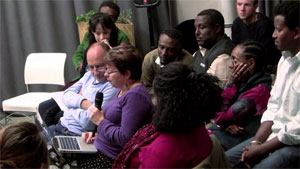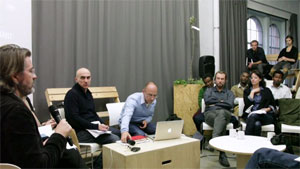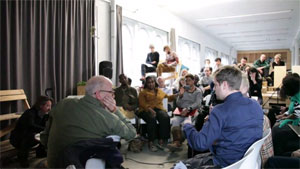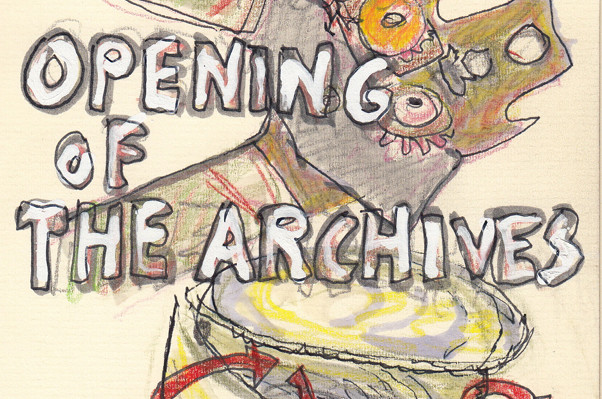22. November 2013 / Acting Archives, Marathon ⟶

Archives Works Marathon, Day 2, afternoon discussion
discussion with Elizabeth Giorgis, Salem Mekuria, Jochen Becker, Fasil Giorghis and other guests and participants at the end of the day
Diskussion mit Elizabeth Giorgis, Salem Mekuria, Jochen Becker, Fasil Giorghis und andere Gäste und Teilnehmern
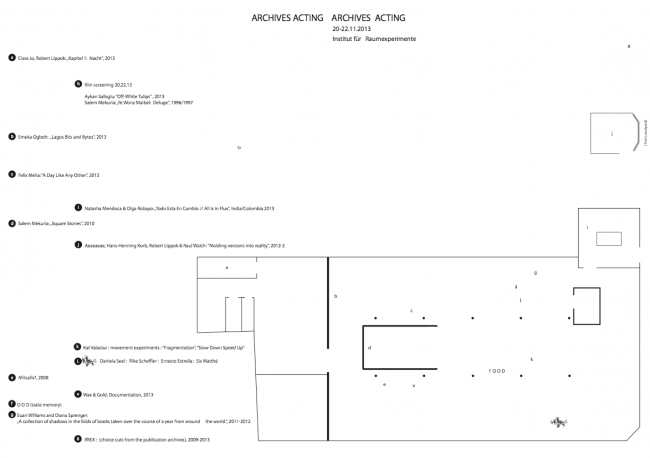
Archives Acting
Archives Acting is an exhibition curated on occasion of the Archives Works Marathon and hosted at the Institut für Raumexperimente and the Grey Sheep project housed at Studio Olafur Eliasson.
Archives Acting is choreographed by Eric Ellingsen and Christina Werner with contributions by Aeaeaeae, Hans-Henning Korb, Robert Lippok, and Raul Walch; Clara Jo and Robert Lippok; Salem Mekuria; Felix Melia; Natasha Mendonca and Olga Robayo; Netsa Art Village, Mihret Kebede, and Robel Temesgen; Emeka Ogboh; Elvira Dyangani Ose and Pere Ortín; Aykan Safoǧlu; Daniela Seel, Rike Scheffler, Ernesto Estrella, and Sis Matthé; Diana Sprenger and Euan Williams; and Kat Válastur.
Aeaeaeae, Hans-Henning Korb, Robert Lippok, and Raul Walch
Molding Versions into Reality, 2012-2013
Everything is knot together here. Everything hanging here comes from Ethiopia, even the things that come from China, and this is reality. This is the sound of reality snared and knotted together from stories and streets and markets and roundabouts in Addis Ababa. This is archive’s opposite, a moment of chaotic similarities. A sound installation as part of the Grey Sheep project.
Tainá Guedes, Asako Iwama, Lauren Maurer, and Lynn Peemoeller
f : O O D, 2013
Served in the context of the marathon days, these taste memory experiments, recipes, menus, and thoughts are provided by Tainá Guedes, Asako Iwama, Lauren Maurer, and Lynn Peemoeller. Menu designed by Thomas Meyer.
Clara Jo and Robert Lippok
24h Dahlem, Kapitel 1: Nacht, 2013
24h Dahlem centres on the controversial re-location of the ethnographic collections of the Dahlem Museums to the future site of the Humboldt Forum in Berlin’s city centre. Combining material from two archives within the Ethnological Museum and the Museum for Asian Art, the resulting large-scale video installations are presented in three chapters in the Dahlem Museum. 24h Dahlem was produced in the context of the Humboldt Lab Dahlem, a project of the German Federal Cultural Foundation and the Prussian Cultural Heritage Foundation.
Director: Clara Jo; sound design & audio archive composition: Robert Lippok; director of photography: Michael Laakmann
Felix Melia
A Day Like Any Other, 2013
A Day Like Any Other is a video work comprised of appropriated video and audio from the Aquis Bryant film Hood 2 Hood: The Blockumentary and Samuel Beckett’s Endgame. The video draws a comparison between the repetitive, cyclical nature of events in Beckett’s play and the similarly recurrent explanations and stories of ‘real’ life in Hood 2 Hood, stories that allude to the sedentary metaphysics and social immobility imposed upon its protagonists. The words ‘all day everyday’ literally encircle the imagery of the work. A commonly employed assertion within the appropriated footage, these words describe a refusal to give in, while highlighting the limited dynamic of the environments the protagonists inhabit.
Salem Mekuria
Ye Wonz Maibel: Deluge, 1996/1997
Ye Wonz Maibel: Deluge is a personal visual meditation on history, conflict, and the roads to reconciliation. It is a tale of love and betrayal, of idealism and the lure of power. It is a memorial to a brother who disappeared and a best friend, executed. It is a story of the Ethiopian students, their ‘revolution’, and its aftermath – a brutal military dictatorship. Ye Wonz Maibel: Deluge contemplates the role of the individual in perpetuating national tragedies – be that famine, war, or political terror – by re-visiting family tragedies in Ethiopia. Focusing on and searching through her own history, Mekuria sought personal experiences that illuminated universal truths. The film offers tools for reflection in order to look forward to a future in which responsibility and choice inform our conduct.
Salem Mekuria
Square Stories, 2010
Square Stories is a triptych video installation. Maskal Square (Revolution Square, or just ‘the Square’), located in the centre of Addis Ababa, Ethiopia, is a massive concrete expanse framed by permanent bleachers. It is the lowest point in the city: everything cascades into the Square. Everything big that happens in the city takes place there. The Square is also a site of commemoration, anchored by two museums that offer stable, corporealised narratives of the city and the nation. Square Stories offers a way of bearing witness to these multiple, fragmentary histories. It presents Maskal Square both as place and metaphor culled from a childhood in Addis Ababa and the gaze of an American art professor. The triptych format, which gestures to Ethiopia’s religious and cultural history, amplifies the contradictions within history, memory, and narration and interrogates the failure of any one story to stand in for the manifold subjectivities that comprise Ethiopian identity and history.
Writer/producer/videographer/director: Salem Mekuria; editor: Sarah B. Peck
Natasha Mendoca & Olga Robayo
Todo Esta En Cambio // All is in Flux, 2013
Todo Esta En Cambio navigates through sounds that seamlessly crisscross India and Colombia. This sonic journey takes us through the agrarian crisis and the consequences of the free trade treaty signed between India, Colombia, and the United States. The sound makes links between how food is produced in an industrialised world without consideration for the farmers, and how political leaders and corporations are leading the world to further environmental and socio-political disasters in the name of profit.
Netsa Art Village
Wax&Gold, 2013
Wax&Gold is a documentation of the Wax&Gold workshop for freedom of artistic expression that took place at Netsa Art Village and was accompanied by a touring exhibition in Addis Ababa, July 2012. Wax&Gold, a project developed and designed by Netsa Art Village and funded by the Prince Claus Fund, embraces the historical Ethiopian tradition of ‘Wax and Gold’, an approach involving indirect methods of communication, a strong form of expression in Ethiopian literature called ‘Qinie’, which obscures and protects the main message, the ‘Gold’, by covering it with ‘Wax’.
Presented by Mihret Kebede & Robel Temesgen.
Emeka Ogboh
Lagos Bits and Bytes, 2013
An electro-acoustic exploration of a bustling amphitheatre of sounds, a sprawling metropolis, and an aspiring megalopolis – Lagos, Nigeria. This is an excerpt from a Lagos soundscapes project, an acoustic enquiry into the mega-city focused on capturing sounds that define the unique character of Lagos and reflect the city’s diversity.
Elvira Dyangani Ose & Pere Ortín
Africalls?, 2008
Africalls? is a documentary film that shows the work of five artists and two production centres of contemporary art in seven African cities. It shows the interests that motivate them and the urban context from which they create their artworks. Africalls? approaches these artists’ work from an unusual perspective, exploring their personalities and creative processes as well as the art objects they make in Dakar, Douala, Cape Town, Rabat, Luanda, Nairobi, and Maputo. Africalls? is an audiovisual journey through the contemporary art of an urban Africa: both cosmopolitan and little-known, local and global.
Curator: Elvira Dyangani Ose; director: Pere Ortín; producer: Vic Pereiró
Aykan Safoǧlu
Off-White Tulips, 2013
Off-White Tulips is a tribute to the US-American writer James Baldwin. In this dense video essay, the artist links Baldwin’s self-imposed exile in Turkey with his own biographical details and an exploration of his native country. With the help of old photographs, we follow the path through Istanbul equally of James Baldwin as much as of Aykan Safoǧlu and his family. The emphasis on both personal stories quickly begins to blur fact and fiction. Safoǧlu calls this form biomythography – a type of invented life story coined by the American writer and activist Audre Lord, who described herself as a ‘black lesbian feminist mother warrior poet’. Off-White Tulips looks at history from marginal perspectives in order to explore alternative interpretations of cultural artefacts and differences, queer politics and identity. It is concerned with black survival strategies in a white mainstream. The film was awarded the Oberhausen Grand Prize at the Short Film Festival in Oberhausen in 2013.
Daniela Seel, Rike Scheffler, Ernesto Estrella, and Sis Matthé
L-A-N-G-U-A-G-I-N-G, 2013
L-A-N-G-U-A-G-I-N-G is a series of writing experiments and spontaneous language swerves informed by a space of listening. For two days, four poets tweeted echoes of what they heard from a listening space in the context of the Archives Works Marathon. The tweets can be found under the Twitter handle @Raumexperimente.
Diana Sprenger and Euan Williams
A Collection of Shadows in the Folds of Books Taken over the Course of a Year from Around the World, 2011-2012
In the folds of books. Reproduced shadows. Heightening the ephemeral quality of a book as a physical entity. A movable and borderless publication. Free of obvious geographical and temporal marks, yet created out of the temporal and geographical relationship between a source of light, an object, and the moment in which a photo is taken. A merging of real shadows with represented ones. Past mixes with present, as northern hemisphere mixes with southern hemisphere.
Kat Válastur
Fragmentation, Slow Down, Speed Up (Sketches), 2013
Movement experiments developed and demonstrated by the artist to collectively test moving in and against time
Institut für Raumexperimente
A presentation of selected visual material from the archives of the Institut für Raumexperimente, 2009-2013.
Archives Acting ist eine Ausstellung, die anlässlich des Archives Works Marathons kuratiert wurde und im Institut für Raumexperiemente sowie dem Grey Sheep Projekt im Studio Olafur Eliasson gezeigt wird.
Archives Acting wurde von Eric Ellingsen und Christina Werner choreografiert und zeigt Beiträge von Aeaeaeae, Hans-Henning Korb, Robert Lippok, und Raul Walch; Clara Jo und Robert Lippok; Salem Mekuria; Felix Melia; Natasha Mendonca und Olga Robayo; Netsa Art Village, Mihret Kebede und Robel Temesgen; Emeka Ogboh; Elvira Dyangani Ose und Pere Ortín; Aykan Safoǧlu; Daniela Seel, Rike Scheffler, Ernesto Estrella und Sis Matthé; Diana Sprenger und Euan Williams sowie Kat Válastur.
Aeaeaeae, Hans-Henning Korb, Robert Lippok und Raul Walch
Molding versions into reality, 2012-2013
Alles hier ist miteinander verknotet. Alles was hier hängt kommt aus Äthiopien, sogar die Dinge die aus China kommen und das ist die Realität. Das ist der Klang der Realität, eingefangen und zusammengeknotet aus Geschichten und Straßen und Märkten und Kreisverkehren in Addis Abeba. Das ist das Gegenteil des Archivs, ein Moment chaotischer Ähnlichkeiten. Eine Klanginstallation als Teil des Grey Sheep Projektes.
Tainá Guedes, Asako Iwama, Lauren Maurer und Lynn Peemoeller
f : O O D, 2013
Diese leckeren Erinnerungsexperimente, Rezepte, Menüs und Ideen werden im Rahmen der Marathon-Tage von Tainá Guedes, Asako Iwama, Lauren Maurer und Lynn Peemoeller aufgetischt. Entwurf des Menüs von Thomas Meyer.
Clara Jo und Robert Lippok
24h Dahlem, Kapitel 1: Nacht, 2013
24h Dahlem positioniert sich rund um die kontroverse Umsiedelung der ethnografischen Sammlung aus den Museen Dahlem an ihren zukünftigen Ort, das Humboldt Forum im Stadtzentrum Berlins. Mit einer Mischung aus Materialien zweier Archive des Ethnologischen Museums und des Museums für Asiatische Kunst werden die daraus entstandenen großformatigen Videoinstallationen in drei Kapiteln in den Museen Dahlem gezeigt. 24h Dahlem wurde im Rahmen des Humboldt Lab Dahlem produziert, einem Projekt der Kulturstiftung des Bundes und der Stiftung Preußischer Kulturbesitz.
Regie: Clara Jo; Sounddesign & und Komposition der Audioarchive: Robert Lippok; Kamera: Michael Laakmann
Felix Melia
A Day Like Any Other, 2013
A Day Like Any Other verwendet Video- und Audiomaterial des Films Hood 2 Hood: The Blockumentary von Aquis Bryant und Samuel Becketts Endspiel. Das Video zieht einen Vergleich zwischen der sich wiederholenden, zyklischen Struktur der Ereignisse in Becketts Stück und den genauso repetitiven Erklärungen und Geschichten des „echten“ Lebens in Hood 2 Hood. Dies sind Geschichten, welche auf die immobile Metaphysik und soziale Unbeweglichkeit hinweisen, welche den Protagonisten auferlegt sind. Die Formulierung „den ganzen Tag, jeden Tag“ umschreibt wortwörtlich die Bildwelten dieses Werks. Als wiederholte Beteuerung innerhalb der appropriierten Filmelemente steht diese Formulierung für Weigerung nachzugeben während sie gleichzeitig die eingeschränkte Dynamik der Umgebung, in der die Protagonisten sich befinden, herausstellt.
Salem Mekuria
Ye Wonz Maibel: Deluge, 1996/1997
Ye Wonz Maibel: Deluge ist eine persönliche, visuelle Meditation über Geschichte, Konflikten und Wegen, die zur Versöhnung führen. Es ist eine Geschichte über Liebe und Betrug, Idealismus und die Verführung der Macht. Es ist ein Denkmal an einen Bruder der verschwand und einen besten Freund der exekutiert wird. Erzählt wird die Geschichte der äthiopischen Studenten, ihrer „Revolution“ und dem was darauf folgt – eine brutale Militärdiktatur. Ye Wonz Maibel: Deluge denkt über die Rolle des Individuums in bestehenden nationalen Tragödien nach – das können Hungersnöte, Kriege oder politischer Terror sein – indem Familientragödien in Äthiopien neu betrachtet werden. Mit suchendem Fokus auf ihre eigene Geschichte greift Mekuria, persönliche Erfahrungen auf, die universelle Wahrheiten aufscheinen lassen.
Salem Mekuria
Square Stories, 2010
Square Stories ist eine Videoinstallation im Tryptichon-Format. Der Maskal Square Platz (Revolution Square oder einfach auch “the square”) liegt im Zentrum von Addis Abeba, Äthiopien, und ist eine große Betonfreifläche, die von fest installierten Tribünen begrenzt ist. Der Platz ist der niedrigstgelegene Punkt der Stadt: Alles läuft auf den Square zu. Alle großen Ereignisse in der Stadt finden hier statt. Der Platz ist auch ein Ort für Erinnerung. Zwei Museen, die hier Orientierungspunkte bieten stehen für konstante, verkörperte Narrationen der Stadt sowie der Nation. Square Stories bietet einen Zugang, um Zeugnis für diese vielseitigen, fragmentierten Geschichten abzulegen. Der Maskal Square wird sowohl als Platz als auch als Metapher präsentiert. Das Triptychon-Format, das der religiösen und kulturellen Geschichte Äthiopiens entlehnt ist, unterstreicht die Widersprüchlichkeit, die der Geschichte, der Erinnerung und der Narration zugrunde liegen. Gleichzeitig unterstreicht es, dass seither keine einzelne Geschichte repräsentativ für die vielseitigen Subjektivitäten, aus denen die äthiopische Identität und Geschichte bestehen, einstehen konnte.
Autor/Produzent/Kamera/Regie: Salem Mekuria; Schnitt: Sarah B. Peck
Natasha Mendoca & Olga Robayo
Todo Esta En Cambio // All is in Flux, 2013
Todo Esta En Cambio navigiert durch Klänge, die Indien und Columbien nahtlos im Zickzack durchqueren. Diese Klangreise nimmt uns mit durch eine Landwirtschaftskrise und deren Auswirkungen auf das freie Handelsabkommen zwischen Indien, Kolumbien und den Vereinigten Staaten. Der Klang stellt Verbindungen zwischen der Nahrungsmittelproduktion in einer industrialisierten Welt her, wo Bauern nicht mit in Betracht gezogen werden, und der Art, auf die Politiker und Firmen im Namen des Profits die Welt in weitere umwelttechnische und sozio-politische Desaster führen.
Netsa Art Village
Wax&Gold, 2013
Wax&Gold ist eine Dokumentation des Wax&Gold Workshops für die Freiheit künstlerischen Ausdrucks, der im Netsa Art Village stattfand und von einer Wanderausstellung in Addis Abeba im Juli 2012 begleitet wurde. Wax&Gold, ein Projekt das vom Netsa Art Village entwickelt und gestaltet wurde, sowie vom Prince Claus Fonds mitgetragen wird, übernimmt die historische äthiopische Tradition des “Wax & Gold”. Dieser Ansatz umfasst indirekte Kommunikationsformen, eine in der äthiopischen Literatur starken Ausdrucksform namens “Qinie”, welche die zu transportierende Aussage gleichermaßen verschleiert als auch schützt. Das “Gold” wird hier mit “Wachs” überzogen.
Präsentiert von Mihret Kebede & Robel Temesgen.
Emeka Ogboh
Lagos Bits and Bytes, 2013
Ein elektroakustischer Erkundungsgang durch ein klangerfülltes Theater, eine lebendige Metropole und eine aufstrebende Megalopole – Lagos in Nigeria. Dies ist ein Ausschnitt aus einem Projekt, das mit den Klanglandschaften Lagos arbeitet und eine akustische Befragung der Megastadt ist. Der Fokus liegt dabei darauf, Klänge einzufangen, die den einzigartigen Charakter der Stadt Lagos bestimmen und die Diversität der Stadt widerspiegeln.
Elvira Dyangani Ose & Pere Ortín
Africalls?, 2008
Africalls? ist ein Dokumentationsfilm, der die Arbeit von fünf Künstlern und zwei Produktionszentren für zeitgenössische Kunst in sieben afrikanischen Städten zeigt. Africalls? thematisiert die Arbeiten dieser Künstler aus einer ungewöhnlichen Perspektive, zeigt ihre Persönlichkeiten und Kreativprozesse sowie Kunstwerke, die sie in Dakar, Douala, Kapstadt, Rabat, Luanda, Nairobi und Maputo schaffen. Africalls? ist eine audiovisuelle Reise durch die zeitgenössische Kunst eines urbanen Afrikas: Kosmopolitisch und wenig bekannt, lokal und global.
Kurator: Elvira Dyangani Ose; Regisseur: Pere Ortín; Produktion: Vic Pereiró
Aykan Safoǧlu
Off-White Tulips, 2013
Off-White Tulips ist ein Homage an den amerikanischen Autor James Baldwin. In einem dichten Videoessay verbindet der Künstler Baldwinds selbstauferlegtes Exil in der Türkei mit Details aus seiner eigenen Biografie und einem Blick auf sein Heimatland. Mithilfe alter Fotografien folgen wir James Baldwin und Aykan Safoǧlu und dessen Familie gleichermaßen durch Istanbul. Der Fokus auf die persönlichen Geschichten von beiden lässt Fakt und Fiktion schnell verschwimmen. Safoǧlu nennt diese Form Biomythografie – eine Form der fiktiven Lebensgeschichte, begründet von der amerikanischen Autorin Audre Lord, die sich selbst als “black lesbian feminist mother warrior poet” bezeichnet. Off-White Tulips blickt aus marginalisierten Perspektiven auf die Geschichte um daraus alternative Interpretationen kultureller Artefakte und Differenzen sowie von Queer Politik und Identität zu ziehen. Das Werk befasst sich mit schwarzen Überlebensstrategien innerhalb eines weißen Mainstreams. Der Film wurde mit dem Oberhausen Grand Prix beim Kurzfilm-Festival 2013 in Oberhausen ausgezeichnet.
Daniela Seel, Rike Scheffler, Ernesto Estrella, und Sis Matthé
L-A-N-G-U-A-G-I-N-G, 2013
L-A-N-G-U-A-G-I-N-G ist eine Serie aus Schreibexperimenten und spontanen Sprachnotizen, beeinflusst von einem “Zuhörort”. Zwei Tage lang tweeteten vier Dichter Echos dessen was sie an diesem Ort im Rahmen des Archives Works Marathon hörten. Ihre Tweets finden sich bei Twitter unter @Raumexperimente.
Diana Sprenger und Euan Williams
A Collection of Shadows in the Folds of Books Taken over the Course of a Year from Around the World, 2011-2012
Zwischen den Falten von Buchseiten. Reproduzierte Schatten. Eine Unterstreichung der flüchtigen Eigenschaften von Büchern als physischer Einheit. Eine bewegliche und grenzenlose Publikation. Frei von offensichtlichen geografischen und zeitlichen Zeichen und doch aus der zeitlichen und geografischen Beziehung zwischen einer Lichtquelle, einem Objekt und dem Moment des Fotografierens entstanden. Eine Vermischung von echten Schatten mit den repräsentierten Schatten. Die Vergangenheit vermischt sich mit der Gegenwart genauso wie sich die nördliche Hemisphäre mit der südlichen Hemisphäre vermischt.
Kat Válastur
Fragmentation, Slow Down, Speed Up (Entwürfe), 2013
Experimente zu Bewegung, die von der Künstlerin entwickelt und vorgeführt wurden um kollektiv Bewegung in und gegen die Zeit zu testen.
Institut für Raumexperimente
Präsentation von ausgewählten Bild- und Publikationsmaterialien aus dem Institutsarchiv von 2009-2013.
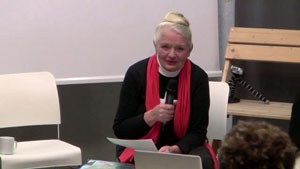
Louwrien Wijers
Louwrien Wijers speaks about her project for Museum Night in Amsterdam called Writing a Sculpture Void, which challenges preconceived notions of the relation between art, science, and spirituality. By talking about the work of several artists, scientists, spiritual leaders, she problematises our contemporary, mechanistic worldview and proposes that art practice is a possible way to discover new paradigms.
Synthesis
Museum Night in Amsterdam · George Brecht’s book: Void · Lots of wonderful coloured lines · Art Meets Science and Spirituality in a Changing Economy · Project: Writing a Sculpture Void · Ausklappen...
Museum Night in Amsterdam · George Brecht’s book: Void · Lots of wonderful coloured lines · Art Meets Science and Spirituality in a Changing Economy · Project: Writing a Sculpture Void · The way change takes place in art is very similar to the way change takes place in science · Revolutionary art signals a shift in paradigm · Giving up the idea of only a few people leading a pack of other people who are following · The art situation as a whole forms a network or a spiral · Works of art are always direct · Fritjof Capra’s The Tao of Physics · We no longer assume there is any real world with which we have to establish contact · The Heart Sutra: form is emptiness, emptiness is form · Enlightenment: a state beyond the uncontrolled, agitated, dissatisfied mind · Contemporary science teaches us that it is not a matter of fixed facts anymore but of dynamic systems, not of eternal truths but of dialogue · An artist can express human feelings · Art can come from inside or outside, but inside and outside are not different
Short biography
Louwrien Wijers, a writer and visual artist whose practice revolves specifically around sculpture, both mental and material. Ausklappen...
Louwrien Wijers, a writer and visual artist whose practice revolves specifically around sculpture, both mental and material. From 1968 to 1986, Wijers worked closely with Joseph Beuys to train herself to look at, write, and speak ‘like’ a sculpture. Wijers’ most important mental sculpture to date, titled Art Meets Science and Spirituality in a Changing Economy (1990/1996) is a direct result of a meeting of Joseph Beuys and the Dalai Lama she organised in Bonn in 1982. The influence of food on our future is now her main topic.
Louwrien Wijers spricht über ihr Projekt Writing a Sculpture Void für die Nacht der Museen in Amsterdam. Hierin stellt sie vorgefertigte Verständisse der Beziehung zwischen Kunst, Wissenschaft und Spiritualität in Frage. Durch eine Diskussion der Arbeit verschiedener Künstler, Wissenschaftler und religiöser Führer problematisiert sie unsere zeitgenössische mechanistische Weltsicht und stellt die These auf, dass künstlerische Praxis ein möglicher Weg ist, auf dem neue Paradigmen entdeckt werden können.
Synthese
Nacht der Museen in Amsterdam · George Brechts Buch: Void · Viele wunderbare bunte Linien · Art Meets Science and Spirituality in a Changing Economy · Projekt: Writing a Sculpture Void · Ausklappen...
Nacht der Museen in Amsterdam · George Brechts Buch: Void · Viele wunderbare bunte Linien · Art Meets Science and Spirituality in a Changing Economy · Projekt: Writing a Sculpture Void · Die Art, auf die Veränderung in der Kunst stattfindet, ist der Art auf die Veränderung in der Wissenschaft stattfindet sehr ähnlich · Revolutionäre Kunst signalisiert einen Paradigmenwechsel · Abschied von der Idee dass wenige eine Menge anleiten, die bloß folgt · Die Situation in der Kunst hat die Form eines Netzwerks oder einer Spirale · Kunstwerke sind immer direkt · Fritjof Capras’ The Tao of Physics · Wie nehmen nicht länger an, dass es irgendeine reale Welt gibt mit der wir in Kontakt treten müssen · Das Herz Sutra: Form ist Leere, Leere ist Form · Erleuchtung: Ein Zustand jenseits des unkontrollierten, ängstlichen und unzufriedenen Geistes · Zeitgenössische Wissenschaft lehrt uns, dass es nicht mehr um festgelegte Fakten geht sondern um ein dynamisches System, nicht um ewige Wahrheiten sondern um Dialog · Ein Künstler kann menschlichen Gefühlen Ausdruck verleihen · Kunst kann von Innen oder von Außen kommen, aber Innen und Außen unterscheiden sich nicht
Kurzbiografie
Louwrien Wijers, Autorin und bildende Künstlerin, deren Arbeitsweisen sich im Bereich mentaler und materieller Bildhauerei abspielen. Ausklappen...
Louwrien Wijers, Autorin und bildende Künstlerin, deren Arbeitsweisen sich im Bereich mentaler und materieller Bildhauerei abspielen. Von 1968 bis 1986 arbeitete Wijers eng mit Joseph Beuys zusammen, um Skulptur zu betrachten und "wie eine Skulptur" zu schreiben und sprechen. Wijers wichtigste gedankliche Skulptur ist bis heute unter dem Titel Art Meets Science and Spirituality in a Changing Economy (1990/1996) bekannt und ein direktes Ergebnis des Treffens zwischen Joseph Beuys und dem Dalai Lama, das sie 1982 in Bonn organisierte. Ihr Hauptthema ist aktuell der Einfluss von Nahrungsmitteln auf unsere Zukunft.
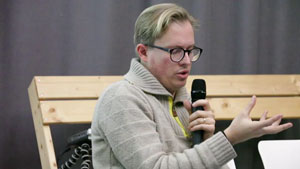
Nicola Setari
Nicola Setari discusses the issues surrounding the work he did for Visionary Africa and his collaboration with architect David Adjaye on GEO-Graphics. The presentation focuses on the itinerancy of Visionary Africa in different African capitals and on the many questions surrounding the representation of African culture within contemporary European institutions. Setari discusses the controversial notion of cultural restitution between European and African countries as well as the politics of working with existing ethnographic collections in Europe.
Synthesis
Visionary Africa · Bruno Latour · Iconoclash: Beyond the Image Wars in Science, Religion, and Art · The whole question of iconoclasm in contemporary culture has been a theme of reflection and investigation · Ausklappen...
Visionary Africa · Bruno Latour · Iconoclash: Beyond the Image Wars in Science, Religion, and Art · The whole question of iconoclasm in contemporary culture has been a theme of reflection and investigation · Brussels: BOZAR Centre for Fine Arts and the Tervuren Museum · An opportunity to reflect on the problem of relations between European museums, ethnographic museums, and the African continent · On one side there was the theme of heritage and on the other side there was the question of visual stereotypes · British-Ghanaian architect, David Adjaye · Book: African Metropolitan Architecture – fifty-four capitals are reorganised according to climate zones on the continent, therefore liberating them of their national identity · The Atlas Research Project: a timeline mapping a hundred years of the evolution of policies on the management of culture on the African continent · GEO-Graphics: part of the bigger project Visionary Africa · Two main exhibitions: GEO-Graphics and A Useful Dream · Using colour codes and labels to decontextualise national identity
Short biography
Nicola Setari, researcher, curator, editor, and professor of visual anthropology at the Milan New Fine Arts and Design Academy. Ausklappen...
Nicola Setari, researcher, curator, editor, and professor of visual anthropology at the Milan New Fine Arts and Design Academy. He was an agent of dOCUMENTA (13) in Kassel, Germany, contributing to the artistic and educational programme. He also co-edited part of the dOCUMENTA (13) catalogue – The Logbook (2012). Between 2006 and 2009, he was editor-in-chief and publisher of the cross-disciplinary art magazine Janus. In 2010 and 2011, he was co-curator of the Visionary Africa platform for the Centre for Fine Arts in Brussels and co-editor of David Adjaye’s GEO-Graphics: A Map of Art Practices in Africa, Past and Present (2010).
Nicola Setari thematisiert und diskutiert Visionary Africa und seine Zusammenarbeit mit dem Architekten David Adjaye für GEO-Graphics. Die Präsentation konzentriert sich auf die Reisen von Visionary Africa in verschiedene afrikanische Hauptstädte und auf die vielen Fragen rund um Repräsentationen afrikanischer Kultur durch zeitgenössische europäische Institutionen. Setari diskutiert kontroverse Zusammenhänge der kulturellen Entschädigung zwischen europäischen und afrikanischen Ländern sowie den Umgang mit ethnografischen Sammlungen in Europa.
Synthese
Visionary Africa · Bruno Latour · Iconoclash: Beyond the Image Wars in Science, Religion, and Art · Die Frage des Ikonoklasmus in der zeitgenössischen Kultur war eine Frage des Nachdenkens und Nachforschens · Ausklappen...
Visionary Africa · Bruno Latour · Iconoclash: Beyond the Image Wars in Science, Religion, and Art · Die Frage des Ikonoklasmus in der zeitgenössischen Kultur war eine Frage des Nachdenkens und Nachforschens · Brüssel: BOZAR Centre for Fine Arts und das Tervuren Museum · Eine Gelegenheit über Probleme in den Beziehungen zwischen europäischen Museen, ethnografischen Museen und dem afrikanischen Kontinent nachzudenken · Einerseits Thema Kulturerbe und andererseits die Frage nach visuellen Stereotypen · British-Ghanaischer Architekt, David Adjaye · Buch: African Metropolitan Architecture – 54 Hauptstädte werden entsprechend den Klimazonen des Kontinentes neu geordnet und so von ihrer nationalen Identität befreit · The Atlas Research Project: Ein Zeitstrahl der Überblick gibt über die hundertjährige Evolution von Kulturmanagementpolitik auf dem afrikanischen Kontinent · GEO-Graphics: Teil des größeren Projektes Visionary Africa · Zwei große Ausstellungen: GEO-Graphics und A Useful Dream · Verwendung von Farbcodes und Etiketten zur Dekonstruktion nationaler Identität
Kurzbiografie
Nicola Setari, Kurator, Redakteur und Professor für visuelle Anthropologie an der New Fine Arts and Design Academy in Mailand. Ausklappen...
Nicola Setari, Kurator, Redakteur und Professor für visuelle Anthropologie an der New Fine Arts and Design Academy in Mailand. Er war ein Agent der dOCUMENTA (13) in Kassel und trug zum künstlerischen Programm und zum Bildungsprogramm bei und zum Documenta-Katalog The Logbook (2012) bei. Zwischen den Jahren 2006 und 2009 war er Chefredakteur des interdisziplinären Kunstmagazins Janus. In den Jahren 2010 und 2011 war er Co-Kurator der Platform Visionary Africa am Centre for Fine Arts in Brüssel und Mitherausgeber von David Adjayes GEO-Graphics: A Map of Art Practices in Africa, Past and Present (2010).
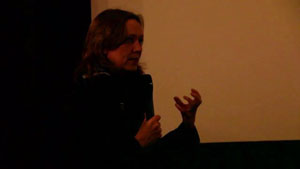
Stefanie Schulte Strathaus
Stefanie Schulte Strathaus presents the history of the Arsenal Institute for Film and Video Art, its beginnings as an institution, and the need for such an institution in Berlin. Several issues are raised in discussion about the politics of maintaining a film archive, especially in relation to its own collection and to the city that houses it. Two projects are highlighted, The Living Archive and The Visionary Archive, collaborations that have resulted from projects with a number of practitioners and other archives from around the world.
Synthesis
Arsenal Institute for Film and Video Art • Berlin Film Festival • Archive of 10,000 films • The films in Arsenal’s archive have only one purpose: to be shown • Anthology Film Archives in New York • Ausklappen...
Arsenal Institute for Film and Video Art • Berlin Film Festival • Archive of 10,000 films • The films in Arsenal’s archive have only one purpose: to be shown • Anthology Film Archives in New York • Started as association called Freunde der Deutsche Kinemathek • No alternative cinema in Germany in the 60s • An important aspect of Arsenal was the combination of film history with contemporary film practice • Lionel Rogosim – film Come Back Africa: the first film in the archive, the basis of the collection and the beginning of distribution • Michael Verhoeven – film OK • The start of the Forum of Young Cinema • International films first collected at the initiative of the festival to subtitle them • Films sent from countries under military dictatorships • What to do with old print vs. DVD? • Old prints get vinegar syndrome • Too costly to digitise everything • Films are not categorised in the collection • The Living Archive project • Many of the films exist only in this collection • Archive as a practice: archiving films, curating films, restoring films, showing films • Opening an archive is not threatening an archive • Avi Mograbi and Angela Melitopoulos in The Living Archive project • The Visionary Archive • Attempting to run an institution without being an institution • Erika and Ulrich Gregor are still part of Arsenal • Preserving the memory of the institution itself • The Living Archive attracted partners from other countries • Filmmaker Gadalla Gubara • Guinea Bissau and Egypt forming film archives • The Visionary Archive works with these emerging archives • Restoration also part of the institution’s work
Short biography
Stefanie Schulte Strathaus, film and video curator, co-director of the Arsenal Institute for Film and Video Art, member of the selection committee of the Berlinale Forum, Ausklappen...
Stefanie Schulte Strathaus, film and video curator, co-director of the Arsenal Institute for Film and Video Art, member of the selection committee of the Berlinale Forum, and founding director of Forum Expanded, a section of the Berlin International Film Festival that negotiates the boundaries of cinema. Her curatorial work comprises numerous film programmes, retrospectives, and exhibitions, among them The Living Archive – Archive Work as a Contemporary Artistic and Curatorial Practice.
Stefanie Schulte Strathaus stellt die Geschichte des Arsenal – Institut für Film und Videokunst vor und spricht über die Notwendigkeit einer solchen Institution in Berlin. Die Diskussion berührt folgende Aspekte: die politischen Rahmenbedingungen für die Pflege eines Filmarchivs, die Bedeutung der eigenen Filmsammlung und die Rolle des Archivs für die Stadt Berlin. Zwei Projekte werden insbesondere erwähnt, The Living Archive und The Visionary Archive; beide involvieren Beteiligte und verschiedene andere Archive weltweit.
Synthese
Arsenal Institute for Film and Video Art • Berlinale • Archiv mit 10,000 Filmen • Die Filme im Archiv des Arsenal haben nur einen einzigen Zweck: Gezeigt zu werden • Anthology Film Archives in New York • Ausklappen...
Arsenal Institute for Film and Video Art • Berlinale • Archiv mit 10,000 Filmen • Die Filme im Archiv des Arsenal haben nur einen einzigen Zweck: Gezeigt zu werden • Anthology Film Archives in New York • Entwickelte sich aus einem Verband namens Freunde der Deutsche Kinemathek • In den 1960er Jahren gab es kein alternatives Kino in Deutschland • Wichtiger Aspekt des Arsenal war die Kombination aus Filmgeschichte mit zeitgenössischen Filmpraktiken • Lionel Rogosim – Film Come Back Africa: Erster Film im Archiv, Grundlage der Sammlung und Ausgangspunkt des Vertriebs • Michael Verhoeven – Film OK • Beginn des Forum of Young Cinema • Internationale Filme wurden zuerst auf Initiative des Festivals gesammelt um sie mit Untertiteln zu versehen • Filme aus Ländern mit Militärzensur erhalten • Was tun mit alten Filmrollen vs. DVD? • Alte Filme bekommen Essig-Syndrom • Zu kostspielig alles zu digitalisieren • Filme in der Sammlung sind nicht kategorisiert • The Living Archive Projekt • Viele Filme existieren nur in der Sammlung • Archive als Praxis: Filme archivieren, kuratieren, restaurieren und zeigen • Ein Archiv eröffnen ist keine Bedrohung für Archive • Avi Mograbi und Angela Melitopoulos im The Living Archive Projekt • The Visionary Archive • Versuch eine Institution zu führen ohne eine Institution zu sein • Erika und Ulrich Gregor sind immer noch Teil des Arsenal • Das Andenken an die Einrichtung selbst erhalten • The Living Archive lockt Partner aus anderen Ländern an • Filmemacher Gadalla Gubara • Guinea Bissau und Ägypten begründen Filmarchive • The Visionary Archive arbeitet mit diesen entstehenden Archiven • Restauration ist auch Teil der Arbeit des Archivs
Kurzbiografie
Stefanie Schulte Strathaus, Film- und Videokuratorin, Co-Direktorin des Arsenal - Institut für Film- und Videokunst, Mitglied des Auswahlkommittees des Berlinale Forums Ausklappen...
Stefanie Schulte Strathaus, Film- und Videokuratorin, Co-Direktorin des Arsenal - Institut für Film- und Videokunst, Mitglied des Auswahlkommittees des Berlinale Forums und Gründerin und Leiterin des Forum Expanded, einem Bereich des Berlin International Film Festivals, der die Grenzen des Kinos auslotet. Ihre kuratorische Arbeit umfasst zahlreiche Filmprogramme, Retrospektiven und Ausstellungen, unter anderem The Living Archive – Archive Work as a Contemporary Artistic and Curatorial Practice.
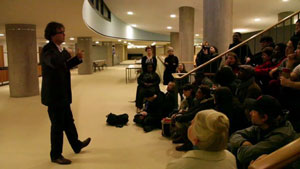
Bernd Scherer
Bernd Scherer presents a brief history of the Haus der Kulturen der Welt (HKW) and speaks of the different projects that the HKW is producing in collaboration with curators, artists, and other practitioners from around the world. The discussion focuses on the role that the HKW has played and how it is reconfiguring itself for the future.
Synthesis
HKW was a gift from the United States to the city of Berlin in 1957 • A symbolic locale in Cold War Berlin • First sign of the West when crossing over from East Berlin • Ausklappen...
HKW was a gift from the United States to the city of Berlin in 1957 • A symbolic locale in Cold War Berlin • First sign of the West when crossing over from East Berlin • Criticism that the HKW was a realm or space defined by the ‘exotic’ • It also played a transmitter role for quite a number of intellectuals and artists • Post-colonial discourse – Homi K. Bhabha, Okwui Enwezor, the Short Century • The Black Atlantic with Paul Gilroy • Third phase of the HKW seeks to encourage an interaction between local and global discourse • What is art, and what are art institutions doing? • The reconceptualisation of the HKW • Global Prayers – working together with academics, artists, and cultural and social activists in cities such as Berlin, Rio de Janeiro, Lagos, Beirut, Istanbul, and Mumbai • Processes of modernisation and secularisation involve removing religion from the picture • 80 researchers in these cities, with different artists • Artist Aernout Mik • The border between scientific and artistic approaches • German Research Foundation (DFG) starting to support workshops in order to develop a conceptual approach to these issues • Whole Earth • How counterculture transforms into big business • After Year Zero • Cultural and political movements in the non-western world
Short biography
Bernd Scherer, director of the Haus der Kulturen der Welt (HKW), holds a doctoral degree in philosophy from the Universität des Saarlandes Ausklappen...
Bernd Scherer, director of the Haus der Kulturen der Welt (HKW), holds a doctoral degree in philosophy from the Universität des Saarlandes and is the author of several publications focusing on aesthetics and international cultural exchange. Previously, he headed the Department of Humanities and Culture at the HKW and has also served as its Deputy Director. He served as Director of the Goethe Institute Mexico from 1999 through 2004 and subsequently as Director of the Arts Department at the Goethe Institute’s headquarters in Munich.
Bernd Scherer spricht über die Geschichte des Haus der Kulturen der Welt (HKW) und verschiedene Projekte die das HKW in Zusammenarbeit mit Kuratoren, Künstlern und anderen internationalen Teilnehmern produziert. Die Diskussion konzentriert sich auf die Rolle des HKW in der Vergangenheit und wo es sich zukünftig sieht.
Synthese
HKW war ein Geschenk der USA an die Stadt Berlin im Jahr 1957 • Ein symbolischer Ort im Berlin des kalten Krieges • Erstes Zeichen des Westens wenn man aus Ostberlin kam • Ausklappen...
HKW war ein Geschenk der USA an die Stadt Berlin im Jahr 1957 • Ein symbolischer Ort im Berlin des kalten Krieges • Erstes Zeichen des Westens wenn man aus Ostberlin kam • Kritik am HKW als Ort, der auf das Exotische setzt • Spielte eine Vermittlerrolle für Intellektuelle und Künstler • Postkolonialer Diskurs – Homi K. Bhabha, Okwui Enwezor • The Short Century • The Black Atlantic mit Paul Gilroy • Dritte Phase des HKW hat zum Ziel, einen Austausch zwischen dem Globalen und dem Lokalen zu ermöglichen • Was ist Kunst und was tun Kunsteinrichtungen? • Global Prayers – Zusammenarbeit mit Wissenschaftlern, Künstlern sowie kulturellen und sozialen Aktivisten in Städten wie Berlin, Rio de Janeiro, Lagos, Beirut, Istanbul und Mumbai • Modernisierungsprozesse und Säkularisierung haben zu Folge, dass die Religion aus dem Blickwinkel verschwindet • 80 Forscher und Künstler in diesen Städten • Künstler Aernout Mik • Die Grenze zwischen wissenschaftlichem und künstlerischem Ansatz • Deutsche Forschungsgemeinschaft beginnt Workshops zu unterstützen um einen konzeptuellen Ansatz zu diesen Fragen zu entwickeln • Whole Earth • Wie verwandelt sich eine kulturelle Opposition in "Big Business"?• After Year Zero • Kulturelle und politische Bewegungen außerhalb der westlichen Welt
Kurzbiografie
Bernd Scherer, Leiter des Haus der Kulturen der Welt erhielt seinen Doktor in Philosophie von der Universität des Saarlandes Ausklappen...
Bernd Scherer, Leiter des Haus der Kulturen der Welt erhielt seinen Doktor in Philosophie von der Universität des Saarlandes und ist Autor mehrerer Publikationen zu Ästhetik und internationalem kulturellen Austausch. Zuvor leitete er die Abteilung für Geisteswissenschaften und Kultur am HKW und war stellvertretender Leiter des Hauses. Von 1999 bis 2004 leitete er das Goethe Institut Mexiko und arbeitete danach als Leiter der Abteilung für Kunst in der Zentrale des Goethe-Institutes in München.
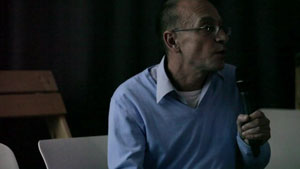
Georges Pfruender
Georges Pfruender explores several issues concerning archives today and their role within society in general, especially in relation to issues such as ethics, colonisation, apartheid in South Africa, the decolonisation of the self, ‘white nostalgia’, and methodological pluralism.
Synthesis
Art institutions as separate entities from universities • The apartheid archives • Revisiting the idea of the archive • Archives command and have their own authority • Ausklappen...
School of Arts at the University of the Witwatersrand • Art institutions as separate entities from universities • The apartheid archives • Revisiting the idea of the archive • Archives command and have their own authority • The archives in South Africa must be visited from that point of view • Who are the archivists? Under what conditions is the archiving processes happening? • How are these archives made available to the public? • Artist William Kentridge • Hesitation around archives • Jacques Derrida - instead of being something solid, the archive should be something that holds us, something unsolved, something that needs to be addressed • Ethics are a core part in whatever we think about archives • An archive not re-performed is not a real archive • ‘White nostalgia’ - an interesting way to think around apartheid archives • Archives have agency and are not innocent things • Decolonisation is not necessarily an act that happens on a territory • How do we decolonise ourselves? • Collective memories and alternative subject positions • Methodological pluralism • Researchers should also be transformed by this process • Jeppe Street – Johannesburg • Difficult to be a migrant in an unstable setting • The sharing of stories, the exchanges of stories
Short biography
Georges Pfruender, head of the Wits School of Arts at the University of the Witwatersrand, Johannesburg, from 2009 to 2013. Ausklappen...
Georges Pfruender, head of the Wits School of Arts at the University of the Witwatersrand, Johannesburg, from 2009 to 2013. From 1996 to 2009, he directed the Institute of Fine Arts, Ecole Cantonale d’Art du Valais (ECAV) in Switzerland, and he was president of the Swiss National Board of Art and Design from 2004 and 2008. As an artist and researcher, he has participated in conferences, panels, and residency programmes in Europe, North and South America, Africa, and Asia, and is presently coordinating collective art projects in collaboration with Cynthia Kros that involve researchers from South Africa, Ethiopia, and France.
Georges Pfruender untersucht verschiedene Aspekte heutiger Archive und deren Rolle innerhalb der Gesellschaft. Insbesondere betrachtet er dabei die Beziehung zu Themengebieten wie Ethik, Kolonialisierung, Apartheid in Südafrika, Dekolonialisierung des Selbst, „weiße Nostalgie“ und methodologischer Pluralismus.
Synthese
Kunstinstitutionen als von Universitäten unabhängige Einheiten • Neubetrachtung des Apartheid-Archivs • Archive haben ihre eigene Autorität • Ausklappen...
Kunstinstitutionen als von Universitäten unabhängige Einheiten • Neubetrachtung des Apartheid-Archivs • Archive haben ihre eigene Autorität • Archive in Südafrika müssen von dieser Perspektive aus betrachtet werden • Wer sind die Archivare? Unter welchen Bedingungen laufen Archivierungsprozesse ab? • Wie werden Archive der Öffentlichkeit zugänglich gemacht? • Künstler William Kentridge • Zögern beim Thema Archive • Jacques Derrida – statt statisch zu sein, sollte das Archiv etwas sein das uns trägt, etwas ungelöstes, etwas das thematisiert werden muss • Ethik steht im Zentrum des Nachdenkens über Archive • Ein Archiv das nicht aktiviert wird ist kein echtes Archiv • ‘Weiße Nostalgie’ – eine interessante Betrachtungsweise des Apartheid-Archivs • Archive haben Handlungsmacht und sind keine unschuldigen Dinge • Dekolonialisierung ist nicht etwas das nur auf einem bestimmten Gebiet passiert • Wie dekolonisieren wir uns selbst? • Kollektive Erinnerungen und alternative Subjektpositionen • Methodologischer Pluralismus • Forscher sollen von diesem Prozess verändert werden • Jeppe Street – Johannesburg • Schwierig, Migrant in einer instabilen Situation zu sein • Teilen und Austausch von Geschichten
Kurzbiografie
Georges Pfruender, Leiter der Wits School of Arts an der University of the Witwatersrand, in Johannesburg von 2009 bis 2013. Ausklappen...
Georges Pfruender, Leiter der Wits School of Arts an der University of the Witwatersrand, in Johannesburg von 2009 bis 2013. Zwischen 1996 und 2009 leitete er das Institut für bildende Kunst an der Ecole Cantonale d’Art du Valais (ECAV) in der Schweiz und war von 2004 bis 2008 Vorsitzender des Schweizer Rat für Kunst und Design. Als Künstler und Wissenschaftler nahm er an Konferenzen, Talks und Residencyprogrammen in Europa, Nord- und Südamerika, Afrika und Asien teil. Aktuell koordiniert er ein kollektives Kunstprojekt in Zusammenarbeit mit Cynthia Kros mit Forschern und Wissenschaftlern aus Südamerika, Äthiopien und Frankreich.
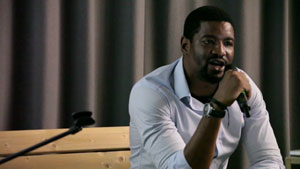
Emeka Obgoh
Emeka Ogboh presents work from the past few years in which he explores the soundscape of Lagos, Nigeria, by recording the sounds of the city and using this documentation as raw material for his installations. Lagos is a city under continuous change, and his artworks document these changes through the soundscape of the city.
Synthesis
Sound practice in relation to the city – Lagos • Documentation similar to archiving • 21 million people living in this 1000 kilometer-square space • The city is currently undergoing changes • Ausklappen...
Sound practice in relation to the city – Lagos • Documentation similar to archiving • 21 million people living in this 1000 kilometer-square space • The city is currently undergoing changes • Started working on sound in Lagos in 2008 • Each city’s sound is really unique • There are no sound regulations • Ongoing sound project that explores Lagos as a vibrant African megacity • The lack of total silence in the city • The city as a composer: it composes the piece; Ogboh only documents • Various installations around Europe, experimenting with how non-Nigerians experience and react to the soundscape of Lagos • The city’s infrastructure is being updated to be more like European cities • The soundscape of the city is changing • Incorporating the Lagos bus driver, especially in the soundscape recording and installations; using the bus as an element for the installation • Working with composers to take sounds from Lagos and make music with it
Short biography
Emeka Ogboh, Nigerian artist with broad focuses on the notions of listening and hearing and who works primarily with sound and video to understand cities as cosmopolitan spaces with unique characters. Ausklappen...
Emeka Ogboh, Nigerian artist with broad focuses on the notions of listening and hearing and who works primarily with sound and video to understand cities as cosmopolitan spaces with unique characters. His sound recordings also consider the history and aural infrastructure of cities, in particular Lagos, Nigeria, where he currently resides. These Lagos recordings have produced a corpus of work entitled Lagos Soundscapes, which he has variously installed in different foreign contexts. A graduate of the Department of Fine and Applied Arts, University of Nigeria, Nsukka, Ogboh has exhibited in several venues in Nigeria and internationally, including at the Centre for Contemporary Art, Lagos; Menil Collection, Houston; Whitworth and Manchester city galleries; MASS MoCA, Massachusetts; Kiasma Museum of Contemporary Art, Helsinki; and Rautenstrauch-Joest-Museum, Cologne. Ogboh is a 2014 recipient of a DAAD grant and the co-founder of the Video Art Network Lagos.
Emeka Ogboh stellt Arbeiten der letzten Jahre vor in denen er sich mit der Klanglandschaft von Lagos, Nigeria auseinandersetzt. Seine Tonaufnahmen dienen ihm als Rohmaterial für Installationen. Lagos ist eine Stadt die sich ständig verändert und seine Kunstwerke dokumentieren die Veränderungen anhand der Klanglandschaft der Stadt.
Synthese
Klangarbeit in Bezug zu Stadt – Lagos • Dokumentation ähnlich wie Archivieren • 21 Millionen Menschen leben auf diesem 1000 Quadratmeter großen Raum • Die Stadt verändert sich momentan • Ausklappen...
Klangarbeit in Bezug zu Stadt – Lagos • Dokumentation ähnlich wie Archivieren • 21 Millionen Menschen leben auf diesem 1000 Quadratmeter großen Raum • Die Stadt verändert sich momentan • Begann im Jahr 2008 mit Klang zu Lagos zu arbeiten • Der Klang jeder Stadt ist einzigartig • Es gibt keine Klangregulationen • Ein fortlaufendes Soundprojekt das Lagos als lebendige afrikanische Megacity entdeckt • Die Abwesenheit völliger Stille in der Stadt • Die Stadt als Komponist: Sie komponiert das Stück, Ogboh dokumentiert nur • Verschiedene Installationen in Europa, experimentieren mit dem Erleben und der Reaktion auf Lagos Klangkulisse durch Nicht-Nigerianer • Die Infrastruktur der Stadt wird aktualisiert in die Richtung europäischer Städte • Die Klangkulisse der Stadt verändert sich • Einbeziehen der Busfahrer in Lagos, besonders für die Aufnahmen der Klangkulisse und Installationen, Nutzung des Busses als Installationsobjekt • Arbeit mit Komponisten um Klänge aus Lagos in Musik zu verarbeiten
Kurzbiografie
Emeka Ogboh, nigerianischer Künstler, der sich mit Hören und Zuhören auseinandersetzt. Er arbeitet hauptsächlich mit Sound und Video, Ausklappen...
Emeka Ogboh, nigerianischer Künstler, der sich mit Hören und Zuhören auseinandersetzt. Er arbeitet hauptsächlich mit Sound und Video, um Städte als kosmopolitische Orte mit einzigartigem Charakter zu untersuchen. In seinen Soundaufnahmen beschäftigen er sich mit der Geschichte und der akustischen Infrastruktur von Städten, insbesondere seinem aktuellen Wohnort Lagos, Nigeria. Die Aufnahmen aus Lagos wurden als Werkserie mit dem Titel Lagos Soundscapes in verschiedenen Zusammenhängen präsentiert. Als Absolvent der Fakultät für bildende und angewandte Kunst der University of Nigeria, Nsukka, hat Ogboh in verschiedenen internationalen und nigerianischen Institutionen ausgestellt, unter anderem dem Centre for Contemporary Art in Lagos, der Menil Collection in Houston, den Whitworth and Manchester City Galleries, MASS MoCA in Massachusetts, dem Kiasma Museum of Contemporary Art in Helsinki und dem Rautenstrauch-Joest-Museum in Köln. Ogboh ist Mitbegründer des Video Art Network Lagos und erhielt im Jahr 2014 ein Stipendium des DAAD.
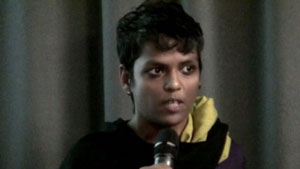
Natasha Mendonca
Natasha Mendonca presents her work and explores her different approaches to investigating the relation between life and art, especially through non-orthodox art practices and a queer political standpoint.
Synthesis
Colonisation of India • England and Portugal • Difficulties of being raised Catholic in India • Not learning about one’s own culture • Cultural schisms • Growing up queer and Catholic in India • Ausklappen...
Colonisation of India • England and Portugal • Difficulties of being raised Catholic in India • Not learning about one’s own culture • Cultural schisms • Growing up queer and Catholic in India • The creation of a festival to explore issues of gender and sexuality • Facing problems with the law for running such a festival • Political activism • Understanding the world through art • Travelling to other cultures to find links • Healing through collective experience • Relating cultural experiences from other countries • Working with food as art practice • Questioning the white cube experience • Colonisation from different perspectives • Art that explores the concept of archive
Natasha Mendonca präsentiert ihre Arbeit und spricht über ihre unterschiedlichen Ansätze zur Erforschung der Beziehung zwischen Leben und Kunst – insbesondere mit unorthodoxen Kunstpraktiken und einer queeren politischen Haltung.
Synthese
Kolonialisierung Indiens • England und Portugal • Die Probleme einer katholischen Erziehung in Indien • Nichts über die eigene Kultur lernen • Kulturspaltung • Queer und katholisch in Indien aufwachsen • Ausklappen...
Kolonialisierung Indiens • England und Portugal • Die Probleme einer katholischen Erziehung in Indien • Nichts über die eigene Kultur lernen • Kulturspaltung • Queer und katholisch in Indien aufwachsen • Ein Festival schaffen das Fragen nach Gender und Sexualität thematisiert • Rechtliche Probleme die mit der Schaffung dieses Festival auftauchen • Politischer Aktivismus • Die Welt durch Kunst verstehen • In andere Kulturen reisen um Verbindungen zu finden • Heilung durch kollektive Erfahrung • Kulturelle Erfahrungen aus anderen Ländern zuordnen • Arbeit mit Essen als künstlerische Praxis • Die White Cube Erfahrung hinterfragen • Kolonialisierung aus verschiedenen Perspektiven • Kunst, die das Archivkonzept untersucht
Kurzbiografie
Natasha Mendonca, Filmemacherin und bildende Künstlerin. Trotz der strengen indischen Zensurgesetze gegen Homosexualität, war sie 2013 Mitbegründerin von Larzish, Ausklappen...
Natasha Mendonca, Filmemacherin und bildende Künstlerin. Trotz der strengen indischen Zensurgesetze gegen Homosexualität, war sie 2013 Mitbegründerin von Larzish, dem ersten internationalen indischen Film- und Videofestival, zu den Themen Sexualität und Gender in Bombay. Ihre vorhergegangene Arbeit Jan Villa wurde 2011 mit dem Tiger Award des International Film Festivals in Rotterdam ausgezeichnet sowie unter anderem auch 2011 zum Besten Film der Experimenta in Indien gewählt. Ihr erster Spielfilm Ajeeb Aashiq beschäftigt sich mit Aspekten von Gender, Arbeit und Klasse in Bombay. Der Film wurde 2011 von der Hubert Bals Stiftung unterstützt und als Beitrag für Open Doors beim Locarno Film Festival im Jahr 2011 ausgewählt.
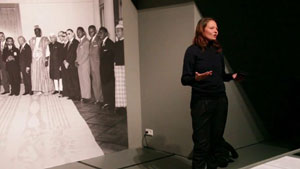
Doreen Mende
Doreen Mende presents her work related to the Travelling Communiqué project in collaboration with the Haus der Kulturen der Welt (HKW) and the Museum of Yugoslav History. This work focuses on photo archives, including the presidential press service archive of Tito. The project, which explores the Yugoslav perspective on the Non-Aligned Movement, raises many issues, such as globalisation, politics of inclusion, the use of images in political movements, and colonialism.
Synthesis
Travelling Communiqué • HKW • Long-term, collaborative research project • Artist Milica Tomić • Museum of Yugoslav History • The presidential press service archive of Tito • The Otolith Group • Ausklappen...
Travelling Communiqué • HKW • Long term, collaborative research project • Artist Milica Tomic • Museum of Yugoslav History • The presidential press service archive of Tito • The Otolith Group • The Dutch Art Institute • The Non-Aligned Movement, its first conference in Belgrade from September 1–5, 1961 • Why deal with this topic in an era of globalisation • Politics of inclusion by a condition of permanent war • Tito’s affinity with images • Tito’s construction of a cinema in the Museum of Yugoslav History • Image production a crucial instrument of militant cinema vs. an instrument to continue an independence movement • How can we make use of this archival material in the context of the HKW? • Interventions into the historical material • What could be the Ethiopian horizon in the Non-Aligned Movement? • The first conference of the African Union in 1963 • The film Blood Is Not Fresh Water – suggesting a way of reading history through different culture rituals • Different concepts of history • The document as a historical indication of a moment • The inner split that appears or emerges in the figure of Tito • The ambivalent or paradoxical situation between independence movement and structure of the state • The impact colonialism had on the particular countries on the African continent • We are not working only with the archive presidential press service • Relating to these historical moments via images, speeches, and films • The Non-Aligned Movement still going today – hosted by Iran • This power or force is not like the master plan for a new world order or for another universalism
Short biography
Doreen Mende, curator interested in theoretical and practical issues of exhibiting with regard to space and geopolitics. Ausklappen...
Doreen Mende, curator interested in theoretical and practical issues of exhibiting with regard to space and geopolitics. In 2011, she was a fellow of the Arab Image Foundation in Beirut. She completed her practice-based PhD at Goldsmiths in 2013. She is co-founder of the publication series Displayer at HfG/ZKM in Karlsruhe and currently teaches at the Dutch Art Institute. With Milica Tomic, Armin Linke, and other authors, she is currently working on the project Travelling Communiqué, which discusses the topicalities of the Yugoslav Presidential Press Service / Photo Section in Belgrade during Tito’s presidency from 1948 to 1980.
Doreen Mende präsentiert ihre Arbeit die im Rahmen des Travelling Communiqué Projektes in Zusammenarbeit mit dem Haus der Kulturen der Welt (HKW) und dem Museum für Jugoslawische Geschichte entstanden ist. Diese Arbeit beschäftigt sich mit Fotoarchiven, so auch dem präsidentiellen Pressedienstarchiv unter Tito. Das Projekt untersucht die jugoslawische Perspektive der Bewegung der blockfreien Staaten und stellt Fragen u.a. zu Globalisierung, Inklusionspolitik, der Verwendung von Bildern in politischen Bewegungen und zu Kolonialismus.
Synthese
Travelling Communiqué • HKW • Auf lange Zeit angelegtes kollaboratives Forschungsprojekt • Künstlerin Milica Tomić • Museum of Yugoslav History • Das präsidentielle Pressebildarchiv unter Tito • The Otolith Group • Ausklappen...
Travelling Communiqué • HKW • Auf lange Zeit angelegtes kollaboratives Forschungsprojekt • Künstlerin Milica Tomic • Museum of Yugoslav History • Das präsidentielle Pressebildarchiv unter Tito • The Otolith Group • The Dutch Art Institute • Bewegung der blockfreien Staaten, sowie dessen erste Konferenz in Belgrad vom 1. bis 5. September 1961 • Warum sollte man sich mit diesem Thema während einer Zeit der Globalisierung befassen? • Politik der Inklusion durch einen permanenten Kriegszustand • Titos Affinität zu Bildern • Titos Bau eines Kinos im Museum für jugoslawische Geschichte • Bildproduktion als wichtiges Element eines militanten Kinos vs. als ein Instrument mit dem eine unabhängige Bewegung fortgeführt wird • Wie können wir dieses Archivmaterial im Rahmen des HWK nutzen? • Interventionen im historischen Material • Was könnte der äthiopische Horizon innerhalb der Bewegung der blockfreien Staaten sein? • Die erste Konferenz der Afrikanischen Union im Jahr 1963 • Der Film Blood Is Not Fresh Water – Vorschlag einer historischen Lesart durch kulturspezifische Rituale • Verschiedene Geschichtskonzepte • Dokumente als historische Indikatoren eines Moments • Die innere Zerrissenheit, die sich in der Figur von Tito zeigt • Die Ambivalenz oder paradoxe Situation zwischen unabhängigen Bewegungen und der staatlicher Struktur • Der Einfluss des Kolonialismus auf spezifische Länder des afrikanischen Kontinentes • Wir arbeiten nicht ausschließlich mit dem Archiv des präsidentiellen Pressedienstes • Sich auf diese historischen Momente durch Bilder, Rede und Film beziehen • Die Bewegung der blockfreien Staaten existiert auch heute noch – mit dem Gastgeber Iran • Diese Macht oder Kraft ist nicht gleichsetzbar mit einem Masterplan für eine neue Weltordnung oder einen anderen Universalismus
Kurzbiografie
Doreen Mende, Kuratorin, interessiert sich für praktische und theoretische Ausstellungsaspekte mit Fokus auf Raum und Geopolitik. Ausklappen...
Doreen Mende, Kuratorin, interessiert sich für praktische und theoretische Ausstellungsaspekte mit Fokus auf Raum und Geopolitik. Im Jahr 2011 war sie Fellow der Arab Image Foundation in Beirut. Im Jahr 2013 schloss sie einen praktischen PhD am Goldsmiths College London ab. Sie ist Mitbegründerin der Publikationsreihe Displayer an der HfG/ZKM in Karlsruhe und unterrichtet momentan am Dutch Art Institute. Aktuell arbeitet sie mit Milica Tomic, Armin Linke und anderen Autoren am Projekt Travelling Communiqué, das sich mit der Aktualität vom Bilddienst des Jugoslawischen Präsidentiellen Pressedienstes in Belgrad während Titos Präsidentschaftszeit von 1948 bis 1980 auseinandersetzt.
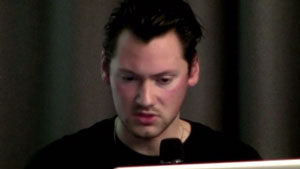
Felix Melia
Felix Melia explores several questions through his work, such as the semiotics of space, architecture and infrastructure, cultural and narrative appropriation via the Internet, and the relationships between self and space.
Synthesis
Representational space and the semiotics of space • The means by which we engender different kinds of environments with different types of meaning • Architectural infrastructure • Vast Montage • Ausklappen...
Representational space and the semiotics of space • The means by which we engender different kinds of environments with different types of meaning • Architectural infrastructure • Vast Montage • Collating physical encounters within space • Superimposition of narratives onto environments • Meaning through the Kuleshov effect • Cultural and narrative appropriation via the Internet • Hood 2 Hood: The Blockumentary • A sense of identity based not on a city • The psychological presence of the self within the space • Samuel Beckett’s Endgame • Digital dualism • Nathan Jurgenson • Gentrification and regeneration of large cities
Short biographyFelix Melia, artist working across video, film, and sculpture. He has presented work most recently at the Biennale of Moving Image at the Centre d’Art Contemporain, Geneva.
Felix Melia erforscht mit seinen Arbeiten Fragen nach der Semiotik des Raumes, Architektur und Infrastruktur, kulturellen und narrativen Appropriationen über das Internet sowie die Beziehung zwischen Selbst und Raum.
Synthese
Repräsentative Räume und die Semiotik des Raums • Mittel durch die wir verschiedene Umgebungen mit verschiedenen Bedeutungen ausstatten • Architektonische Infrastruktur • Vast Montage • Ausklappen...
Repräsentative Räume und die Semiotik des Raums • Mittel durch die wir verschiedene Umgebungen mit verschiedenen Bedeutungen ausstatten • Architektonische Infrastruktur • Vast Montage • Physische Begegnungen Räumen zuordnen • Narrative auf Umgebungen übertragen • Bedeutungsschaffung durch den Kuleshov Effekt • Kulturelle und narrative Appropriationen durch das Internet • Hood 2 Hood: The Blockumentary • Ein Identitätsgefühl das nicht auf einer Stadt beruht • Die psychologische Präsenz des Selbst im Raum • Samuel Becketts Endgame • Digitaler Dualismus • Nathan Jurgenson • Gentrifizierung und Regeneration großer Städte
KurzbiografieFelix Melia, Künstler, der mit Video, Film und Bildhauerei arbeitet. Er präsentiert seine neuesten Arbeiten auf der Biennale of Moving Image im Centre d’Art Contemporain in Genua.
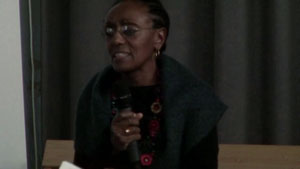
Salem Mekuria
Salem Mekuria presents on the formation of the ‘Red Terror’ Martyrs’ Memorial Museum in Addis Ababa and the issues involved in setting up such an institution. There is also a discussion on the growing use of archival films in the re-examination of history worldwide.
Synthesis
The use of language in relation to archives • The ‘Red Terror’ Martyrs’ Memorial Museum • The museum should include everyone who suffered • A pedagogical museum • Ausklappen...
The use of language in relation to archives • The ‘Red Terror’ Martyrs’ Memorial Museum • The museum should include everyone who suffered • A pedagogical museum • Vigil brought together disparate groups affected by the military regime • Photographs were collected from different sources to integrate the museum • Interacting with the museum collection via the visitors • Growing use of archival material worldwide • American history re-examined via archival films
Short biography
Salem Mekuria, a professor in the Art Department at Wellesley College, is also an independent writer, producer, director, videographer, and a video installation artist. Ausklappen...
Salem Mekuria, a professor in the Art Department at Wellesley College, is also an independent writer, producer, director, videographer, and a video installation artist. Her award winning documentary films and video installations feature Ethiopian subjects. Her honors include a fellowship at the Radcliffe Institute for Advanced Study, Harvard University, 2005-06; a Fulbright Scholar fellowship, 2003-04; the New England Media Fellowship, 2001; and the Rockefeller Foundation Intercultural Media Fellowship, 1995.
Salem Mekuria spricht zur Entstehung des ‘Red Terror’ Martyr’s Memorial Museum in Addis Abeba. Sie sprach darüber, wie archivarisches Filmmaterial einen Einfluss auf die Neubewertung geschichtlicher Zusammenhänge hat.
Synthese
Die Verwendung von Sprache in Beziehung zu Archiven • Das ‘Red Terror’ Martyrs’ Memorial Museum • Das Museum sollte jeden, der leidtragend war mit einbeziehen • Ein pädagogisches Museum • Ausklappen...
Die Verwendung von Sprache in Beziehung zu Archiven • Das ‘Red Terror’ Martyrs’ Memorial Museum • Das Museum sollte jeden, der leidtragend war mit einbeziehen • Ein pädagogisches Museum • Bemühung nicht verbundene Gruppen zusammen zu bringen, die vom Militärregime betroffen waren • Fotografien aus unterschiedlichen Quellen wurden gesammelt um das Museum integrativ zu gestalten • Interaktion mit der Sammlung des Museums durch die Besucher • Wachsende Verwendung von Archivmaterial weltweit • Amerikanische Geschichte durch archivisches Filmmaterial neu betrachtet
Kurzbiografie
Salem Mekuria, Professorin der künstlerischen Fakultät am Wellesley College sowie unabhängige Autorin, Produzentin, Regisseurin, Filmemacherin und Videoinstallationskünstlerin. Ausklappen...
Salem Mekuria, Professorin der künstlerischen Fakultät am Wellesley College sowie unabhängige Autorin, Produzentin, Regisseurin, Filmemacherin und Videoinstallationskünstlerin. Ihre ausgezeichneten Dokumentarfilme und Videoinstallationen setzen sich mit äthiopischen Themen auseinander. Auszeichnungen, die sie erhielt sind unter anderem eine Fellowship am Radcliffe Institute for Advanced Study der Harvard University von 2005-2006, eine Fulbright Scholar Fellowship von 2003-2004, die New England Media Fellowship im Jahr 2001 und die Rockefeller Foundation Intercultural Media Fellowship im Jahr 1995.
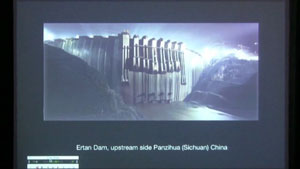
Armin Linke
Armin Linke presents his work, which focuses on questions of how to employ and think with images, especially from an archival perspective. He also discusses the relation between the Internet and architectural space, looking at the anthropological use of architecture.
Synthesis
Different ways to think and work with images • HfG Karlsruhe / ZKM • Project collaboration with Doreen Mende and Wilfried Kühn • Architettura • Collaboration with Alex Rich and Peter Hanappe • Ausklappen...
Different ways to think and work with images • HfG Karlsruhe / ZKM • Project collaboration with Doreen Mende and Wilfred Kühn • Architettura • Collaboration with Alex Rich and Peter Hanappe • Sony CSL Lab • Insurance companies do not insure artwork that can be touched • Oscar Niemeyer • Early project: an online image archive – shown at the Utopia Station, Venice Biennale • To bring the structure of the internet into the architectural space • Carlo Mollino • Anthropological use of architecture • The changing landscape of rural Italy through architecture • Bruno Latour • An Inquiry Into Modes of Existence • Phenotypes/Limited Forms • Performative installation • Using an algorithm to select the images • MMK – Museum für Moderne Kunst, Frankfurt a.M. • Making History • Corrado Calvo
Short biography
Armin Linke, artist working with film and photography, with an ongoing archive on human activity and natural and manmade landscapes. Ausklappen...
Armin Linke, artist working with film and photography, with an ongoing archive on human activity and natural and manmade landscapes. He is a professor at the HfG (Hochschule für Gestaltung) Karlsruhe, a guest professor in Arts and Design at the IUAV University in Venice, and a research affiliate at MIT Visual Arts Program Cambridge. He co-curated the project Double Bound Economies (2013), and together with Territorial Agency and Anselm Franke, he conceptualised and executed the Anthropocene Observatory video series at Haus der Kulturen der Welt, Berlin. Linke is also a part of Travelling Communiqué: Reading a Photo Archive (1948-1980).
Armin Linke präsentiert seine Arbeit mit einem Schwerpunkt auf Fragen wie man mit Bildern denken und arbeiten kann, besonders aus einer archivischen Perspektive. Er diskutiert außerdem auch die Beziehung zwischen Internet und architektonischem Raum und betrachtet hierbei die anthropologische Verwendung von Architektur.
Synthese
Unterschiedliche Arten mit Bildern zu denken und zu arbeiten • HfG Karlsruhe / ZKM • Projektzusammenarbeit mit Doreen Mende und Wilfried Kühn • Architettura • Ausklappen...
Unterschiedliche Arten mit Bildern zu denken und zu arbeiten • HfG Karlsruhe / ZKM • Projektzusammenarbeit mit Doreen Mende und Wilfred Kühn • Architettura • Zusammenarbeit mit Alex Rich und Peter Hanappe • Sony CSL Lab • Versicherungen versichern keine Kunstwerke die berührt werden dürfen • Oscar Niemeyer • Frühes Projekt: Ein Online Bildarchiv – gezeigt in der Utopia Station, Venice Biennale • Die Struktur des Internets in den architektonischen Raum bringen • Carlo Mollino • Anthropologische Verwendung von Architektur • Die sich durch Architektur verändernde Gestalt des ländlichen Italiens • Bruno Latour • An Inquiry Into Modes of Existence • Phenotypes/Limited Forms • Performative Installation • Verwendung eines Algorithmus zur Auswahl von Bildern • Museum für Moderne Kunst, Frankfurt a.M. • Making History • Corrado Calvo
Kurzbiografie
Armin Linke, Künstler. Er ist Professor an der HfG (Hochschule für Gestaltung) Karlsruhe, Ausklappen...
Armin Linke, Künstler. Er ist Professor an der HfG (Hochschule für Gestaltung) Karlsruhe, Gastprofessor für Kunst und Design an der IUAV Universität in Venedig und am MIT Visual Arts Program in Cambridge, USA. Er co-kuratierte das Projekt Double Bound Economies (2013) und konzeptualisierte und realisierte zusammen mit Territorial Agency und Anselm Franke die Anthropocene Observatory Videoreihe am Haus der Kulturen der Welt in Berlin. Linke ist außerdem Teil von Travelling Communiqué: Reading a Photo Archive (1948-1980).
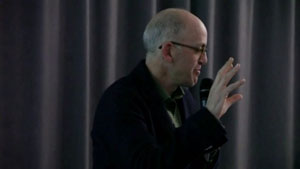
Jonathan Ledgard
Jonathan Ledgard raises several questions in relation to the arrival of new technologies and infrastructures in Africa and how these have an impact on African development, both culturally and politically. He also discusses how these technologies bring with them foreign interests and expectations, which have a direct effect on Africa as a whole.
Synthesis
Big ideas about archiving and memory • Working for The Economist • Joining love of Africa, technology, and creativity • The archiving of the human brain – reverse engineering • The Merowe people of Sudan have their archive in the elements • Ausklappen...
Big ideas about archiving and memory • Working for The Economist • Joining love of Africa, technology, and creativity • The archival of the human brain – reverse engineering • The Merowe people of Sudan have their archive in the elements • Technology is not the be-all and end-all • A youthful China shakes hands with a shy Africa • The Nokia 1100 – the most influential technology in Africa in the last fifty years • Life recording – an entire life compressed and stored • IBM predicts a tsunami of data • How will future generations of Africans relate to their past? • Africa has a history of non-archival practice • Digital data implies the recording of the present • Attitudes toward Africa will have to change in the future • The dangers of digital identities being controlled by the state and corporations
Short biography
Jonathan Ledgard, thinker on near future nature, technology, and politics. Director of the Afrotech initiative at the Swiss Federal Institute of Technology in Lausanne, Ausklappen...
Jonathan Ledgard, thinker on near future nature, technology, and politics. Director of the Afrotech initiative at the Swiss Federal Institute of Technology in Lausanne, where he works to pioneer advanced technologies on a massive scale in Africa through projects including the development of virtual coins and cargo robots. A long-time Africa correspondent for The Economist who has reported stories from 50 countries and on several wars, he is the author of two critically acclaimed novels, Giraffe (2006) and Submergence (2013).
Jonathan Ledgard hinterfragt die Einführung neuer Technologien und Infrastrukturen in Afrika und wie diese die Entwicklung in Afrika sowohl kulturell als auch politisch beeinflussen. Er diskutiert außerdem auf welche Weise diese Technologien fremde Interessen und Erwartungen mit sich bringen, die einen direkten Einfluss auf Afrika als Ganzes haben.
Synthese
Große Vorstellungen zu Archivierung und Erinnerung • Arbeit für The Economist • Verbindung einer Liebe zu Afrika, Technologie und Kreativität • Die Archivierung des menschlichen Gehirns – umgekehrte Konstruktion • Ausklappen...
Große Vorstellungen zu Archivierung und Erinnerung • Arbeit für The Economist • Verbindung einer Liebe zu Afrika, Technologie und Kreativität • Die Archivierung des menschlichen Gehirns – umgekehrte Konstruktion • Das Merowe Volk aus Sudan hat sein Archiv in den Elementen • Technologie ist nicht die Lösung aller Dinge • Ein jugendliches China und ein schüchternes Afrika schütteln sich die Hände • Das Nokia 1100 – die einflussreichste Technologie der letzten 50 Jahre in Afrika • Aufnahmen vom Leben – ein gesamtes Leben komprimiert und gespeichert • IBM sagt einen Datentsunami voraus • Welche Beziehung werden die zukünftigen Generationen in Afrika zu ihrer Vergangenheit haben? • Afrika hat eine Geschichte nicht-archivierender Praktiken • Digitale Daten implizieren eine Aufnahme der Gegenwart • Einstellungen gegenüber Afrika werden sich in Zukunft ändern müssen • Die Gefahr, dass digitale Identitäten vom Staat und von Firmen kontrolliert werden
Kurzbiografie
Jonathan Ledgard denkt über die Themen Natur, Technologie und Politik in naher Zukunft nach. Als Direktor der Afrotech Initiative am Swiss Federal Institute of Technology in Lausanne, Ausklappen...
Jonathan Ledgard denkt über die Themen Natur, Technologie und Politik in naher Zukunft nach. Als Direktor der Afrotech Initiative am Swiss Federal Institute of Technology in Lausanne, arbeitet er daran, fortgeschrittene Technologien im großangelegten Pionierprojekt in Afrika einzusetzen. Projekte die das ermöglichen sollen sind unter anderem die Entwicklung virtueller Münzen und Lastenroboter. Als langjähriger Afrikakorrespondent für The Economist, der Geschichten aus 50 Ländern und zu verschiedenen Kriegssituationen berichtete, ist er außerdem Autor zweier von der Kritik gefeierten Romane, Giraffe (2006) und Submergence (2013).
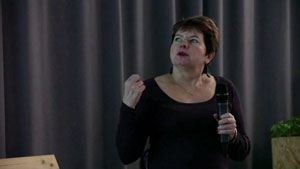
Cynthia Kros
Cynthia Kros speaks about the Apartheid Archive in South Africa and the issues that surround the formation and reception of such an institution. Her presentation raises questions in relation to memory and the urban space, especially with regard to the instalment of public sculptures, as well as questions in relation to the Truth and Reconciliation Commission, and how to bring personal stories to light.
Synthesis
The Apartheid Archives in South Africa • The issues of reading such an archive that was generated by those in power • How to memorialise the oppressed? • Brenda Fassie • Ausklappen...
The Apartheid Archives in South Africa • The issues of reading such an archive that was generated by those in power • How to memorialise the oppressed? • Brenda Fassie • The role of large statues in generating and fixating memories • Changing street names as a political tool • Hector Pieterson Memorial and Museum • The personal stories of ordinary people – how to keep them? • The acceptance of different kinds of truth • The complexity of truth and its relation to a historical archive • The Truth and Reconciliation Commission • Bringing personal stories to light
Short biography
Cynthia Kros, historian, heritage specialist, and professor at the University of the Witwatersrand, Johannesburg. Ausklappen...
Cynthia Kros, historian, heritage specialist, and professor at the University of the Witwatersrand, Johannesburg. Among other subjects, her research focuses on South African memorials and oral history. Her selected publications include the South African Historical Journal, for which she has served as co-editor since 2006, Great People, Great Places (2009), and The Seeds of Separate Development: Origins of Bantu Education (2010).
Cynthia Kros spricht über das Apartheid-Archiv in Südafrika. Sie thematisiert aktuelle Probleme der Gestaltung einer solchen Institution und welche Reaktion dabei ausgelöst werden. Ihre Präsentation berührt Fragen zu Erinnerung und urbanem Raum, besonders in Bezug öffentliche Skulpturen und Installationen. Sie beschäftig sich mit Wahrheits- und Versöhnungskommissionen, und wie diese persönliche Geschichten ans Licht bringen.
Synthesis
The Apartheid Archives in South Africa • Die Probleme beim Lesen eines solchen Archives, das von den Machthabern geschaffen wurde • Wie erinnert man an die Unterdrückten? • Brenda Fassie • Ausklappen...
The Apartheid Archives in South Africa • Die Probleme beim Lesen eines solchen Archives, das von den Machthabern geschaffen wurde • Wie erinnert man an die Unterdrückten? • Brenda Fassie • Die Rolle großer Statuen bei der Schaffung und Fixierung von Erinnerungen • Das Ändern von Straßennamen als politisches Werkzeug • Hector Pieterson Memorial and Museum • Die persönlichen Geschichten normaler Mernschen – wie können sie bewahrt werden? • Das Akzeptieren verschiedener Arten von Wahrheit • Die Komplexität von Wahrheit und deren Beziehung zu einem historischen Archiv • Die Wahrheits- und Versöhnungskommission • Persönliche Geschichten ans Licht bringen
Kurzbiografie
Cynthia Kros, Historikerin, Spezialistin für Denkmäler und Professorin an der University of the Witwatersrand, Johannesburg. Ausklappen...
Cynthia Kros, Historikerin, Spezialistin für Denkmäler und Professorin an der University of the Witwatersrand, Johannesburg. Unter anderem beschäftigt sich ihre Forschung mit südafrikanischen Denkmälern und mündlich überlieferter Geschichte. Ihre ausgewählten Publikationen umfassen das South African Historical Journal für welches sie als Mitherausgeberin seit 2006 tätig ist, Great People, Great Places (2009), und The Seeds of Separate Development: Origins of Bantu Education (2010).
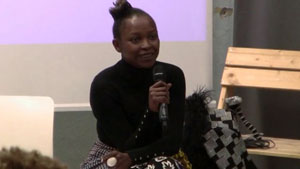
Koyo Kouoh
Koyo Kouoh presents the living archive of artist Issa Samb and discusses the importance of the artist’s work in Senegal in relation to major historical events, as well as the importance of preserving such an archive for the memory of Senegal.
Synthesis
An example of a living archive • The archive of artist Issa Samb from Dakar • Became political at the age of 13 • Politically active in West Africa for over 50 years • Ausklappen...
An example of a living archive • The archive of artist Issa Samb from Dakar • Became political at the age of 13 • Politically active in West Africa for over 50 years • Disruption of Charles De Gaulle’s visit to West and Central Africa • Living and performing his own archive on a daily basis • First artist collective in Senegal during the 1970s, the Laboratoire Agit’Art • Djibril Diop Mambéty • dOCUMENTA
Short biography
Koyo Kouoh, the founder of RAW Material Company, a centre for art, knowledge, and society, makes exhibitions, publishes books and helps others in the same labour. Ausklappen...
Koyo Kouoh, the founder of RAW Material Company, a centre for art, knowledge, and society, makes exhibitions, publishes books and helps others in the same labour. Her discursive programmes, exhibitions and publications have included contemporary artists, thinkers, writers, activists, non-artists, designers, politicians, architects, and chefs.
Koyo Kouoh präsentiert das Archiv des Künstlers Issa Samb und diskutiert die Bedeutsamkeit seines Werks in Senegal in Bezug zu bedeutenden historischen Ereignissen sowie der Wichtigkeit, ein solches Archiv für die Erinnerungskultur in Senegal zu bewahren.
Synthese
Beispiel für ein lebendiges Archiv • Das Archiv des Künstlers Issa Samb aus Dakar • Wurde im Alter von 13 Jahren politisch interessiert • Ausklappen...
Beispiel für ein lebendiges Archiv • Das Archiv des Künstlers Issa Samb aus Dakar • Wurde im Alter von 13 Jahren politisch interessiert • Seit über 50 Jahren in Westafrika politisch aktiv • Störung von Charles De Gaulles Besuch in West- und Zentralafrika • Lebt und performt sein eigenes Archiv als tägliche Praxis • Erstes Künstlerkollektiv in Senegal während der 1970er Jahre, das Laboratoire Agit’Art • Djibril Diop Mambéty • dOCUMENTA
Kurzbiografie
Koyo Kouoh, Gründungsdirektorin von RAW Material Company, einem Zentrum für Kunst, Wissen und Gesellschaft. Sie kuratiert Ausstellungen, veröffentlicht Bücher und hilft anderen im gleichen Berufszweig. Ausklappen...
Koyo Kouoh, die Gründerin der RAW Material Company, einem Zentrum für Kunst, Wissen und Gesellschaft schafft Ausstellungen, veröffentlicht Bücher und hilft anderen im gleichen Berufszweig. Ihre diskursiven Programme, Ausstellungen und Publikationen bringen zeitgenössische Künstler, Denker, Autoren, Aktivisten, Nichtkünstler, Designer, Politiker, Architekten und Köche zusammen.
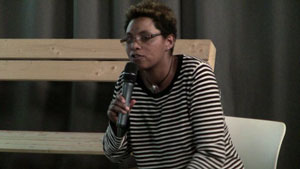
Mihret Kebede
Mihret Kebede presents her work on the concept of generations. She discusses the need for her own generation to become more politically involved in the transformation process of Addis Ababa.
Synthesis
Working with the idea of generations • Three generations: the past, the present, and the future • The past is more colourful • The ideology of the ruling party is more focused on ethnicity • Ausklappen...
Working with the idea of generations • Three generations: the past, the present, and the future • The past is more colourful • The ideology of the ruling party is more focused on ethnicity • People represent more than just physical appearance and language • People often stand silently, looking and watching what’s taking place in the city • The need for more involvement from this generation • Finding opportunities for involvement in the development process • Power or money allow true freedom of expression in the city • Billboards as art project • Description and images of the work
Short biography
Mihret Kebede, artist, founding director of the Netsa Art Village artist collective in Addis Ababa. She is the recipient of numerous grants Ausklappen...
Mihret Kebede, artist, founding director of the Netsa Art Village artist collective in Addis Ababa. She is the recipient of numerous grants including residencies at the Maryland Institute College of Art (2006), the Thami Mnyele Foundation (2012), and Deveron Arts, Huntly, Scotland (2012). Her recent projects include Slow Marathon and the Walk Sans Frontières Symposium (2012) on art, walking, and boundaries, and a performance art project for the Prince Claus Foundation annual awards ceremony in Amsterdam, Netherlands (2012). She is co-organiser of the Wax & Gold workshop and exhibition, Addis Ababa (2013), and she is a founding member of Tobiya Poetic Jazz Group.
Mihret Kebede präsentiert ihre Arbeit an einem Generationenkonzept. Sie diskutiert die Notwendigkeit für ihre eigene Generation, sich politisch mehr in den Veränderungsprozess Addis Abebas einzumischen.
Synthese
Arbeit zum Generationenverständnis • Drei Generationen: Vergangenheit, Gegenwart und Zukunft • Die Vergangenheit ist bunter • Die Ideologie der herrschenden Partei konzentriert sich mehr auf ethnische Merkmale • Ausklappen...
Arbeit zum Generationenverständnis • Drei Generationen: Vergangenheit, Gegenwart und Zukunft • Die Vergangenheit ist bunter • Die Ideologie der herrschenden Partei konzentriert sich mehr auf ethnische Merkmale • Menschen repräsentieren mehr als nur äußerliche Erscheinungen und Sprache • Menschen bleiben oft stehen und beobachten stumm was in der Stadt passiert • Die Notwendigkeit von mehr Einmischung dieser Generation • Gelegenheiten für Einmischung in den Entwicklungsprozess finden • Macht oder Geld erlauben wahre Ausdrucksfreiheit in der Stadt • Werbeflächen als Kunstprojekte • Beschreibung und Bilder der Arbeit
Kurzbiografie
Mihret Kebede, Künstlerin, Gründungsdirektorin des Netsa Art Village Künstlerkollektivs in Addis Abeba. Sie hat zahlreiche Auszeichnungen erhalten, Ausklappen...
Mihret Kebede, Künstlerin, Gründungsdirektorin des Netsa Art Village Künstlerkollektivs in Addis Abeba. Sie hat zahlreiche Auszeichnungen erhalten, unter anderem Residencies am Maryland Institute College of Art (2006), der Thami Mnyele Foundation (2012) und Deveron Arts in Huntley, Schottland (2012). Ihre aktuellen Projekte sind unter anderem Slow Marathon und das Walk Sans Frontières Symposium (2012) zu Kunst, Laufen und Grenzen, sowie ein Performancekunstprojekt für die jährliche Prince Claus Foundation Preisverleihung in Amsterdam, Niederlande (2012). Sie ist Mitorganisatorin des Wax & Gold Workshops sowie der gleichnamigen Ausstellung in Addis Abeba (2013) und sie ist Gründungsmitglied der Tobiya Poetic Jazz Group.
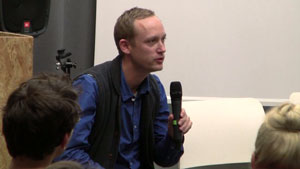
Tue Greenfort
Tue Greenfort presents on his recent projects, especially his work with water and an international water archive, as well as how this helps to understand changing landscapes and open dialogues on subjects such as biozone protection and the relation between computer science and thought.
Synthesis
dOCUMENTA (13) • Multi-species archive – human and non-human animals • Water archive • Water pollution and drinkability • Ausklappen...
Danish artist living in Berlin • dOCUMENTA (13) • Multi-species archive – human and non-human animals • Water archive • Water pollution and drinkability • Place specific – samples from around the world • Symbolic value of objects • Closed ecosystem • What is the difference between an archive and a collection? • A collection that opens dialogue • Water as a political issue • Different approaches to water • Exhibition at SculptureCenter in New York • Hurricane Sandy • Reaction to the hurricane • The changing landscape of New York • How to re-think the environment in an urban area • The horseshoe crab • Evolutionary time scale • Dialogue on biozone protection • New York context • The relation between computer science and ecological thought
Short biography
Tue Greenfort, artist. As a participant in dOCUMENTA (13) in Kassel, Germany, Greenfort was co-curator of an archive on multi-species co-evolution, The Worldly House. Ausklappen...
Tue Greenfort, artist. As a participant in dOCUMENTA (13) in Kassel, Germany, Greenfort was co-curator of an archive on multi-species co-evolution, The Worldly House. Solo presentations include Berlinische Galerie (2012), South London Gallery (2011), Kunstverein Braunschweig (2008), and Secession, Vienna (2007). Among his publications, the most comprehensive, Linear Deflection, was published by Walther König in 2009.
Tue Greenfort spricht über seine aktuellen Projekte, besonders seine Arbeit mit Wasser und seine Initiative für ein internationales Wasserarchiv. Außerdem thematisiert er, wie dies uns hilft, sich verändernde Landschaften zu verstehen und Diskurse zu Themen wie Biozonenschutz oder zu der Beziehung zwischen Computerwissenschaften und Theorie zu öffnen.
Synthese
dOCUMENTA (13) • Multispezies Archiv - menschliche und nichtmenschliche Tiere • Wasserarchiv • Wasserverschmutzung und Trinkbarkeit • Ausklappen...
Dänischer Künstler der in Berlin wohnt • dOCUMENTA (13) • Multispezies Archiv - menschliche und nichtmenschliche Tiere • Wasserarchiv • Wasserverschmutzung und Trinkbarkeit • Ortsspezifisch – Proben von überall auf der Welt • Symbolischer Wert von Objekten • Geschlossene Ökosysteme • Was ist der Unterschied zwischen einem Archiv und einer Sammlung? • Eine Sammlung, die Dialoge eröffnet • Wasser als Politikum • Unterschiedliche Ansätze zum Thema Wasser • Ausstellung im SculptureCenter in New York • Hurrikan Sandy • Reaktionen auf den Hurrikan • Die sich verändernde Landschaft New Yorks • Wie denkt man die Umgebung in einer urbanen Gegend neu? • Der Pfeilschwanzkrebs • Evolutionärer Zeitrahmen • Dialog über Biozonenschutz • New York als Kontext • Die Beziehung zwischen Computerwissenschaft und ökologischen Gedanken
Kurzbiografie
Tue Greenfort, Künstler. Als ein Teilnehmer der dOCUMENTA (13) in Kassel war Greenfort Ko-Kurator eines Archivs für spezienübergreifende Ko-Evolution, The Worldly House. Ausklappen...
Tue Greenfort, Künstler. Als ein Teilnehmer der dOCUMENTA (13) in Kassel war Greenfort Ko-Kurator eines Archivs für spezienübergreifende Ko-Evolution, The Worldly House. Soloschauen seiner Werke umfassen die Berlinische Galerie (2012), die South London Gallery (2011), den Kunstverein Braunschweig (2008), und Secession, Wien (2007). Die umfangreichste seiner Publikationen, Linear Deflection, wurde von Walther König im Jahr 2009 herausgegeben.

Elizabeth Giorgis
Elizabeth Giorgis focuses on the progressive loss of city archives in Addis Ababa due to the rapid modernisation of the city and questions the place and role of young artists in this transformation. She examines the effects that these transformations have on the local communities and how artists’ works can draw attention to these changes. She presents and discusses the work of artists Michael Tesfaye, Mihret Kebede, and Berhanu Ashagrie Deribew.
Synthesis
The Institute of Ethiopian Studies • The manipulation of archives • Addis Ababa undergoing urban transformation • Archives being erased as a result • Ausklappen...
The Institute of Ethiopian Studies • The manipulation of archives • Addis Ababa undergoing urban transformation • Archives being erased as a result • Young artists questioning their identity in relation to the past of Addis Ababa • European colonialists tried to erase African archives • The Chinese are attempting to do the same • Africa transcends • Artist Michael Tesfaye • How to talk about the future being disconnected from the past • City’s future development contrasted against its poorer past and present • Indigenous structures replaced by poor quality modern constructions • Communities being dismantled • Cemeteries cleared to make way for roads • Menelik Palace • Power existing alongside poverty • Clearing areas for development • The effects this has on the local population • Artist Mihret Kebede • The hidden and the apparent • Powerful work of performance by young artists in Addis Ababa • Questioning the use of advertising in the public space • Artist Berhanu Ashagrie Deribew • The interchange of space and place • The homogenisation of public space according to international aesthetic standards • Real censorship vs. self-censorship • The Changing DNA of Addis Ababa – Goethe-Institut
Short biography
Elizabeth Giorgis, art historian, professor, and preeminent scholar on the subject of Ethiopian art and culture. Ausklappen...
Elizabeth Giorgis, art historian, professor, and preeminent scholar on the subject of Ethiopian art and culture. She holds a PhD from the Department of History of Art and Visual Studies of Cornell University, an MA in Museum Studies from New York University, and has written extensively on Ethiopian art. As a curator, Giorgis has presented exhibitions at the Modern Art Museum and the Museum of the Institute of Ethiopian Studies, both in Addis Ababa. She was most recently a Visiting Professor in the Humanities at the Cogut Center at Brown University, Providence, USA.
Elizabeth Giorgis konzentriert sich auf den Verlust von Stadtarchiven in Addis Abeba als Folge der schnell fortschreitenden Modernisierung der Stadt und hinterfragt die Position und Rolle junger Künstler innerhalb dieses Wandels. Sie untersucht die Folgen, welche diese Veränderungen für lokale Gemeinschaften haben und fragt wie künstlerische Arbeit Aufmerksamkeit auf diese Veränderungen ziehen kann. Sie präsentiert und diskutiert die Arbeit der Künstler Michael Tesfaye, Mihret Kebede und Berhanu Ashagrie Deribew.
Synthese
The Institute of Ethiopian Studies • Die Manipulation des Archivs • Addis Abeba erlebt eine urbane Transformation • Als Folge werden Archive ausgelöscht • Ausklappen...
The Institute of Ethiopian Studies • Die Manipulation des Archivs • Addis Abeba erlebt eine urbane Transformation • Als Folge werden Archive ausgelöscht • Junge Künstler hinterfragen ihre Identität in Bezug auf Addis Abebas Vergangenheit • Europäische Kolonialisten haben versucht afrikanische Archive auszulöschen • Chinesen versuchen dasselbe • Afrika transzendiert • Künstler Michael Tesfaye • Wie kann man über die Trennung zwischen Zukunft und Vergangenheit sprechen? • Zukünftige Entwicklungen der Stadt im Kontrast zu seiner ärmeren Vergangenheit und Gegenwart • Indigene Strukturen werden von qualitative minderwertigen modernen Bauvorhaben ersetzt • Gemeinschaften werden auseinandergenommen • Friedhöfe werden geräumt um Platz für Straßen zu machen • Menelik Palace • Macht die neben Armut existiert • Orte für Stadtentwicklung räumen • Der Einfluss, den dies auf die Bevölkerung vor Ort hat • Künstlerin Mihret Kebede • Das Versteckte und das Offensichtliche • Wirkungsstarke Performancearbeiten junger Künstler in Addis Abeba • Hinterfragen der Verwendung von Werbung im öffentlichen Raum • Der Künstler Berhanu Ashagrie Deribew • Der Austausch von Raum und Ort • Die Homogenisierung des öffentlichen Raums nach internationalen ästhetischen Standards • Echte Zensur versus Selbstzensur • The Changing DNA of Addis Ababa – Goethe Institut
Kurzbiografie
Elizabeth Giorgis, Kunstgeschichtlerin, Professorin und Wissenschaftlerin auf dem Gebiet äthiopischer Kunst und Kultur. Ausklappen...
Elizabeth Giorgis, Kunstgeschichtlerin, Professorin und herausragende Wissenschaftlerin auf dem Gebiet äthiopischer Kunst und Kultur. Sie hat einen PhD vom Institut für Kunstgeschichte und Bildstudien der Cornell University, einen MA in Museumskunde der New York University und hat ausgiebig zu äthiopischer Kunst geschrieben. Als Kuratorin präsentierte Giorgis Ausstellungen am Modern Art Museum und dem Museum of the Institute of Ethiopian Studies, beides in Addis Abeba. Sie ist Gastprofessorin für Geisteswissenschaften am Cogut Center der Brown University in Providence, USA.
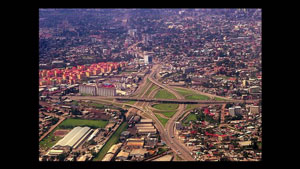
Fasil Giorghis
Fasil Giorghis presents the issues facing Addis Ababa and its rapid transformation in the 21st century, touching on themes of colonisation, archival culture, and memory preservation.
Synthesis
The importance of archives in the work of architects, city planners, and thinkers • Images of the rapid transformation of Addis Ababa • Tabula rasa approach to development in some areas • Ausklappen...
The importance of archives in the work of architects, city planners, and thinkers • Images of the rapid transformation of Addis Ababa • Tabula rasa approach to development in some areas • Anti-neoliberal policies in Addis Ababa • Western style training in architecture, no focus on local culture • Description of the history of Addis Ababa from 125 years ago • Images of Addis Ababa from European archives • The opening of the country to foreign influence after 1000 years • The Italian invasion of 1936 and its effects • Architecture and planning as tools of colonisation • Addis Ababa is not a segregated city, but segregation is developing • ‘Red Terror’ Martyrs’ Memorial Museum • Rescuing historic buildings • The role of archives in the ongoing debate for cultural preservation
Short biography
Fasil Giorghis, architect and chair of conservation of urban and architectural heritage at EiABC, Addis Ababa University. Ausklappen...
Fasil Giorghis, architect and chair of conservation of urban and architectural heritage at EiABC, Addis Ababa University. He has worked on the study and preservation of the architectural heritage of Ethiopia, from traditional housing to historic towns. In 2008, he published a book entitled Addis Ababa: The City and its Urban and Architectural Heritage from 1886-1941. He has designed hotels, cultural centres, commercial buildings, and private residences around the country, including the ‘Red Terror’ Martyrs’ Memorial Museum in Addis Ababa. Typical of his designs are the use of local materials and indigenous knowledge combined with a great concern for his designs’ impact on the environment.
Fasil Giorghis spricht über die Probleme, mit denen Addis Abeba angesichts seiner schnellen Veränderungen im 21. Jahrhundert zu kämpfen hat. Weitere Themen sind hierbei Kolonialisierung, Archivkulturen und Erinnerungsbewahrung.
Synthese
Die Bedeutsamkeit von Archiven für die Arbeit von Architekten, Stadtplanern und Theoretikern • Bilder des schnellen Wandels in Addis Abeba • Tabula rasa Ansatz für die Entwicklung einiger Gegenden • Ausklappen...
Die Bedeutsamkeit von Archiven für die Arbeit von Architekten, Stadtplanern und Theoretikern • Bilder des schnellen Wandels in Addis Abeba • Tabula rasa Ansatz für die Entwicklung einiger Gegenden • Anti-neoliberale Politik in Addis Abeba • Westlich orientierte Ausbildung in Architektur, kein Focus auf lokale Kultur • Beschreibung der Geschichte Addis Abebas ab einem Zeitpunkt von vor 125 Jahren • Bilder von Addis Abeba aus europäischen Archiven • Die Öffnung des Landes für fremde Einflüsse nach 1000 Jahren • Die italienische Invasion von 1936 und ihre Folgen • Architektur und Planung als Werkzeuge der Kolonialisierung • Addis Abeba ist keine geteilte Stadt, aber Rassentrennung nimmt zu • ‘Red Terror’ Martyrs’ Memorial Museum • Rettung historischer Gebäude • Die Rolle von Archiven in der aktuellen Debatte zu kultureller Bewahrung
Kurzbiografie
Fasil Giorghis ist Architekt und Konservator für urbane und architektonische Denkmäler an der EiABC Addis Ababa University. Ausklappen...
Fasil Giorghis ist Architekt und Konservator für urbane und architektonische Denkmäler an der EiABC Addis Ababa University. Er hat zur Erforschung und Erhaltung von Architekturdenkmälern in Äthiopien gearbeitet, von traditionellen Häusern bis hin zu historischen Städten. Im Jahr 2008 veröffentlichte er ein Buch mit dem Titel Addis Ababa: The City and its Urban and Architectural Heritage from 1886-1941. Er hat Hotels, Kulturzentren, kommerzielle Gebäude und private Wohnhäuser im gesamten Land entworfen einschließlich dem ‘Red Terror’ Martyrs’ Merorial Museum in Addis Abeba. Kennzeichnend für seine Entwürfe sind die Verwendung von lokalen Materialien und indigenem Wissen in Kombination mit einem großen Bewusstsein für den Einfluss seiner Entwürfe auf die Umwelt.
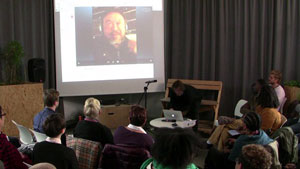
Olafur Eliasson & Ai Weiwei
Olafur Eliasson conducts a video interview with Ai Weiwei to introduce their collaboration, Moon, an online space where anyone can contribute a mark, a drawing, or an image to an integrated sphere. Through messages and non-verbal communication in a language unique to each person, the collective work becomes a testament to personal freedom, creativity, and activity.
Synthesis
Journeys and connections • Archival thinking • Retroactivity or proactivity? • Contemporary concept of the archive • Changing views • The objective vs. the subjective view of History • Ausklappen...
Journeys and connections • Archival thinking • Retroactivity or proactivity? • Contemporary concept of the archive • Changing views • The objective vs. the subjective view of History • The emergent fields of Structuralism and Post-Structuralism in relation to archives • ‘To archive’ • Producing realities from archives • Subjectivity and the reality machine • The Moon Project • Ai Weiwei’s current situation • Secret police surveillance • Activating the Moon Project via video conference • Ai Weiwei’s work in relation to the history of culture • Human consciousness • Digital media • The Chinese political situation • The Dalai Lama • Their partnership on the Moon Project • Description of the project • Moon as an archive in the making • The ethico-political issues of an open project • How much to censor? • The symbolic nature of the Moon • The consequence of self-expression
Short biographies
Olafur Eliasson, a Danish-Icelandic artist, founded the Institut für Raumexperimente, an educational research project, affiliated with the College of Fine Arts at the Berlin University of the Arts (UdK) and supported by the Senate for Education, Science and Research in Berlin and the Einstein Foundation Berlin. The fundamental trajectory of the Institut für Raumexperimente is Eliasson’s interest in testing models of learning and cultivating experimental formats.
Ai Weiwei is a Chinese contemporary artist involved in art, design, sculpture, architecture, curating, photography, writing, film, and social, political, and cultural criticism. His activities mainly focus on freedom of expression and ways to support human rights and social justice.
Olafur Eliasson führt ein Videointerview mit Ai Weiwei um in ihre Zusammenarbeit für Moon, einem Online-Raum, in dem jeder ein Zeichen, eine Zeichnung oder ein Bild auf einer digitalen Mondoberfläche einschreiben kann, einzuführen. Die kollektive Arbeit wird durch Nachrichten und nonverbale Kommunikation in einer für jeden Beitragenden individuellen Sprache zu einem Zeugnis für persönliche Freiheit, Kreativität und Aktivität.
Synthese
Reisen und Verbindungen • Archivisches Denken • Retroaktivität oder Proaktivität? • Zeitgenössisches Konzept des Archivs • Sich ändernde Ansichten • Objektive versus subjective Sicht auf Geschichte • Ausklappen...
Reisen und Verbindungen • Archivisches Denken • Retroaktivität oder Proaktivität? • Zeitgenössisches Konzept des Archivs • Sich ändernde Ansichten • Objektive versus subjective Sicht auf Geschichte • Das neue Gebiet von Strukturalismus und Post-Strukturalismus im Verhältnis zu Archiven • Archivieren • Schaffen von Realitäten aus Archiven • Subjektivität und die Realitätsmaschine • The Moon Project • Ai Weiweis aktuelle Situation • Überwachung durch Geheimpolizei • Aktivierung des Moon Project per Videokonferenz • Ai Weiweis Arbeit in Bezug zur Kulturgeschichte • Menschliches Bewusstsein • Digitale Medien • Die politische Situation in China • Der Dalai Lama • Ihre Zusammenarbeit beim Moon Project • Beschreibung des Projektes • Moon als entstehendes Archiv • Die ethnopolitischen Probleme eines offenen Projektes • Wieviel zensieren? • Die symbolische Natur des Mondes • Die Konsequenzen des persönlichen Ausdrucks
Kurzbiografien
Olafur Eliasson, dänisch-isländischer Künstler, gründete das Institut für Raumexperimente, ein Studien- und Forschungsprojekt, das Teil der Fakultät für Bildende Kunst an der Universität der Künste Berlin (UdK) ist. Eliassons Interesse, neue Lernmodelle zu testen und experimentelle Formate zu kultivieren, ist grundlegender Bestandteil des Institutsprogramms.
Ai Weiwei ist ein chinesischer zeitgenössischer Künstler, der sich mit Kunst, Design, Bildhauerei, Architektur, Kuration, Photografie, Schreiben, Film und sozialer, politischer sowie kultureller Kritik beschäftigt. Seine Aktivitäten beschäftigen sich hauptsächlich mit Meinungsfreiheit und der Unterstützung von Menschenrechten und sozialen Gerechtigkeit.
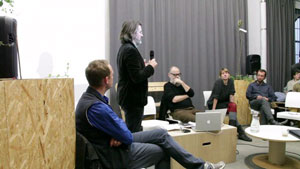
Olafur Eliasson
Olafur Eliasson presents his website as a living archive, exploring the definition of an archive and an archive’s nature as proactive or retroactive. His discussion is supplemented with examples from his own career and his online archive.
Synthesis
The start of an archive • The transition from one type of medium to another • A website as an archive • Sticky Rice – intuitive system • The internet as a gathering of material • Ausklappen...
The start of an archive • The transition from one type of medium to another • A website as an archive • Sticky Rice – intuitive system • The internet as a gathering of material • A retroactive or proactive archive • More access to the work online than at exhibitions • Changing perspective of own work • How to represent online the process of producing work? • Examples of how his website functions • How to generate a system for viewing and cataloguing the work online? • Archive or catalogue? • Does an artist’s archive include the artwork? • Archival thinking as future co-production
Short biography
Olafur Eliasson, Danish-Icelandic artist, founded the Institut für Raumexperimente, an educational research project, affiliated with the College of Fine Arts at the Berlin University of the Arts (UdK) Ausklappen...
Olafur Eliasson, Danish-Icelandic artist, founded the Institut für Raumexperimente, an educational research project, affiliated with the College of Fine Arts at the Berlin University of the Arts (UdK). The fundamental trajectory of the Institut für Raumexperimente is Eliasson’s interest in testing models of learning and cultivating experimental formats.
Olafur Eliasson präsentiert seine Website als lebendiges Archiv und diskutiert dabei die Definition des Archivs selbst sowie die Natur des Archivs als proaktiv beziehungsweise retroaktiv. Seine Überlegungen wurden durch Beispiele aus seiner eigenen Künstlerkarriere unterlegt.
Synthese
Der Beginn eines Archivs • Der Übergang von einer Art Medium zu einer anderen • Website als Archiv • Sticky Rice – intuitives System • Das Internet als Materialsammlung • Ausklappen...
Der Beginn eines Archivs • Der Übergang von einer Art Medium zu einer anderen • Website als Archiv • Sticky Rice – intuitives System • Das Internet als Materialsammlung • Ein retroaktives oder proaktives Archiv • Online mehr Zugang zu Arbeiten als in der Ausstellung • Sich wandelnde Perspektiven auf das eigene Werk • Wie kann der Produktionsprozess eines Kunstwerkes online repräsentiert werden? • Beispiele wie seine Website funktioniert • Wie schafft man ein System zum Betrachten und Katalogisieren von Arbeiten online? • Archiv oder Katalog? • Enthält ein Künstlerarchiv die Kunstwerke? • Archivisches Denken als zukünftige Koproduktion
Kurzbiografie
Olafur Eliasson, dänisch-isländischer Künstler, gründete das Institut für Raumexperimente, ein Studien- und Forschungsprojekt, Ausklappen...
Olafur Eliasson, dänisch-isländischer Künstler, gründete das Institut für Raumexperimente, ein Studien- und Forschungsprojekt, das Teil der Fakultät für Bildende Kunst an der Universität der Künste Berlin (UdK) ist. Eliassons Interesse, neue Lernmodelle zu testen und experimentelle Formate zu kultivieren, ist grundlegender Bestandteil des Institutsprogramms.
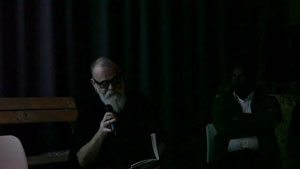
AA Bronson
AA Bronson presents five decades of his work as an artist. He explores issues of artists working collectively, artists’ books, networking, archival practices and cultures, AIDS, and personal projects. He speaks of projects such as Printed Matter, General Idea, File Megazine, Art Metropole, Other Books, Ecart, and The 1984 Miss General Idea Pavilion.
Synthesis
Printed Matter • Artists’ books from around the world in the 60s and 70s • Artists networking via self-made books • General Idea • Working as a collective and receiving and producing print material • Ausklappen...
Printed Matter • Artists’ books from around the world in the 60s and 70s • Artists networking via self-made books • General Idea • Working as a collective and receiving and producing print material • File Megazine • One of the earliest artist-run magazines • Acting as a network of artists • Existing outside the mainstream distribution channels • Art Metropole • System for artists’ projects in multiple formats • Other Books • Ecart • Nodes of a distribution system • Sol Lewitt • Franklin Furnace • Split between Printed Matter and Franklin Furnace: one became a bookshop and the other an archive • AIDS in the 80s and 90s forced artists’ archives to be formed during middle age • The difference between an archive and a library • Miss General Idea Pavilion • Self-generated, parallel art system • Generating an archive through mailing projects with other artists • Non-hierarchical approach to received material • Plain paper copier starts punk-zine boom • Manipulating the Self – book exploring the concept of self- and audience manipulation • Wittgenstein
AA Bronson stellt fünf Jahrzehnte seiner künsterischen Arbeit vor. Er geht dabei auf kollektive künstlerische Arbeit, Künstlerbücher, Networking, Archivpraktiken und Kulturen, AIDS und persönliche Projekte ein. Erwähnt warden unter anderem Projekte wie Printed Matter, General Idea, File Megazine, Art Metropole, Other Books, Ecart, und The 1984 Miss General Idea Pavilion.
Synthese
Printed Matter • Internationale Künstlerbücher in den 1960er und 1970er Jahren • Künstlernetzwerke durch selbst produzierte Bücher • General Idea • Arbeit im Kollektiv und Annahme sowie Produzieren von Printmaterial • Ausklappen...
Printed Matter • Internationale Künstlerbücher in den 1960er und 1970er Jahren • Künstlernetzwerke durch selbst produzierte Bücher • General Idea • Arbeit im Kollektiv und Annahme sowie Produzieren von Printmaterial • File Megazine • Eines der ersten künstlergeführten Magazine • Handeln als Künstlernetzwerk • Bestehen außerhalb der populären Distributionswege • Art Metropole • Systeme für Künstlerprojekte in verschiedenen Formaten • Other Books • Ecart • Knotenpunkte eines Vertriebssystems • Sol Lewitt • Franklin Furnace • Teilung in Printed Matter und Franklin Furnace, wovon eines ein Buchladen, das andere ein Archiv wurde • AIDS in den 1980er und 1990er Jahren machte es notwendig, dass Künstlerarchive im mittleren Alter begonnen wurden • Der Unterschied zwischen einem Archiv und einer Bibliothek • Miss General Idea Pavilion • Selbstgeschaffenes, paralleles Kunstsystem • Schaffung eines Archives durch postalischen Austausch über Projekte mit anderen Künstlern • Nicht-hierarchischer Umgang mit erhaltenem Material • Die Kopiermaschine begründet den Boom der Punk-Zines • Manipulating the Self – Buch, das das Konzept von Selbst und Publikumsmanipulation erforscht • Wittgenstein
Kurzbiografie
AA Bronson, Künstler, begründete im Jahr 1969 die Künstlergruppe General Idea mit Felix Partz und Jorge Zontal. Er ist außerdem als Gründer von Art Metropole (1974), Ausklappen...
AA Bronson, Künstler, begründete im Jahr 1969 die Künstlergruppe General Idea mit Felix Partz und Jorge Zontal. Er ist außerdem als Gründer von Art Metropole (1974), der NY Art Book Fair (2006) sowie dem Institute for Art, Religion and Social Justice (2008) bekannt. Er war von 2004 bis 2010 Leiter von Printed Matter, Inc und lehrte an der UCLA, der University of Toronto und der Yale School of Art. AA Bronsons eigenes Werk beschäftigt sich mit Trauma, Verlust, Tod und Heilung aus der Perspektive der Queer Theory. Sein Oeurvre – als Künstler, Heiler, Kurator und Lehrender – ist geprägt von kollaborativer Praxis und Konsensfindung. Er hatte zahlreiche internationale Einzelausstellungen und erhielte ebenso zahlreiche Auszeichnungen und Ehrendoktortitel.
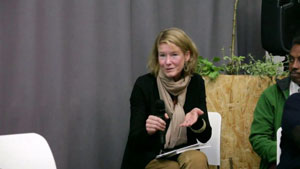
Beatrice von Bismarck
Beatrice von Bismarck speaks of the creation of the MA programme Cultures of the Curatorial and the involvement of the course participants in the curatorial project The Subjective Object. The project dealt with an archive of anthropological photography from the late 1920s of the Adivasi people of India and the political and socio-historical issues related to this archive. Several key questions are raised regarding colonialism, the anthropological gaze, the role of museums, the status of exhibits, the role of photography in relation to communal memory, and the ontological standing of the photograph itself.
Synthesis
Producing art and archives out of existing archives · The Subjective Object · The culture of a curatorial course · A project under the conditions of institutional limitations or perspectives · Ausklappen...
Producing art and archives out of existing archives · The Subjective Object · The culture of a curatorial course · A project under the conditions of institutional limitations or perspectives · How do things work within state institutions and how do we want to make them work in a different way? · Problematising the German photographic archive on the Adivasi of India in the Leipzig Museum of Ethnography · How can something so reproducible and unoriginal and not object-like be repatriated? · To bring that encounter in documented form back to Germany · The images helped create the Adivasi Academy in India · What has the photograph turned to? · What kind of item are we looking at? · Is this a document? · Is this in fact an object of the ancestors? · Is this a representation that equals the status of the ancestors? · The museum itself as an invention of the West now transplanted to India · The constantly shifting status of the image · How do you feed them back into a process of reading and rereading and even reconstructing a history through a constant rereading? · What can images actually do? · What do objects do? · How does meaning attach itself to images that gets shed away again through different contextualisation? · How can images become agents?
Short biography
Beatrice von Bismarck, professor of art history and visual culture at the Academy of Visual Arts Leipzig, is the co-founder and co-director of the project space Ausklappen...
Beatrice von Bismarck, professor of art history and visual culture at the Academy of Visual Arts Leipzig, is the co-founder and co-director of the project space Kunstraum der Leuphana Universität Lüneburg and of the project space /D/O/C/K at the Academy of Visual Arts Leipzig. She initiated and co-directs the MA programme Cultures of the Curatorial. Her current research areas focus on modes of cultural production connecting theory and practice, curatorial practice, and the effects of neo-liberalism and globalisation on the cultural field. Her publications include the seminal book Interarchive: Archival Practices and Sites in the Contemporary Art Field (2002), which was edited with Hans-Peter Feldmann, Hans Ulrich Obrist, Diethelm Stoller, and Ulf Wuggenig.
Beatrice von Bismarck spricht über die Entwicklung des MA Studienganges Kulturen des Kuratorischen und die Beteiligung der Studierenden am kuratorischen Projekt “The Subjective Object”. Das Projekt beschäftigt sich mit einem anthropologischen Fotoarchiv aus den späten 1920er Jahren, das die indischen Adivasi zeigt. Politische und soziohistorische Fragestellungen in Zusammenhang mit diesem Archiv werden untersucht. Kernfragen werden in Hinblick auf Kolonialismus, den anthropologischen Blick, die Rolle des Museums, den Status von Ausstellungen, die Rolle von Fotografie in Bezug zu geteilter Erinnerung sowie die ontologische Position des Fotos selbst gestellt.
Synthese
Produktion von Kunst und Archiven aus bestehenden Archiven · The Subjective Object · Kulturen des Kuratorischen Studiengang · Projekte unter den Bedingungen institutioneller Einschränkung oder Perspektiven · Ausklappen...
Produktion von Kunst und Archiven aus bestehenden Archiven· The Subjective Object · Die Kultur eines kuratorischen Studienganges · Projekte unter den Bedingungen institutioneller Einschränkung oder Perspektiven · Wie funktionieren Dinge in staatlichen Institutionen und wie wollen wir sie auf andere Weise funktionieren lassen? · Problematisierung des deutschen Fotoarchives über die indischen Adivasi im Leipziger Museum für Ethnografie · Wie kann etwas so reproduzierbares und nicht-objekthaftes an seinen Ursprung zurückgeführt werden? · Dieses Treffen in dokumentierter Form nach Deutschland zurückbringen · Die Bilder trugen dazu bei, die Adivasi Academy in Indien zu gründen · Wohin hat sich das fotografische Bild gewendet? · Was für ein Ding sehen wir? · Ist dies ein Dokument? · Ist das hier vielleicht sogar ein Objekt der Vorfahren? · Ist dies eine Darstellung, die die Stellung der Vorfahren wertgleich repräsentiert? · Das Museum als westliche Erfindung, nach Indien übertragen · Die sich andauern verändernde Stellung des Bildes · Wie lassen sie sich wieder zurückführen in einen Prozess des Lesens, Wiederlesens und sogar der Rekonstruktion von Geschichte durch beständiges Wiederlesen? · Was können Bilder tatsächlich bewirken? · Was tun Objekte? · Wie erhalten Bilder Bedeutung, die dann durch unterschiedliche Kontexte wieder verschwindet? · Wie können Bilder aktiv handeln?
Kurzbiografie
Beatrice von Bismarck, Professorin für Kunstgeschichte an der Hochschule für Grafik und Buchkunst Leipzig ist Mitbegründerin und Co-Direktorin des Projektraumes Kunstraum Ausklappen...
Beatrice von Bismarck, Professorin für Kunstgeschichte an der Hochschule für Grafik und Buchkunst Leipzig ist Mitbegründerin und Co-Direktorin des Projektraumes Kunstraum an der Leuphana Universität in Lüneburg sowie des Projektraumes D/O/C/K an der Hochschule für Grafik und Buchkunst in Leipzig. Sie begründete den MA Studiengang Kulturen des Kuratorischen und leitet diesen als Ko-Direktorin. Ihre aktuelle Forschung konzentriert sich auf Modi der Kulturproduktion und verbindet Theorie mit Praxis, kuratorischer Praxis sowie den Einflüssen des Neoliberalismus und der Globalisierung auf den Kulturbereich. Zu ihren Publikationen zählt u.a. das Buch Interarchive: Archival Practices and Sites in the Contemporary Art Field (2002), das zusammen mit Hans-Peter Feldmann, Hans Ulrich Obrist, Diethelm Stoller und Ulf Wuggenig herausgegeben wurde.
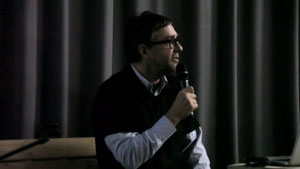
Jochen Becker
Jochen Becker speaks of the long-standing relationship between China and Africa, which he refers to as Chinafrica, challenging the preconceived notion that the trade links between China and Africa are a new phenomenon. As artistic examples for a contemporary notion of Chinafrica, he discusses the work of Sammy Baloji, Elke Marhöfer, Paolo Woods, and Michael MacGarry.
Synthesis
China • Africa • Chinafrica • The bilateral relationship between China and Africa • Arnold Meek • Haus der Kulturen der Welt • Global Prayers Project • Africans travelling to China to buy goods • Ausklappen...
China • Africa • Chinafrica • The bilateral relationship between China and Africa • Arnold Meek • Haus der Kulturen der Welt • Global Prayers Project • Africans travelling to China to buy goods • Chinese with African background • The China-Africa connection undermines the France-Africa one • Different African national approaches to China • African nation states, private companies, and individual entrepreneurs compete and collaborate when dealing with China • Chinafrica dates back to the 14th and 15th centuries • The Soviet Union and China compete for Africa in the 60s and 70s • China helps build African infrastructure • Building the railroads • The image of Africa in the Chinese media during the 70s • Cooperation, not help • Co-revolutionary aim • Renewed Chinese interest in Africa is economically led • The exploitation of the copper belt • Congolese artist Sammy Baloji • Decolonisation • Hong Kong • Artist Elke Marhöfer • The fast-paced change of Lagos, Nigeria, due to Chinese influence • Artist Paolo Woods • Fantasies of colonialism • Artist Michael MacGarry • Chocolate City
Short biography
Jochen Becker, author, lecturer, and curator based in Berlin and Stockholm. He is a founding member of metroZones – Center for Urban Affairs Ausklappen...
Jochen Becker, author, lecturer, and curator based in Berlin and Stockholm. He is a founding member of metroZones – Center for Urban Affairs and has edited several books, including BIGNES? (2001), Kabul/Teheran 1979ff (2006), and Urban Prayers (2011). He has (co)curated exhibitions such as The Urban Cultures of Global Prayers (2012/13, nGbK Berlin, Camera Austria, Graz) and Self Made Urbanism Rome (2013, nGbK Berlin; 2014, Rome). He was artistic director of the Global Prayers Project at Haus der Kulturen der Welt in Berlin. In 2014, he began teaching in the postgraduate Art & Architecture programme at the Royal Institute of Art, Stockholm.
Jochen Becker spricht über die seit langem bestehende Beziehung zwischen China und Afrika, die er als Chinafrika bezeichnet und damit Vorurteile wiederlegt, die die Handelsbeziehungen zwischen China und Afrika als ein neues Phänomen betrachten. Als künstlerische Beispiele für ein zeitgenössisches Verständnis von Chinafrika bespricht er Werke von Sammy Baloji, Elke Marhöfer, Paolo Woods und Michael MacGarry.
Synthese
China • Africa • Chinafrica • Die bilaterale Beziehung zwischen China und Afrika • Arnold Meek • Haus der Kulturen der Welt • Global Prayers Project • Afrikaner, die nach China reisen um Waren einzukaufen • Ausklappen...
China • Africa • Chinafrica • Die bilaterale Beziehung zwischen China und Afrika • Arnold Meek • Haus der Kulturen der Welt • Global Prayers Project • Afrikaner die nach China Reisen um Waren einzukaufen • Chinesen mit afrikanischen Wurzeln • Die China-Afrika Verbindung untergräbt die Frankreich-Afrika Verbindung • National unterschiedliche Zugänge zu China innerhalb Afrikas • Afrikanische Nationalstaaten, private Unternehmen und Unternehmer kollaborieren und stehen beim Handel mit China im Wettstreit • Chinafrica lässt sich bis zum 14. und 15. Jahrhundert zurückverfolgen • Wettstreit der Sowietunion und Chinas um Afrika in den 1960er und 1970er Jahren • China hilft beim Aufbau einer afrikanischen Infrastruktur • Bau der Eisenbahnlinien • Das Bild Afrikas in den chinesischen Medien während der 1970er Jahre • Kooperation, keine Hilfe • Ko-revolutionäres Ziel • Wiedererwachtes chinesisches Interesse an Afrika ist wirtschaftlich motiviert • Die Erforschung des Kupfergürtels • Der kongolesische Künstler Sammy Baloji • Dekolonalisierung • Hong Kong • Die Künstlerin Elke Marhöfer • Die schnelle Veränderung von Lagos, Nigeria, bedingt durch chinesischen Einfluss • Der Künstler Paolo Woods • Fantasien des Kolonialismus • Der Künstler Michael MacGarry • Chocolate City
Kurzbiografie
Jochen Becker, Autor, Lehrender und Kurator, der in Berlin und Stockholm lebt. Er ist Gründungsmitglied von metroZones – Center for Urban Affairs, Ausklappen...
Jochen Becker, Autor, Lehrender und Kurator, der in Berlin und Stockholm lebt. Er ist Gründungsmitglied von metroZones – Center for Urban Affairs, und Herausgeber zahlreicher Publikationen, einschließlich BIGNES? (2001), Kabul/Teheran 1979ff (2006) und Urban Prayers (2011). Er (ko)kuratierte Ausstellungen wie The Urban Cultures of Global Prayers (2012/2013, nGbK, Berlin, Camera Austria, Graz) und Self Made Urbanism Rome (2013nGbK Berlin; 2014, Rom). Er war künstlerischer Leiter des Global Prayers Project am Haus der Kulturen der Welt in Berlin. Im Jahr 2014 begann er im Rahmen eines postgraduierten Studienganges in Kunst und Architektur am Royal Institute of Art in Stockholm zu unterrichten.
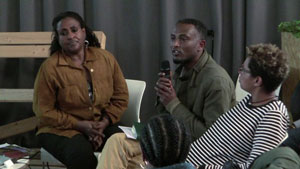
Berhanu Ashagrie Deribew
Berhanu Ashagrie Deribew’s presentation focuses on the Alle School of Fine Arts and Design and its present and future challenges. He discusses artworks that challenge the physicality of the city and raises the question of how to go beyond this physicality by exploring the artwork’s performativity and by working with words – not in an illustrative sense, but in a way that challenges the space.
Synthesis
Alle School of Fine Arts and Design • Description of the work and ethos of the school • Previous projects • The physicality of the space • Ausklappen...
Alle School of Fine Arts and Design • Description of the work and ethos of the school • Previous projects • The physicality of the space • Performativity of the artwork • Thinking the city beyond its physicality • Working with words • Description of work with words • here-and-now
Short biography
Berhanu Ashagrie Deribew’s presentation focuses on the Alle School of Fine Arts and Design and its present and future challenges. Ausklappen...
Berhanu Ashagrie Deribew’s presentation focuses on the Alle School of Fine Arts and Design and its present and future challenges. He discusses artworks that challenge the physicality of the city and raises the question of how to go beyond this physicality by exploring the piece’s performativity and by working with words – not in an illustrative sense, but in a way that challenges the space.
Berhanu Ashagrie Deribew konzentriert sich in seiner Präsentation auf die Alle School of Fine Arts and Design mit ihren gegenwärtigen und zukünftigen Aufgaben und Hürden. Er bespricht Kunstwerke, die die Körperlichkeit der Stadt hinterfragen. Weiterführend fragt er, wie man über diese Körperlichkeit durch eine Betrachtung der Performativität des Werkes und die Arbeit mit Sprache hinausgehen kann – nicht im illustrativen Sinne, sondern auf eine Art, die den Raum selbst herausfordert.
Synthesis
Alle School of Fine Arts and Design • Beschreibung der Arbeit und des Ethos der Schule • Frühere Projekte • Die Körperlichkeit des Raumes • Ausklappen...
Alle School of Fine Arts and Design • Beschreibung der Arbeit und des Ethos der Schule • Frühere Projekte • Die Körperlichkeit des Raumes • Performativität des Kunstwerkes • Die Stadt über ihre Körperlichkeit hinaus denken • Arbeit mit Sprache • Beschreibung von Arbeit mit Worten • here-and-now

Space Activism Marathon, Portraits
Portraits by Asmund Havsteen-Mikkelsen:
Achim Mengis
EricEllingsen
Eva de Klerk
Francesca Ferguson
Markus Miessen
Olafur Eliasson
Ulrich Beckefeld
Martin Rein-Cano
Robert Merk
Portraits von Asmund Havsteen-Mikkelsen:
Achim Mengis
EricEllingsen
Eva de Klerk
Francesca Ferguson
Markus Miessen
Olafur Eliasson
Ulrich Beckefeld
Martin Rein-Cano
Robert Merk
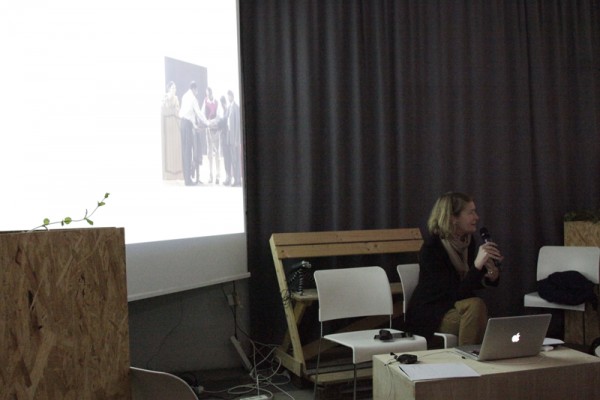
Archives Works Marathon, Tag 3
Contributions byBeatrice von Bismarck, AA Bronson, Olafur Eliasson, Tue Greenfort, Koyo Kouoh, Armin Linke, Georges Pfruender, Nicola Setari, Louwrien Wijers
Beiträge vonBeatrice von Bismarck, AA Bronson, Olafur Eliasson, Tue Greenfort, Koyo Kouoh, Armin Linke, Georges Pfruender, Nicola Setari, Louwrien Wijers
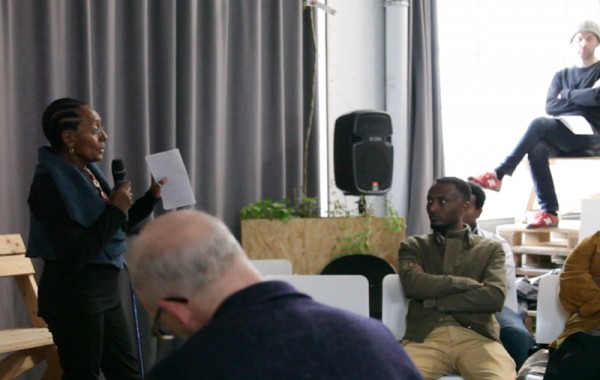
Archives Works Marathon, Tag 2
Contributions byBerhanu Ashagrie Deribew, Jochen Becker, Olafur Eliasson, Fasil Giorghis, Elizabeth Giorgis, Mihret Kebede, Cynthia Kros, Jonathan Ledgard, Salem Mekuria, Natasha Mendonca, Felix Melia, Emeka Ogboh, Ai Weiwei; Opening of Grey Sheep with audio work by Robert Lippok, AEAEAEAE, Hans-Henning Korb & Raul Walch
Beiträge vonBerhanu Ashagrie Deribew, Jochen Becker, Olafur Eliasson, Fasil Giorghis, Elizabeth Giorgis, Mihret Kebede, Cynthia Kros, Jonathan Ledgard, Salem Mekuria, Natasha Mendonca, Felix Melia, Emeka Ogboh, Ai Weiwei; Eröffnung des Grey Sheep mit einer Arbeit von Robert Lippok, AEAEAEAE, Hans-Henning Korb & Raul Walch

Archives Works Marathon, Tag 1
Contributions bySalem Mekuria, Doreen Mende, Aykan Safoǧlu, Bernd Scherer, Stefanie Schulte Strathaus
Bus Tour / Visit of Berlin-based InstitutionsHouse of World Cultures: After Year Zero. Geographies of Collaboration since 1945. Introduction by Bernd Scherer. Conversation with Doreen Mende on the project "Travelling Communiqué. Reading a Photo Archive (1948-1980)"
Arsenal - Institute for Film and Video Art: Conversation with Stefanie Schulte Strathaus on the projects "Living Archive" & "Visionary Archive"
Film ScreeningAykan Safoǧlu: Off-White Tulips, 2013
Salem Mekuria: Ye Wonz Maibel: Deluge, 1996/97
mit Beiträgen vonSalem Mekuria, Doreen Mende, Aykan Safoǧlu, Bernd Scherer, Stefanie Schulte Strathaus
Bus Tour / Besuch Berliner InstitutionenHaus der Kulturen der Welt: After Year Zero. Geografien der Kollaboration seit 1945. Einführung von Bernd Scherer. Gespräch mit Doreen Mende über das Projekt "Travelling Communiqué. Reading a Photo Archive (1948-1980)"
Arsenal - Institut für Film und Videokunst: Gespräch mit Stefanie Schulte Strathaus über die Projekte "Living Archive" und "Visionary Archive"
Film ScreeningAykan Safoǧlu: Off-White Tulips, 2013
Salem Mekuria: Ye Wonz Maibel: Deluge, 1996/97
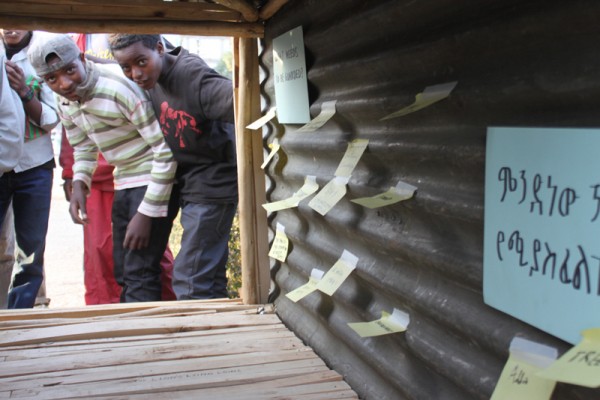
Archives Works Marathon
As practiced memory. As practicing stories. As historying. As something technologically or corporally mediated. As something political and socially touching the world. As tool or weapon (as you decide), a responsibility, something critically filtered, shaped, opened rather than closed, generative rather than entombed. In the future more than the past. Maybe a now-memory, as Henri Bergson says.
The three-day Archives Works Marathon is a dense vortex of energy and ideas materializing around the practice of archives, producing content and showing case studies and tools that art engages through means of archival practices and education methodologies. It assembles artists, historians, curators, theoreticians, urban planners, educators, e.a. to present and participate in talks, performances, and experiments followed by questions and discussion panels. The former marathons gathered swarming matrices of peers and practitioners, provoking relationships connected to the Institute as practices in teaching and learning with the understanding that art and art education can and do change reality. These marathons are teaching experiments. They are occasions for co-producing knowledge by doing our thinking together. Archives Works because archives work. Archives are works. Archives must work. Must be worked. Archives must be practiced. The marathon will be a proof of concept for how different archival practices grow and evolve.
A ‘proof of concept’ is an idea acted to prove its feasibility. It is theory practiced. This is a proof of a concept, which works and keeps working. Archives Works, in addition to being a methodological experiment in teaching doing, is also the next step in the project Acting Archives, which is being enacted as a collaboration between the Institut für Raumexperimente, the Alle School of Fine Art And Design at the University of Addis Ababa and other artist groups and institutions in Addis Ababa.
Contributions include presentations, discussions, a curated exhibition titled Archives Acting, works, and film screenings. Contributors include Aeaeaeae, Hans-Henning Korb, Robert Lippok, and Raul Walch; Berhanu Ashagrie Deribew; Jochen Becker; Beatrice von Bismarck; AA Bronson; Olafur Eliasson; Eric Ellingsen; Fasil Giorghis; Elizabeth Giorgis; Tue Greenfort; Clara Jo; Mihret Kebede; Koyo Kouoh; Cynthia Kros; Jonathan Ledgard; Armin Linke; Robert Lippok; Bekele Mekonnen; Salem Mekuria; Felix Melia; Doreen Mende; Natasha Mendonca; Netsa Art Village; Emeka Ogboh; Elvira Dyangani Ose, Pere Ortín, and Vic Pereiró; Georges Pfruender; Olga Robayo; Aykan Safoglu; Bernd Scherer; Stefanie Schulte Strathaus; Daniela Seel, Rike Scheffler, Ernesto Estrella, and Sis Matthé; Nicola Setari; Diana Sprenger; Kat Válastur; Ai Weiwei; Christina Werner; Louwrien Wijers; and Euan Williams.
Recipes and menu and thoughts by Tainá Guedes, Asako Iwama, Lauren Maurer, and Lynn Peemoeller. Menu, designed by Thomas Meyer: (PDF)
Archives Works Marathon, Visual Notes by Georges Pfruender
Acting Archives is a project by the Institut für Raumexperimente, Berlin University of the Arts and the Alle School of Fine Arts and Design, Addis Ababa University, supported by Studio Olafur Eliasson, and funded by the TURN Fund of the German Federal Cultural Foundation.
Als praktizierte Erinnerung. Als praktizierte Geschichten. Als Geschichtsschreibung. Als etwas technologisch oder körperlich Vermitteltes. Als etwas, das politisch oder sozial die Welt berührt. Als (wahlweise) Werkzeug oder Waffe, etwas das Verantwortung übernimmt, das kritisch filtert, Form gibt, das Offenheit statt Geschlossenheit ermöglicht, das generiert anstatt zu konsolidieren. Es reicht in die Zukunft mehr als in die Vergangenheit. Vielleicht ein „Erinnerung der Gegenwart“ wie Henri Bergson sagt.
Der dreitägige Archives Works Marathon ist ein dichter Energie- und Ideenstrom rund um das Arbeiten mit Archiven, der Inhalte generiert, Fallstudien, Werkzeuge und Methodik archivarischer Praktiken und künstlerischer Wissensproduktion vorstellt. Diskutieren und teilnehmen werden Künstler, Historiker, Kuratoren, Theoretiker, Stadtplaner, Lehrende, etc. mit Vorträgen, Performances und Experimenten, denen Frage- und Diskussionsrunden folgen. Die bisherigen Marathon-Veranstaltungen des Instituts brachten Kollegen und Fachleute zusammen, die mit dem Institut über ihre Lehr- und Lernpraxis verbunden sind, und die Kunst und Kunstausbildung die Fähigkeit einräumen, Wirklichkeit verändern zu können. Diese Marathon-Veranstaltungen sind gleichermaßen Experimente im Lehren und Lernen. Sie sind Anlässe gemeinsamer Wissensaneignung für Denken und Handeln gleichermaßen.
Archive sind Werke. Archive arbeiten, sie müssen bearbeitet werden, sie müssen Arbeiten generieren. Der Marathon ist ein Proof of Concept, dafür dass verschiedene archivarische Praktiken initiiert und weiter entwickelt werden.
Ein Proof of Concept ist eine Idee, die ausgeführt wird, um ihre Machbarkeit zu beweisen. Es ist praktizierte Theorie. Archives Works ist nicht nur ein Experiment für Lehre und künstlerisches Handeln, es ist darüber hinaus Teil des Projekts Acting Archives, das vom Institut für Raumexperimente in Kooperation mit der Alle School of Fine Art And Design an der University of Addis Ababa, mit Künstlerinitiativen und weiteren Institutionen in Addis Ababa realisiert wird.
Beiträge bestehen aus Präsentationen, Diskussionen, einer kuratierten Ausstellung unter dem Titel Archives Acting, Arbeiten und Filmvorführungen. Beitragende sind Aeaeaeae, Hans-Henning Korb, Robert Lippok und Raul Walch; Berhanu Ashagrie Deribew; Jochen Becker; Beatrice von Bismarck; AA Bronson; Olafur Eliasson; Eric Ellingsen; Fasil Giorghis; Elizabeth Giorgis; Tue Greenfort; Clara Jo; Mihret Kebede; Koyo Kouoh; Cynthia Kros; Jonathan Ledgard; Armin Linke; Robert Lippok; Bekele Mekonnen; Salem Mekuria; Felix Melia; Doreen Mende; Natasha Mendonca; Netsa Art Village; Emeka Ogboh; Elvira Dyangani Ose, Pere Ortín, und Vic Pereiró; Georges Pfruender; Olga Robayo; Aykan Safoǧlu; Bernd Scherer; Stefanie Schulte Strathaus; Daniela Seel, Rike Scheffler, Ernesto Estrella und Sis Matthé; Nicola Setari; Diana Sprenger; Kat Válastur; Ai Weiwei; Christina Werner; Louwrien Wijers und Euan Williams.
Rezepte, das Menü und Reflektionen zu Essen kommen von Tainá Guedes, Asako Iwama, Lauren Maurer und Lynn Peemoeller. Rezeptkarten, designed von Thomas Meyer: (PDF)
Bildnotizen von Georges Pfruender
Acting Archives ist ein Projekt des Institut für Raumexperimente der Universität der Künste Berlin und der Alle School of Fine Arts and Design, Addis Ababa University, unterstützt durch Studio Olafur Eliasson, gefördert im Fonds TURN der Kulturstiftung des Bundes.
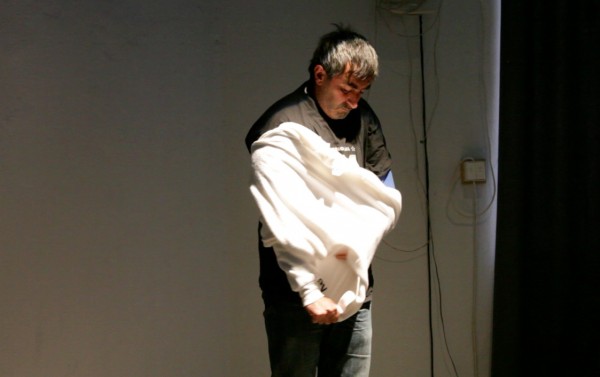
Performance Practices Marathon: Tag 3
Performance Practices Marathon: Day 3Contributions by Kendell Geers, Hannah Hurtzig, Mathis Landwehr, Antje Majewski, Cia Rinne, Stephanie Rosenthal, Frédéric Seguette, Simon Starling. Lunch break outside with vendors from Kreuzberg Markthalle. Day ends with discussion coffee & walk to beers and Berlin Hunted Wildschwein grill out in middle of Schönhauser Allee.
presentation by Stephanie Rosenthal
watch presentation by Antje Majewski
Discussion with Antje Majewski, Chantal Mouffe, Christina Werner, Cia Rinne, Dana Yahalomi, Eric Ellingsen, Kendell Geers, Olafur Eliasson, Oliver Marchart, and Stephanie Rosenthal
lecture by Hannah Hurtzig
talk by Kendell Geers
Cia Rinne reading from her book Notes for Soloists,
find more at archives zaroum: http://www.afsnitp.dk/galleri/archiveszaroum/ and on ubuweb: http://www.ubu.com/vp/rinne.html (Zaroum and Notes for Soloists)
Mathis Landwehr
Frédéric Seguette performing Jérôme Bel’s "Shirtology"
Berlin Hunted Wildschwein grill
Performance Practices Marathon: Tag 3Beiträge von Kendell Geers, Hannah Hurtzig, Mathis Landwehr, Antje Majewski, Cia Rinne, Stephanie Rosenthal, Frédéric Seguette, Simon Starling.
Präsentation von Stephanie Rosenthal
Präsentation von Antje Majewski
Diskussion mit Antje Majewski, Chantal Mouffe, Christina Werner, Cia Rinne, Dana Yahalomi, Eric Ellingsen, Kendell Geers, Olafur Eliasson, Oliver Marchart und Stephanie Rosenthal
Vortrag von Hannah Hurtzig
Vortrag von Kendell Geers
Cia Rinne liest aus ihrem Buch Notes for Soloists,
weitere Texte in den archives zaroum: http://www.afsnitp.dk/galleri/archiveszaroum/ und bei ubuweb: http://www.ubu.com/vp/rinne.html (Zaroum und Notes for Soloists)
Mathis Landwehr
Frédéric Seguette: "Shirtology" von Jérôme Bel
Berlin Hunted Wildschwein
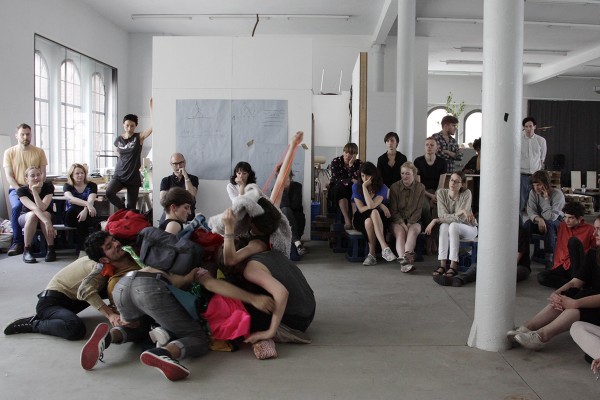
Performance Practices Marathon: Tag 2
Performance Practices Marathon: Day 2Contributions by Christian Falsnaes, Kendell Geers, Oliver Marchart, Bettina Masuch, Vladimir Miller, Alexandra Pirici, Meg Stuart, Joanna Warsza, Dana Yahalomi. Lunch break with Dinner Exchange Berlin +. Day ends with beers and open conversation.
Video Documentation
performance and talk with Christian Falsnaes
Meg Stuart & Vladimir Miller:
"MESSY PILE is a state of engagement for several performers, objects and materials. This durational work was created as a collaboration between Meg Stuart and the artists Vladimir Miller and Claudia Hill and developed as a part of the performance "Sketches/notebook" conceived by Meg Stuart. Where is the balance in collectivity between the individual curiosity of exploration and the movement of the whole? The performers are exploring this question through a state of fascination with a messy pile of materials, clothing and quotidian objects. They are engaged in a constant process of discovery of how a particular thing in the pile is relatable to them, their fantasy and their body, what it is and what it is for. The eagerness not to loose anything, to keep it all together creates a fragile community that constantly shifts its form and direction. A common course of movement emerges here from within a crush of intentions and fuses these negotiations with bodies and objects into something shared: a state of being-together where an engagement with everything as material is the driving force of transformation."
Created with the participation of musician Brendan Dougherty and performers Jorge Rodolfo De Hoyos, Antonija Livingstone, Leyla Postalcioglu, Maria F. Scaroni and Julian Weber. This version performed by Jefferson Arce, Juan Gabriel Harche, Zeina Hanna, Diethild Meier, Annegret Schalke, and Maya Weinberg. Duration variable.
presentation by Joanna Warsza
presentation by Alexandra Pirici
presentation by Dana Yahalomi (Public Movement)
lecture by Oliver Marchart
discussion at the end of the day with guests and participants after an introduction by Kendell Geers reflecting the protests in Istanbul happening at the time.
More Images
Meg Stuart & Vladimir Miller
Christian Falsnaes
Performance Practices Marathon: Tag 2Beiträge von Christian Falsnaes, Kendell Geers, Oliver Marchart, Bettina Masuch, Vladimir Miller, Alexandra Pirici, Meg Stuart, Joanna Warsza, Dana Yahalomi. Mittagessen mit Dinner Exchange Berlin +.
Videodokumentation
performance and talk with Christian Falsnaes
Meg Stuart & Vladimir Miller:
"MESSY PILE is a state of engagement for several performers, objects and materials. This durational work was created as a collaboration between Meg Stuart and the artists Vladimir Miller and Claudia Hill and developed as a part of the performance "Sketches/notebook" conceived by Meg Stuart. Where is the balance in collectivity between the individual curiosity of exploration and the movement of the whole? The performers are exploring this question through a state of fascination with a messy pile of materials, clothing and quotidian objects. They are engaged in a constant process of discovery of how a particular thing in the pile is relatable to them, their fantasy and their body, what it is and what it is for. The eagerness not to loose anything, to keep it all together creates a fragile community that constantly shifts its form and direction. A common course of movement emerges here from within a crush of intentions and fuses these negotiations with bodies and objects into something shared: a state of being-together where an engagement with everything as material is the driving force of transformation."
Created with the participation of musician Brendan Dougherty and performers Jorge Rodolfo De Hoyos, Antonija Livingstone, Leyla Postalcioglu, Maria F. Scaroni and Julian Weber. This version performed by Jefferson Arce, Juan Gabriel Harche, Zeina Hanna, Diethild Meier, Annegret Schalke, and Maya Weinberg. Duration variable.
Vortrag von Joanna Warsza
Vortrag von Alexandra Pirici
Vortrag von Dana Yahalomi (Public Movement)
Vortrag von Oliver Marchart
Diskussion am Ende des Tages mit Teilnehmer und Gästen nach einer Einführung von Kendell Geers
Weitere Bilder
Meg Stuart & Vladimir Miller
Christian Falsnaes
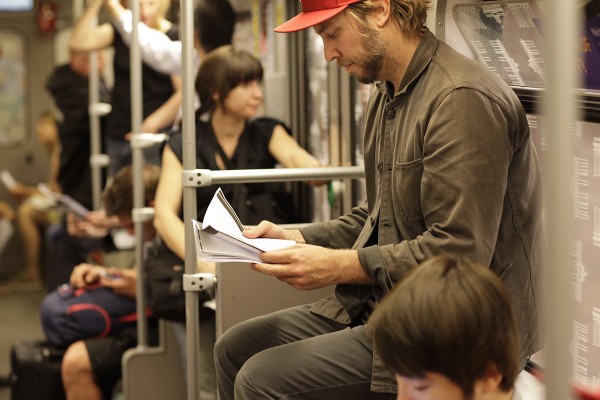
Performance Practices Marathon: Tag 1
Performance Practices Marathon: Day 1A workshop drift to forge food from 4 Berlin food markets with Sandra Teitge and Sarah Mewes of Dinner Exchange Berlin & food systems planner Lynn Peemoeller. Along the way a series of art walks led by Eric Ellingsen, Vladimir Miller, Ece Pazarbasi and Christina Werner.
Take a Stand Walk
Measure Walk
Performance Practices Marathon: Tag 1Ein Workshop mit Sandra Teitge und Sarah Mewes von Dinner Exchange Berlin & Lynn Peemoeller, der Sammeln von Lebensmitteln von vier Berliner Wochenmärkten und die Praxis des Driftens und das Format der "Walks" verbindet. Die Serie der Walks wird von Eric Ellingsen, Vladimir Miller, Ece Pazarbasi und Christina Werner geführt.
Take a Stand Walk
Measure Walk
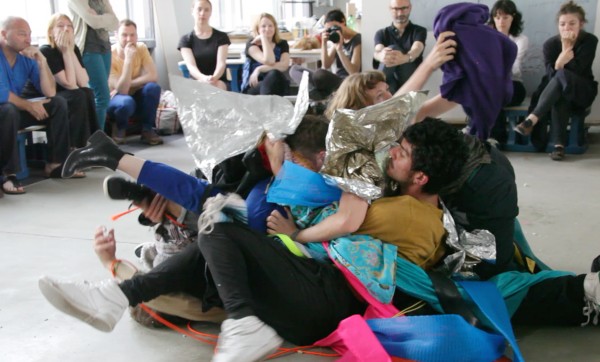
Performance Practices Marathon
PERFORMANCE PERFORMANCE PERFOAMNCE PERFORMANCE PERFORMANCE PERFORMANCE PERFORMANCE PERFORMANCE PERFORMANCE PERFORMANCE PERFORMANCE PEROFMRANCE PERFORMANCE PERFORMANCE PERFORMANCE PERFORAMNCE PERFORMANCE PERFORMACE PEROFRMACEN PEROFORMANCE PERFORMANCE PERFORMANCE PERFORAMCEN PERFOERMANCE PERFORMANCE PERFORMANCE PERFORAMCEN PERFORAMCEN PERFORMEANCE PERFORAMCEN PERFORAMANCE PEROFMRANCE PEROFMANCE PERFORAMANCE *
Contributions byEric Ellingsen, Christian Falsnaes, Kendell Geers, Hannah Hurtzig, Mathis Landwehr, Antje Majewski, Oliver Marchart, Bettina Masuch, Sarah Mewes, Vladimir Miller, Ece Pazarbasi, Lynn Peemoeller, Alexandra Pirici, Cia Rinne, Stephanie Rosenthal, Frédéric Seguette, Simon Starling, Meg Stuart, Sandra Teitge, Joanna Warsza, Christina Werner, Dana Yahalomi
In the 1530’s performance meant the carrying out of a promise. A thing acted out, played, done. Today performance means what? A way of qualifying everything from politics and social entanglements to technology (car engines, computers, drugs), environmental and structural systems to sustainability, something incubating in movement, from dance to theater to acting, to acting art, to singing, or action anything, poetry, on and on.
One thing we think performance means is a relationship to precision, to being precise. A tool for making things felt. Something that can be felt and feeling at the same time. We feel that performance is practiced and a practice, content and content production working of strangely attractive feedback loops from looking and listening to thought to action in which the action keeps thinking going keeping action going keeping thinking going on and on. Something that is generous in terms of audience co‐production. That performance is the relationship of imagination, feeling, thought, and beliefs materializing from one’s language as an artist.
PERFORMANCE PERFORMANCE PERFOAMNCE PERFORMANCE PERFORMANCE PERFORMANCE PERFORMANCE PERFORMANCE PERFORMANCE PERFORMANCE PERFORMANCE PEROFMRANCE PERFORMANCE PERFORMANCE PERFORMANCE PERFORAMNCE PERFORMANCE PERFORMACE PEROFRMACEN PEROFORMANCE PERFORMANCE PERFORMANCE PERFORAMCEN PERFOERMANCE PERFORMANCE PERFORMANCE PERFORAMCEN PERFORAMCEN PERFORMEANCE PERFORAMCEN PERFORAMANCE PEROFMRANCE PEROFMANCE PERFORAMANCE *
Beiträge vonEric Ellingsen, Christian Falsnaes, Kendell Geers, Hannah Hurtzig, Mathis Landwehr, Antje Majewski, Oliver Marchart, Bettina Masuch, Sarah Mewes, Vladimir Miller, Ece Pazarbasi, Lynn Peemoeller, Alexandra Pirici, Cia Rinne, Stephanie Rosenthal, Frédéric Seguette, Simon Starling, Meg Stuart, Sandra Teitge, Joanna Warsza, Christina Werner, Dana Yahalomi
In den 1530er Jahren bedeutete Performance, ein Versprechen einzulösen. Etwas darzustellen, zu spielen und zu tun. Was bedeutet Performance heute? Es ist eine Art Dinge näher zu bestimmen, auf die alles von Politik über soziale Verflechtungen bis hin zu Technologien (Automotoren, Computer, Medikamente), Umweltsystemen und nachhaltigen Strukturen in Bewegung zum Ausdruck gebracht werden kann. Alle Formen von Tanz über Theater, Schauspiel, darstellende Kunst bis hin zu jeglichen Formen von Aktion, Poesie und so weiter sind dabei möglich.
Eine der Eigenschaften, die wir Performance zuschreiben ist die einer besonderen Beziehung zu Präzision und zum präzise sein. Sie dient als Werkzeug, um Dinge fühlbar zu machen: Etwas das gefühlt werden kann und gleichzeitig Gefühl ist. Wir denken, dass Performance praktiziert wird und eine Praxis ist, Inhalt und Inhaltsproduktion ist, das Produkt seltsam attraktiver Rückkopplungsschleifen zwischen Schauen und Hören, Gedanken und Handlung ist. Diese Handlung wiederholt dann immer und immer wieder den Prozess des Denkens, Tuns, Aktivbleibens und wieder Denkens. Eine solche Art von Performance bedeutet die Beziehung zwischen Vorstellung, Gefühl, Denken und Glauben, die sich ausgehend von der Sprache eines jeden Künstlers darin materialisiert.
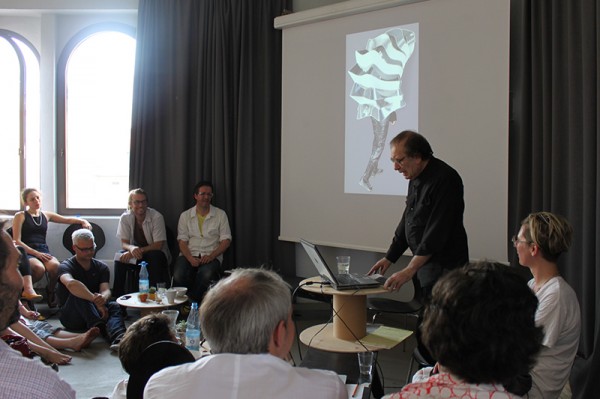
Space Activism Marathon, Tag 3
Contributions byVito Acconci, Monica Bonvicini, Francesca Ferguson, Olafur Eliasson & Eric Ellingsen & Christina Werner, Eve de Klerk, OSA (Office for Subversive Architecture), Tomas Saraceno, SMAQ (Sabine Müller and Andreas Quednau), Topotek 1 (Martin Rein-Cano).
OSA (Office for Subversive Architecture)
Eve de Klerk
Francesca Ferguson
Topotek 1 (Martin Rein-Cano)
Discussion with Eve de Klerk, Francesca Ferguson, Martin Rein-Cano, and OSA
SMAQ (Sabine Müller and Andreas Quednau)
Tomas Saraceno
Monica Bonvicini
Vito Acconci
Beiträge vonVito Acconci, Monica Bonvicini, Francesca Ferguson, Olafur Eliasson & Eric Ellingsen & Christina Werner, Mathias Heyden, Eve de Klerk, OSA (Office for Subversive Architecture), Tomas Saraceno, SMAQ (Sabine Müller and Andreas Quednau), Topotek 1 (Martin Rein-Cano).
OSA (Office for Subversive Architecture)
Eve de Klerk
Francesca Ferguson
Martin Rein-Cano
Diskussion mit Eve de Klerk, Francesca Ferguson, Martin Rein-Cano und OSA
SMAQ (Sabine Müller und Andreas Quednau)
Tomas Saraceno
Monica Bonvicini
Vito Acconci
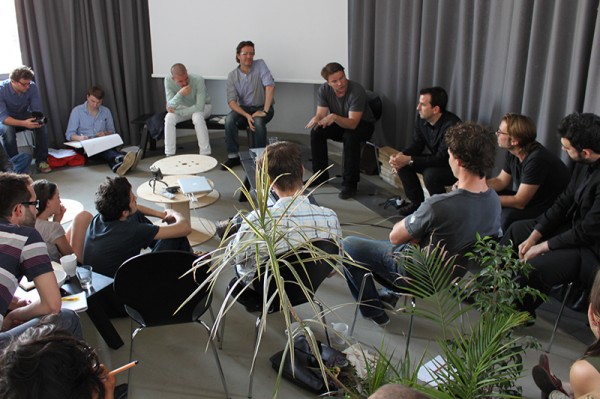
Space Activism Marathon, Day 2
Contributions byOlafur Eliasson & Eric Ellingsen & Christina Werner, Markus Miessen, Mathias Heyden, Bjarke Ingels, Achim Mengis, Robert Merk, François Roche, Anri Sala, Theo Spyropoulos.
Introduction by Olafur Eliasson and Eric Ellingsen
Markus Miessen
Achim Mengis
Bjarke Ingels
Robert Merk
conversation with Bjarke Ingels, Achim Mengis, Robert Merk and Markus Miessen
Anri Sala
Theo Spyropoulos
Mathias Heyden
Beiträge vonOlafur Eliasson & Eric Ellingsen & Christina Werner, Markus Miessen, Mathias Heyden, Bjarke Ingels, Achim Mengis, Robert Merk, François Roche, Anri Sala, Theo Spyropoulos.
Einführung von Olafur Eliasson und Eric Ellingsen
Markus Miessen
Achim Mengis
Bjarke Ingels
Robert Merk
Diskussion mit Bjarke Ingels, Achim Mengis, Robert Merk und Markus Miessen
Anri Sala
Theo Spyropoulos
Mathias Heyden
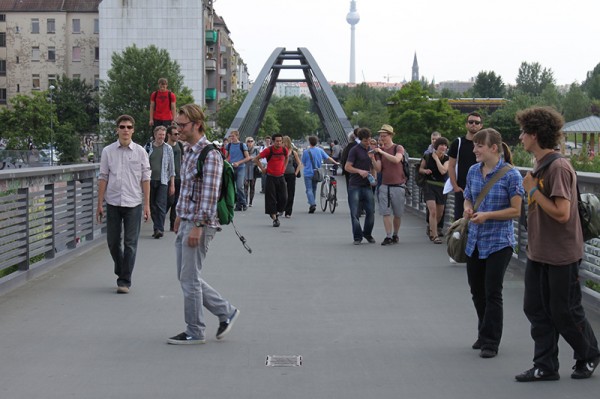
Space Activism Marathon, Tag 1
Walk from Institut für Raumexperimente, through Mauerpark, to Flakturm in Humboldthain; space and time marvelous movement experiments and interceptions along the way
Institute participants will be intercepted along the way by groups of people that move through space at alternative speeds and trajectories while seeing surfaces as strategies for an engagement: biking, climbing, skating, parkours, slack lining. At the same time we will talk about urbanism, preservation from a relational history of squatting and public space, speeds, and marvelous movements.
Raul Walch: Colour Bomb
Introduction by Eric Ellingsen
Mathias Heyden: squatter movement and urban development
Slackline in courtyard
Mathias Heyden: talk on Baugruppenprojekte
Mathias Heyden: talk on Brunnenviertel
Bmx & Parkour in courtyard
Slackline, Parkour and conversation inside abandoned building
Conversation at the playground
Slackline workshop
Timed Walk, on the bridge
Daniel Sprenger talks about graffiti in Berlin
Flakturm Hombuldthain
Exkursion vom Institut für Raumexperimente durch den Mauerpark zum Flakturm im Humboldthain; erstaunliche Experimente und Unterbrechungen in Zeit und Raum entlang des Weges
Die Teilnehmer des Institutes begegnen verschiedenen Gruppen entlang des Weges, die sich mit unterschiedlichen Geschwindigkeiten auf ihren Bahnen bewegen während sich ihnen Oberflächen jeweils als Strategien eines Engagements anbieten: Fahrradfahren, Klettern, Skateboarden, Parkours, Slacklining. Währenddessen werden wir Gespräche führen über Urbanismus, Geschichte und Aktualität alternativer öffentlicher Räume und der Hausbesetzungen, Geschwindigkeiten und erstaunliche Beweglichkeiten.
Raul Walch: Colour Bomb
Einführung von Eric Ellingsen
Mathias Heyden: Hausbesetzerszene und urbane Entwicklung
Slackline im Hof
Mathias Heyden: Baugruppenprojekte
Mathias Heyden: Brunnenviertel
Bmx & Parkour im Hof, Swinemünder Strasse
Slackline, Parkour und Gespräch in verlassenem Gebäude
Gespräch auf dem Spielplatz
Slackline workshop
Daniel Sprenger über Graffiti in Berlin
Timed Walk, auf der Brücke
Flakturm Hombuldthain
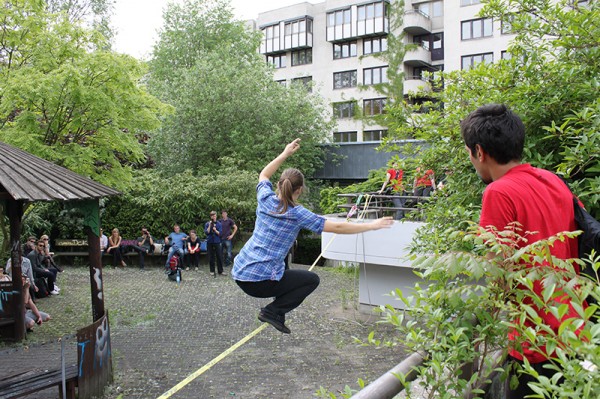
Space Activism Marathon
Contributions byVito Acconci, Monica Bonvicini, Olafur Eliasson & Eric Ellingsen & Christina Werner, Francesca Ferguson (Urban Drift Projects), Mathias Heyden, Bjarke Ingels, Eve de Klerk, Achim Mengis, Robert Merk, Markus Miessen, OSA (Office for Subversive Architecture), François Roche, Tomas Saraceno, SMAQ (Sabine Müller and Andreas Quednau), Theo Spyropoulos, Topotek 1 (Laura and Martin Rein-Cano).
Lunch and lunchtime experiments by Asako Iwama and Lauren Maurer. Flyer, design by Fredrik Skåtar: (PDF)
Space Activism Marathon, Tag 1Vito Acconci, Monica Bonvicini, Olafur Eliasson & Eric Ellingsen & Christina Werner, Francesca Ferguson (Urban Drift Projects), Mathias Heyden, Bjarke Ingels, Eve de Klerk, Achim Mengis, Robert Merk, Markus Miessen, OSA (Office for Subversive Architecture), François Roche, Tomas Saraceno, SMAQ (Sabine Müller and Andreas Quednau), Theo Spyropoulos, Topotek 1 (Laura and Martin Rein-Cano).
Mittagessen und Experimente von Asako Iwama und Lauren Maurer. Flyer, design von Fredrik Skåtar: (PDF)
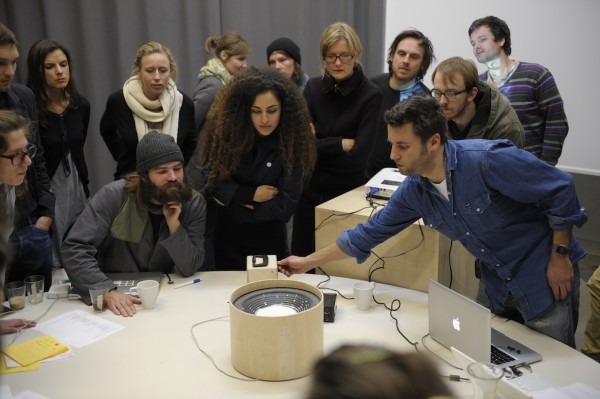
Artist Marathon, Tag 4
Contributions byJeroen Jacobs, Andreas Zybach, Elín Hansdóttir, Asmund Havsteen-Mikkelsen, Katinka Pilscheur, Matt Willard, Wolfgang Breuer
Jeroen Jacobs
Andreas Zybach
Elín Hansdóttir
Katinka Pilscheur
Matt Willard
Asmund Havsteen-Mikkelsen
Präsentationen vonJeroen Jacobs, Andreas Zybach, Elín Hansdóttir, Asmund Havsteen-Mikkelsen, Katinka Pilscheur, Matt Willard, Wolfgang Breuer
Jeroen Jacobs
Andreas Zybach
Elín Hansdóttir
Katinka Pilscheur
Matt Willard
Asmund Havsteen-Mikkelsen
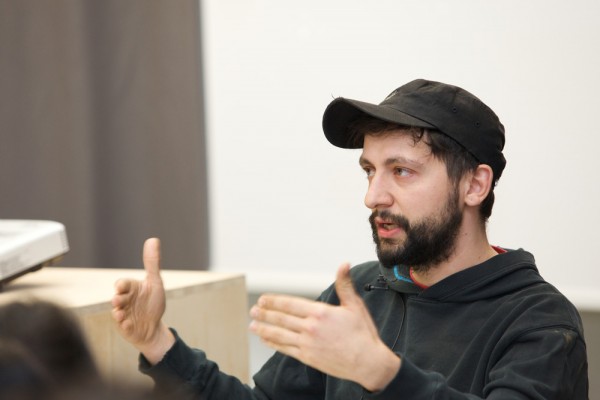
Artist Marathon, Tag 3
Contributions byAstrid Nippoldt, Deborah Ligorio, Felix Meyer, Yorgos Sapountzis, Beate Gütschow, Bojan Sarcevic, Andreas Bunte, Jay Chung & Q Takeki Maeda
Astrid Nippoldt
Deborah Ligorio
Felix Meyer
Yorgos Sapountzis
Beate Gütschow
Andreas Bunte
Bojan Sarcevic
Präsentationen vonAstrid Nippoldt, Deborah Ligorio, Felix Meyer, Yorgos Sapountzis, Beate Gütschow, Bojan Sarcevic, Andreas Bunte, Jay Chung & Q Takeki Maeda
Astrid Nippoldt
Deborah Ligorio
Felix Meyer
Yorgos Sapountzis
Beate Gütschow
Andreas Bunte
Bojan Sarcevic
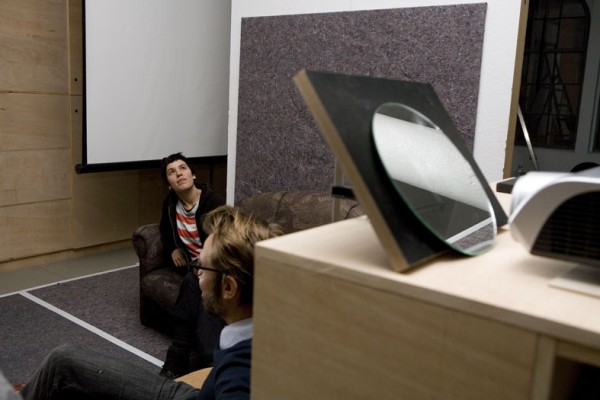
Artist Marathon, Tag 2
Contributions byUlf Aminde, Yves Mettler, Gianluca Malgeri, Kristleifur Björnsson, Susanne Winterling, Hanna Schwarz, Erik Bünger, Discoteca Flaming Star
Ulf Aminde
Yves Mettler
Gianluca Malgeri
Kristleifur Björnsson
Susanne Winterling
Hanna Schwarz
Erik Bünger
Discoteca Flaming Star
Beiträgen vonUlf Aminde, Yves Mettler, Gianluca Malgeri, Kristleifur Björnsson, Susanne Winterling, Hanna Schwarz, Erik Bünger, Discoteca Flaming Star
Ulf Aminde
Yves Mettler
Gianluca Malgeri
Kristleifur Björnsson
Susanne Winterling
Hanna Schwarz
Erik Bünger
Discoteca Flaming Star
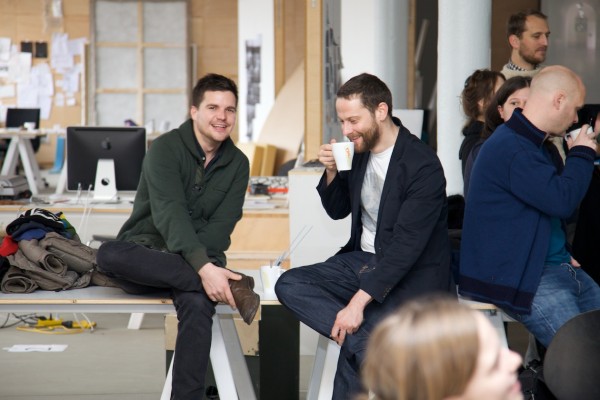
Artist Marathon, Tag 1
Contributions byMichael Sailstorfer, Knut Henrik Henriksen, Björn Dahlem, Jan Bünnig, Darri Lorenzen, Thilo Frank, Sylvia Henrich, Frederik Skåtar, Daniel Lergon
Michael Sailstorfer
Knut Henrik Henriksen
Björn Dahlem
Jan Bünnig
Darri Lorenzen
Thilo Frank
Sylvia Henrich
Frederik Skåtar
Daniel Lergon
Beiträge vonMichael Sailstorfer, Knut Henrik Henriksen, Björn Dahlem, Jan Bünnig, Darri Lorenzen, Thilo Frank, Sylvia Henrich, Frederik Skåtar, Daniel Lergon
Michael Sailstorfer
Knut Henrik Henriksen
Björn Dahlem
Jan Bünnig
Darri Lorenzen
Thilo Frank
Sylvia Henrich
Frederik Skåtar
Daniel Lergon
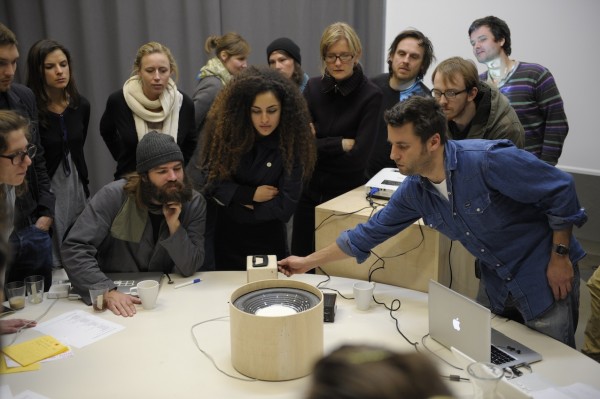
Artist Marathon
Contributions byUlf Aminde, Kristleifur Björnsson, Wolfgang Breuer, Erik Bünger, Jan Bünnig, Andreas Bunte, Jay Chung & Q Takeki Maeda, Björn Dahlem, Discoteca Flaming Star, Thilo Frank, Beate Gütschow, Elín Hansdóttir, Asmund Havsteen-Mikkelsen, Sylvia Henrich, Knut Henrik Henriksen, Jeroen Jacobs, Daniel Lergon, Deborah Ligorio, Darri Lorenzen, Gianluca Malgeri, Yves Mettler, Felix Meyer, Astrid Nippoldt, Katinka Pilscheur, Michael Sailstorfer, Yorgos Sapountzis, Bojan Sarcevic, Hanna Schwarz, Frederik Skåtar, Matt Willard, Susanne Winterling, Andreas Zybach
Lunchtime experiments by Asako Iwama and Lauren Maurer. Flyer: (PDF)
Beiträge vonUlf Aminde, Kristleifur Björnsson, Wolfgang Breuer, Erik Bünger, Jan Bünnig, Andreas Bunte, Jay Chung & Q Takeki Maeda, Björn Dahlem, Discoteca Flaming Star, Thilo Frank, Beate Gütschow, Elín Hansdóttir, Asmund Havsteen-Mikkelsen, Sylvia Henrich, Knut Henrik Henriksen, Jeroen Jacobs, Daniel Lergon, Deborah Ligorio, Darri Lorenzen, Gianluca Malgeri, Yves Mettler, Felix Meyer, Astrid Nippoldt, Katinka Pilscheur, Michael Sailstorfer, Yorgos Sapountzis, Bojan Sarcevic, Hanna Schwarz, Frederik Skåtar, Matt Willard, Susanne Winterling, Andreas Zybach
Speisen von Asako Iwama und Lauren Maurer. Flyer: (PDF)
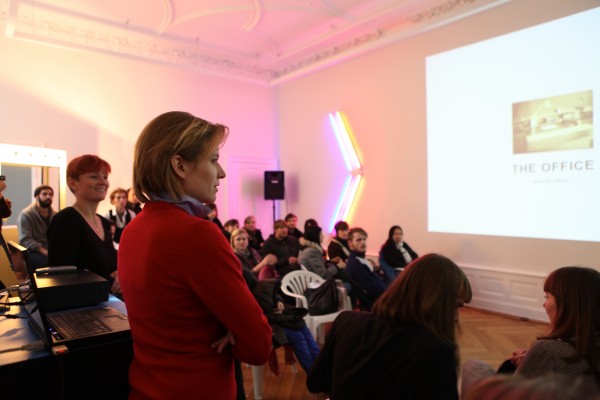
Curatorial Approach Marathon, Tag 1
Arrival & Welcome with Olafur Eliasson, Eric Ellingsen & Christina Werner
Hamburger Bahnhof: Carsten Höller: SomaWelcome and introduction by Udo Kittelmann
Udo Kittelmann
Haus der Kulturen der Welt: The Potosí PrincipleWelcome by Valerie Smith. Guided tour with Andreas Siekmann und Alice Creischer
Valerie Smith
Alice Creischer & Andreas Siekmann
Program e.V. – Initiative for Art and Architecture CollaborationsIntroduction by Carson Chan
Carson Chan
Salon PopulairePresentation by Ellen Blumenstein, "Salon Populaire". Presentation by Katharina Fichtner, "The Office"
Ellen Blumenstein & Katharina Fichtner
Studio Lukas FeireissPresentation by Lukas Feireiss
Lukas Feireiss, part 1
Lukas Feireiss, part 2
Begrüßung und Einführung von Olafur Eliasson, Eric Ellingsen & Christina Werner
Hamburger Bahnhof: Carsten Höller: SomaEinführung von Udo Kittelmann
Udo Kittelmann
Haus der Kulturen der Welt: The Potosí PrincipleBegrüßung von Valerie Smith. Führung mit Andreas Siekmann und Alice Creischer
Valerie Smith
Alice Creischer & Andreas Siekmann
Program e.V. – Initiative for Art and Architecture CollaborationsVortrag von Carson Chan
Carson Chan
Salon PopulaireVortrag von Ellen Blumenstein zu "Salon Populaire" und von Katharina Fichtner über "The Office"
Ellen Blumenstein & Katharina Fichtner
Studio Lukas FeireissPräsentation von Lukas Feireiss
Lukas Feireiss, Teil 1
Lukas Feireiss, Teil 2
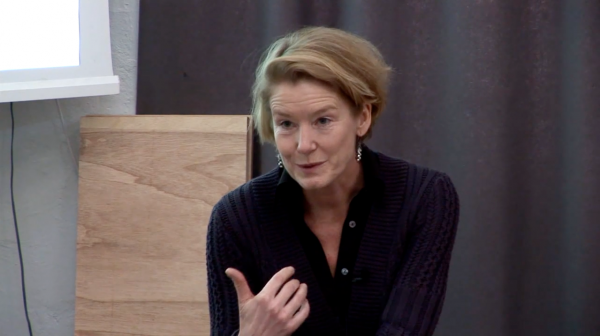
Curatorial Approach Marathon, Tag 3
Arrival & WelcomeIntroduction by Olafur Eliasson, Eric Ellingsen, Christina Werner
Introduction by Olafur Eliasson
Talks and Presentationsby Philipp Oswalt, Beatrice von Bismarck, Christoph Gurk, Artur Zmijewski, Jacob Fabricius, and Jakob Schillinger
Philipp Oswalt
watch talk by Beatrice von Bismarck
watch presentation by Christoph Gurk
Artur Zmijewski
Discussion with Beatrice von Bismarck, Philipp Oswalt, Christoph Gurk and Artur Zmijewski
Begrüßung und Einführungmit Olafur Eliasson, Eric Ellingsen, Christina Werner
Einführung von Olafur Eliasson
Vorträge und Gesprächevon Philipp Oswalt, Beatrice von Bismarck, Christoph Gurk, Artur Zmijewski, Jacob Fabricius und Jakob Schillinger
Philipp Oswalt
Beatrice von Bismarck
Christoph Gurk
Artur Zmijewski
Discussion mit Beatrice von Bismarck, Philipp Oswalt, Christoph Gurk und Artur Zmijewski
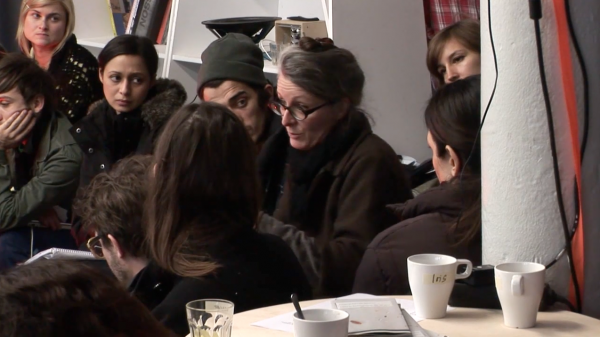
Curatorial Approach Marathon, Tag 2
Arrival & WelcomeIntroduction by Olafur Eliasson, Eric Ellingsen, Christina Werner
Introduction by Olafur Eliasson
Talks and Presentationsby Susanne Titz, Corinne Diserens, Gitte Ørskou, Nataša Ilic, Sanne Kofod Olsen, Dirck Möllmann, and Axel John Wieder
Susanne Titz
Nataša Ilic
presentation by Gitte Ørskou
discussion with Susanne Titz, Corinne Diserens, Gitte Ørskou, and Nataša Ilic
Sanne Kofod Olsen
presentation by Dirck Möllmann
Axel John Wieder, Part I
Axel John Wieder, Part II
Begrüßungvon Olafur Eliasson, Eric Ellingsen, Christina Werner
Einführung von Olafur Eliasson
Vorträge und Gesprächemit Susanne Titz, Corinne Diserens, Gitte Ørskou, Nataša Ilic, Sanne Kofod Olsen, Dirck Möllmann und Axel John Wieder
Susanne Titz
Nataša Ilic
Vortrag von Gitte Ørskou
Diskussion with Susanne Titz, Corinne Diserens, Gitte Ørskou und Nataša Ilic
Sanne Kofod Olsen
Vortrag von Dirck Möllmann
Axel John Wieder, Teil I
Axel John Wieder, Teil II
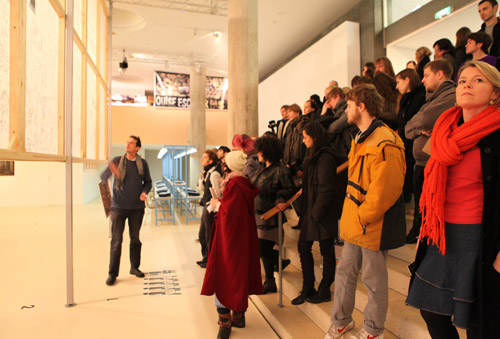
Curatorial Approach Marathon
Contributions byBeatrice von Bismarck, Ellen Blumenstein, Carson Chan, Corinne Diserens, Jacob Fabricius, Lukas Feireiss, Katharina Fichtner, Christoph Gurk, Nataša Ilic, Udo Kittelmann, Dirck Möllmann, Sanne Kofod Olsen, Gitte Ørskou, Philipp Oswalt, Jakob Schillinger, Andreas Siekmann und Alice Creischer, Valerie Smith, Susanne Titz, Axel John Wieder, Artur Zmijewski
Lunch and lunchtime experiments by Asako Iwama and Lauren Maurer. Flyer: (PDF)
Beiträge vonBeatrice von Bismarck, Ellen Blumenstein, Carson Chan, Corinne Diserens, Jacob Fabricius, Lukas Feireiss, Katharina Fichtner, Christoph Gurk, Nataša Ilic, Udo Kittelmann, Dirck Möllmann, Sanne Kofod Olsen, Gitte Ørskou, Philipp Oswalt, Jakob Schillinger, Andreas Siekmann und Alice Creischer, Valerie Smith, Susanne Titz, Axel John Wieder, Artur Zmijewski
Mittagessen und Experimente von Asako Iwama und Lauren Maurer. Flyer: (PDF)
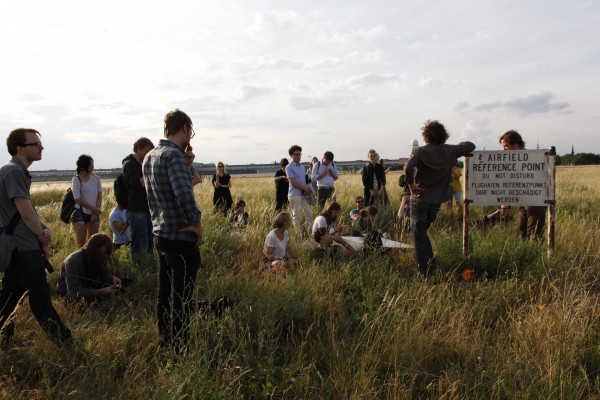
Day-Before-Life-is-Space Marathon
„Human beings are friends by nature – now it is called art what 12000 years ago was still serious play under the watchful eye of big mother“ (Otto E. Rössler)
with contributions by: Julius von Bismarck, Ute Meta Bauer, Merlin Carter, Elín Hansdóttir, Marie Köckenberger – Kjosk Berlin, Sanford Kwinter, Fotini Lazaridou-Hatzigoga, Molly Nesbit, Lynn Peemoeller, Prince / Tanzgruppe Streetdance Connection, Marco Clausen – Prinzessinnengärten, Matthias Rick, Christof Mayer and Benjamin Foerster-Baldenius – RaumLabor, Raul Walch.
View map
Institut für Raumexperimente / Studio Olafur Eliason
Introduction by Olafur Eliasson
See Walk
Subway
Sound Garden 1
Sound Garden 2
Blind Walk
Prinzessinnengarten / Moritzplatz
Marco Clausen, Prinzessinnengarten
Sanford Kwinter
Shoe Garden 1
Shoe Garden 2
Raul Walch
Streetdance Connection (Tanzgruppe SDC)
Kjosk / Oranienstrasse 1
Taste Experiment
Sound Garden 3
Tempelhof Park
Merlin Carter
Molly Nesbit
Julius von Bismarck
Raumlabor
Measure Walk
Elín Hansdóttir
SELECTED READING MATERIAL
Abbott, Edwin A., Flatland. A Romance of Many Dimensions, Dover 2007, S. 3–19.
Beauchamp, Gary, „Are Flavour Preferences Nature or Norture?“, in: Heston Blumenthal: The Fat Duck Cookbook, New York 2009, S. 467–468.
Blake, Tony, „In the Lab: The Science of Food at the Fat Duck“, in: Heston Blumenthal: The Fat Duck Cookbook, New York 2009, S. 462–465.
Böll, Heinrich, The End of a Mission, London 1974.
Edwards-Stuart, Rachel, „The Sense of Taste“, in: Heston Blumenthal: The Fat Duck Cookbook, New York 2009, S. 473–475.
Kriese, Wilfried und Otto Rössler,
Encouraging Lampsacus: The Internet as a Chance for a Multicultural Society of Minorities, Rottenburg 2010.
Lusseyran, Jacques, And There Was Light, New York 1999, S. 11–24.
Nagel, Thomas: „What is it Like to Be a But?“, in: The Philosophical Review, 83, 4, Durham 1974, S. 435–450.
Stein, Gertrude, Tender Buttons, New York 1999.
„Human beings are friends by nature – now it is called art what 12000 years ago was still serious play under the watchful eye of big mother“ (Otto E. Rössler)
mit Beiträgen von: Julius von Bismarck, Ute Meta Bauer, Merlin Carter, Elín Hansdóttir, Marie Köckenberger – Kjosk Berlin, Sanford Kwinter, Fotini Lazaridou-Hatzigoga, Molly Nesbit, Lynn Peemoeller, Prince / Tanzgruppe Streetdance Connection, Marco Clausen – Prinzessinnengärten, Matthias Rick, Christof Mayer und Benjamin Foerster-Baldenius – RaumLabor, Raul Walch.
Karte ansehen
Institut für Raumexperimente / Studio Olafur Eliason
Einführung von Olafur Eliasson
See Walk
U-bahn
Sound Garden 1
Sound Garden 2
Blind Walk
Prinzessinnengarten / Moritzplatz
Marco Clausen, Prinzessinnengarten
Sanford Kwinter
Shoe Garden 1
Shoe Garden 2
Raul Walch
Streetdance Connection (Tanzgruppe SDC)
Kjosk / Oranienstrasse 1
Taste Experiment
Sound Garden 3
Tempelhof Park
Merlin Carter
Molly Nesbit
Julius von Bismarck
Raumlabor
Measure Walk
Elín Hansdóttir
LITERATURAUSWAHL
Abbott, Edwin A., Flatland. A Romance of Many Dimensions, Dover 2007, S. 3–19.
Beauchamp, Gary, „Are Flavour Preferences Nature or Norture?“, in: Heston Blumenthal: The Fat Duck Cookbook, New York 2009, S. 467–468.
Blake, Tony, „In the Lab: The Science of Food at the Fat Duck“, in: Heston Blumenthal: The Fat Duck Cookbook, New York 2009, S. 462–465.
Böll, Heinrich, The End of a Mission, London 1974.
Edwards-Stuart, Rachel, „The Sense of Taste“, in: Heston Blumenthal: The Fat Duck Cookbook, New York 2009, S. 473–475.
Kriese, Wilfried und Otto Rössler,
Encouraging Lampsacus: The Internet as a Chance for a Multicultural Society of Minorities, Rottenburg 2010.
Lusseyran, Jacques, And There Was Light, New York 1999, S. 11–24.
Nagel, Thomas: „What is it Like to Be a But?“, in: The Philosophical Review, 83, 4, Durham 1974, S. 435–450.
Stein, Gertrude, Tender Buttons, New York 1999.
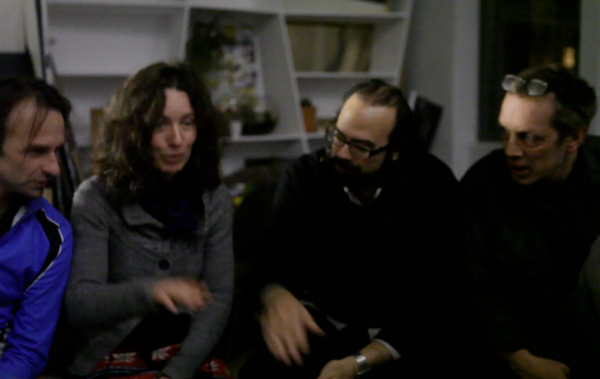
Sound Marathon, Teil II, Tag 2
With contributions byJan Werner & Matthias Engler, Katie Paterson & Stefano Greco, Kaffe Matthews, Ari Benjamin Meyers, Xavier Le Roy, Robert Lippok, Dani Gal & Steve Ellery and Jonathan Bepler
Introduction by Olafur Eliasson
Jan Werner & Matthias Engler
Kaffe Matthews
Ari Benjamin Meyers
Xavier Le Roy
Robert Lippok
Dani Gal and Steve Ellery
Jonathan Bepler
Sound InstallationsClara Jo, Markus Hoffmann, Hans-Henning Korb, Tiago Romagnani Silveira, Jan Werner, Euan Williams
Food Sound Eating ExperimentsAsako Iwama & Lauren Maurer & Lynn Peemoeller
Mit Beiträgen vonJan Werner & Matthias Engler, Katie Paterson & Stefano Greco, Kaffe Matthews, Ari Benjamin Meyers, Xavier Le Roy, Robert Lippok, Dani Gal & Steve Ellery and Jonathan Bepler
Einführung von Olafur Eliasson
Jan Werner & Matthias Engler
Kaffe Matthews
Ari Benjamin Meyers
Xavier Le Roy
Robert Lippok
Dani Gal and Steve Ellery
Jonathan Bepler
Sound InstallationsClara Jo, Markus Hoffmann, Hans-Henning Korb, Tiago Romagnani Silveira, Jan Werner, Euan Williams
Food Sound Eating ExperimentsAsako Iwama & Lauren Maurer & Lynn Peemoeller
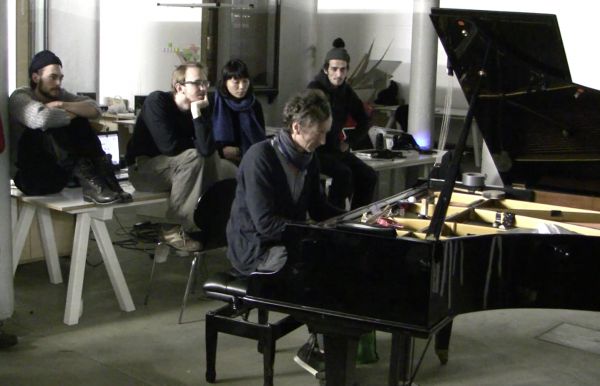
Sound Marathon, Teil II, Tag 1
Introduction by Olafur Eliasson and Hildur Guðnadóttir
With contributions byPerry Hall, Uwe Westphal, Ida Momennejad, Miroslav Großer, Eric Ellingsen, Takehito Koganezawa, and Hauschka
Lecture by Uwe Westphal
First part of lecture by Ida Momennejad
Second part of lecture by Ida Momennejad
Wind Poem by Eric Ellingsen
Lecture on overtone singing by Miroslav Großer
Performance by Takehito Koganezawa
Performance and talk by Hauschka
Sound InstallationsClara Jo, Markus Hoffmann, Hans-Henning Korb, Tiago Romagnani Silveira, Jan Werner, Euan Williams
Food Sound Eating ExperimentsAsako Iwama & Lauren Maurer & Lynn Peemoeller
Einführung von Olafur Eliasson und Hildur Guðnadóttir
Mit Beiträgen vonPerry Hall, Uwe Westphal, Ida Momennejad, Miroslav Großer, Eric Ellingsen, Takehito Koganezawa und Hauschka
Erster Teil des Vortrags von Ida Momennejad
Zweiter Teil des Vortrags von Ida Momennejad
Vortrag von Miroslav Großer
Performance by Takehito Koganezawa
Performance von Hauschka
Sound InstallationsClara Jo, Markus Hoffmann, Hans-Henning Korb, Tiago Romagnani Silveira, Jan Werner, Euan Williams
Food Sound Eating ExperimentsAsako Iwama & Lauren Maurer & Lynn Peemoeller
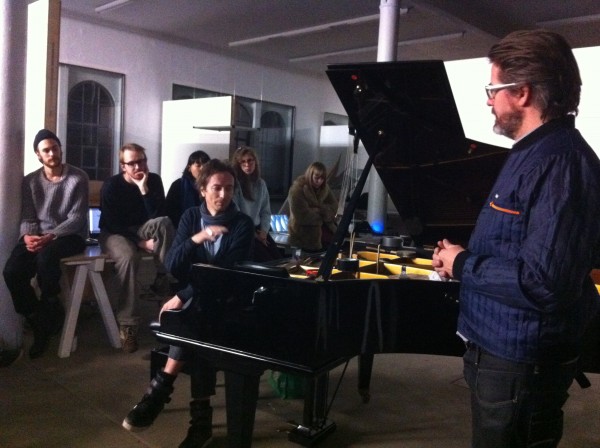
Sound Marathon, Teil II
Contributions byJonathan Bepler, Steve Ellery, Matthias Engler, Dani Gal, Stefano Greco, Miroslav Großer, Perry Hall, Hauschka, Takehito Koganezawa, Robert Lippok, Kaffe Matthews, Ari Benjamin Meyers, Ida Momennejad, Katie Paterson, Xavier Le Roy, Jan Werner, Uwe Westphal
Beiträge vonJonathan Bepler, Steve Ellery, Matthias Engler, Dani Gal, Stefano Greco, Miroslav Großer, Perry Hall, Hauschka, Takehito Koganezawa, Robert Lippok, Kaffe Matthews, Ari Benjamin Meyers, Ida Momennejad, Katie Paterson, Xavier Le Roy, Jan Werner, Uwe Westphal
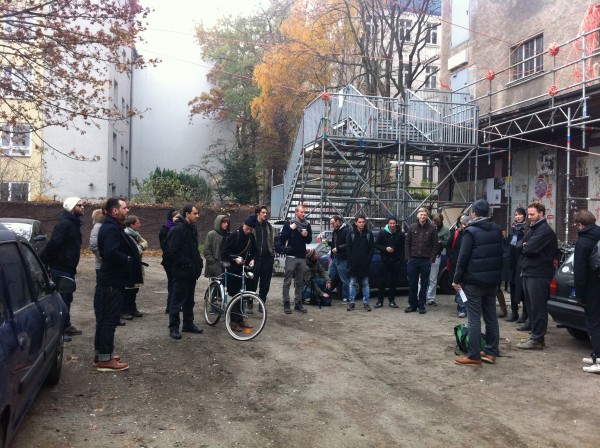
Sound Marathon, Teil I, Tag 1
Meet at SILO #1:Cuvrystr. 3-4, 10997 Berlin-Kreuzberg
Exhibition space talk with Lutz Henke
Sound walk and talk with Heimo Lattner
C Poem by Eric Ellingsen
Meet at SILO #2:Großer Wasserspeicher - Entrance on Belforter Straße
Talk with Carsten Seiffarth
Sound experiments with Sam Auinger
Sound poem by Eric Ellingsen
Sound experiment ground floor: Felix Kiessling
Roof sound experiments with Jan Werner
Sound walk experiment with Eric Ellingsen & Christina Werner & Jeremias Holliger
Sound installations: Clara Jo, Markus Hoffmann, Hans-Henning Korb, Tiago Romagnani Silveira, Jan Werner, Euan Williams
Food sound eating experiments: Asako Iwama & Lauren Maurer & Lynn Peemoeller
Besuch im SILO #1:Cuvrystr. 3-4, 10997 Berlin-Kreuzberg
Gespräch mit Lutz Henke
Spaziergang Geräuschen entlang mit Heimo Lattner
C Poem von Eric Ellingsen
Besuch im SILO #2:Großer Wasserspeicher - Eingang Belforter Straße
Gespräch mit Carsten Seiffarth
Gespräch und Klangexperimente mit Sam Auinger
Klanggedicht von Eric Ellingsen
Klangexperiment im Erdgeschoss: Felix Kiessling
Klangexperiment auf dem Dach mit Jan Werner
Sound walk experiment mit Eric Ellingsen & Christina Werner & Jeremias Holliger
Klanginstallationen: Clara Jo, Markus Hoffmann, Hans-Henning Korb, Tiago Romagnani Silveira, Jan Werner, Euan Williams
Experimente mit Essen und Geräuschen: Asako Iwama & Lauren Maurer & Lynn Peemoeller
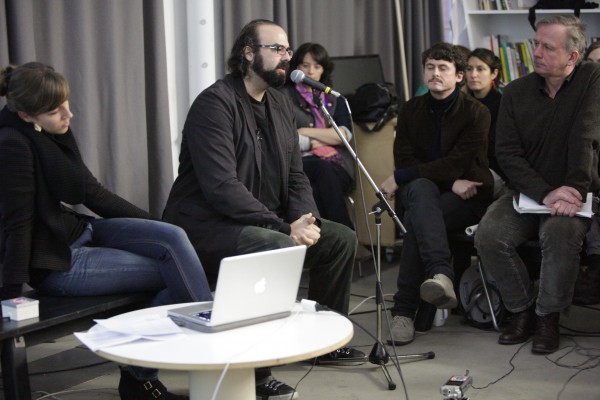
Sound Marathon, Teil I, Tag 3
Contributions bySam Auinger, Sophie Erlund, Christoph Gurk, Hildur Guðnadóttir, Heimo Lattner, Yutaka Makino, Clara Meister & Ari Benjamin Meyers & Thomas Mayer, Katie Paterson, Egill Sæbjörnsson, Jan Werner and Stephan Streich
Introduction by Olafur Eliasson, Eric Ellingsen, & Christina Werner
Hildur Guðnadóttir
Derek Holzer
Christoph Gurk
Clara Meister & Ari Benjamin Meyers & Thomas Mayer
Heimo Lattner
Sophie Erlund
Jan Werner and Stephan Streich
Sam Auinger
Egill Sæbjörnsson
Sound experiment ground floor: Felix Kiessling
Roof sound experiments with Jan Werner
Sound walk experiment with Eric Ellingsen & Christina Werner & Jeremias Holliger
Sound installations: Clara Jo, Markus Hoffmann, Hans-Henning Korb, Tiago Romagnani Silveira, Jan Werner, Euan Williams
Food sound eating experiments: Asako Iwama & Lauren Maurer & Lynn Peemoeller
Mit Beiträgen vonSam Auinger, Sophie Erlund, Christoph Gurk, Hildur Guðnadóttir, Heimo Lattner, Yutaka Makino, Clara Meister & Ari Benjamin Meyers & Thomas Mayer, Katie Paterson, Egill Sæbjörnsson, Jan Werner und Stephan Streich
Einführung von Olafur Eliasson, Eric Ellingsen, & Christina Werner
Hildur Guðnadóttir
Derek Holzer
Christoph Gurk
Clara Meister & Ari Benjamin Meyers & Thomas Mayer
Heimo Lattner
Sophie Erlund
Jan Werner und Stephan Streich
Sam Auinger
Egill Sæbjörnsson
Klangexperiment im Erdgeschoss: Felix Kiessling
Klangexperiment auf dem Dach mit Jan Werner
Sound walk experiment mit Eric Ellingsen & Christina Werner & Jeremias Holliger
Klanginstallationen: Clara Jo, Markus Hoffmann, Hans-Henning Korb, Tiago Romagnani Silveira, Jan Werner, Euan Williams
Experimente mit Essen und Geräuschen: Asako Iwama & Lauren Maurer & Lynn Peemoeller
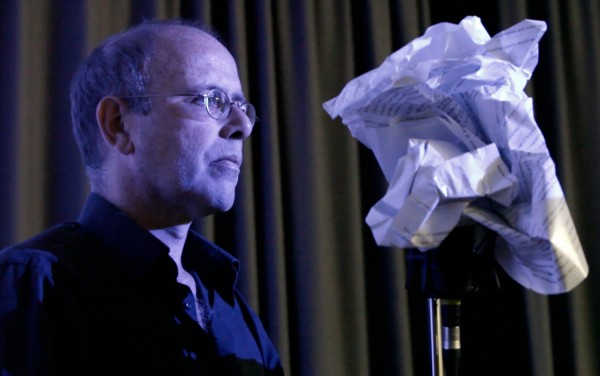
Sound Marathon, Teil I, Tag 2
Contributions byJaap Blonk, Olafur Eliasson & Matt Willard & Hans Johannsson, Bahar Gholipour, Derek Holzer & Carsten Stabenow, Hans Johannsson, Samuli Kosminen & KIRA KIRA, Arto Lindsay & Letizia Monea, Marcellvs L., Halldór Úlfarsson & Christian Zöllner
Introduction by Olafur Eliasson, Eric Ellingsen, Christina Werner
Samuli Kosminen & KIRA KIRA
Halldór Úlfarsson & Christian Zöllner
Hans Johannsson
Olafur Eliasson & Matt Willard & Hans Johannsson
Bahar Gholipour
Arto Lindsay & Letizia Monea
Marcellvs L.
Jaap Blonk
Sound experiment ground floor: Felix Kiessling
Roof sound experiments with Jan Werner
Sound walk experiment with Eric Ellingsen & Christina Werner & Jeremias Holliger
Sound installations: Clara Jo, Markus Hoffmann, Hans-Henning Korb, Tiago Romagnani Silveira, Jan Werner, Euan Williams
Food sound eating experiments: Asako Iwama & Lauren Maurer & Lynn Peemoeller
Mit Beiträgen vonJaap Blonk, Olafur Eliasson & Matt Willard & Hans Johannsson, Bahar Gholipour, Derek Holzer & Carsten Stabenow, Hans Johannsson, Samuli Kosminen & KIRA KIRA, Arto Lindsay & Letizia Monea, Marcellvs L., Halldór Úlfarsson & Christian Zöllner
Einführung von Olafur Eliasson, Eric Ellingsen, Christina Werner
Samuli Kosminen & KIRA KIRA
Halldór Úlfarsson & Christian Zöllner
Hans Johannsson
Olafur Eliasson & Matt Willard & Hans Johannsson
Bahar Gholipour
Arto Lindsay & Letizia Monea
Marcellvs L.
Jaap Blonk
Klangexperiment im Erdgeschoss: Felix Kiessling
Klangexperiment auf dem Dach mit Jan Werner
Sound walk Experiment mit Eric Ellingsen & Christina Werner & Jeremias Holliger
Klanginstallationen: Clara Jo, Markus Hoffmann, Hans-Henning Korb, Tiago Romagnani Silveira, Jan Werner, Euan Williams
Experimente mit Essen und Geräuschen: Asako Iwama & Lauren Maurer & Lynn Peemoeller
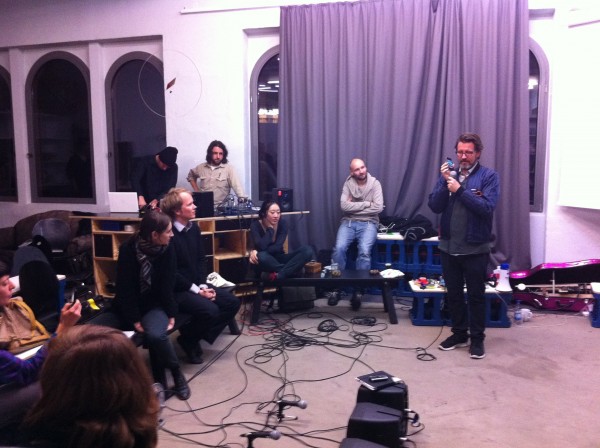
Sound Marathon, Teil I
Contributions bySam Auinger, Jaap Blonk, Olafur Eliasson & Matt Willard & Hans Johannsson, Eric Ellingsen, Sophie Erlund, Bahar Gholipour, Christoph Gurk, Hildur Guðnadóttir, Lutz Henke, Derek Holzer & Carsten Stabenow, Hans Johannsson, Samuli Kosminen & KIRA KIRA, Heimo Lattner, Arto Lindsay & Letizia Monea, Yutaka Makino, Marcellvs L., Clara Meister & Ari Benjamin Meyers & Thomas Mayer, Katie Paterson, Carsten Seiffarth, Egill Sæbjörnsson, Halldór Úlfarsson & Christian Zöllner, Jan Werner and Stephan Streich
Beiträge vonSam Auinger, Jaap Blonk, Olafur Eliasson & Matt Willard & Hans Johannsson, Eric Ellingsen, Sophie Erlund, Bahar Gholipour, Christoph Gurk, Hildur Guðnadóttir, Lutz Henke, Derek Holzer & Carsten Stabenow, Hans Johannsson, Samuli Kosminen & KIRA KIRA, Heimo Lattner, Arto Lindsay & Letizia Monea, Yutaka Makino, Marcellvs L., Clara Meister & Ari Benjamin Meyers & Thomas Mayer, Katie Paterson, Carsten Seiffarth, Egill Sæbjörnsson, Halldór Úlfarsson & Christian Zöllner, Jan Werner and Stephan Streich
